THE BACON CROWDER GARDEN: BEFORE AND AFTER
I will be forever grateful to Mary Bacon and John Crowder, who almost 20 years ago engaged this green (and I mean inexperienced, NOT environmentally savvy) landscape designer to work with them on their charming stone cottage, one of four Ernest Flagg designed houses in the neighborhood. Out of our 18 year collaboration came three major phases of garden transformation and an enduring friendship.
When Mary and John moved into the cottage, what would become their front entrance was hidden by overgrown boxwood (some taller than the doorway) and HVAC units. The footprint of the house was U shaped, and the door was in the center.
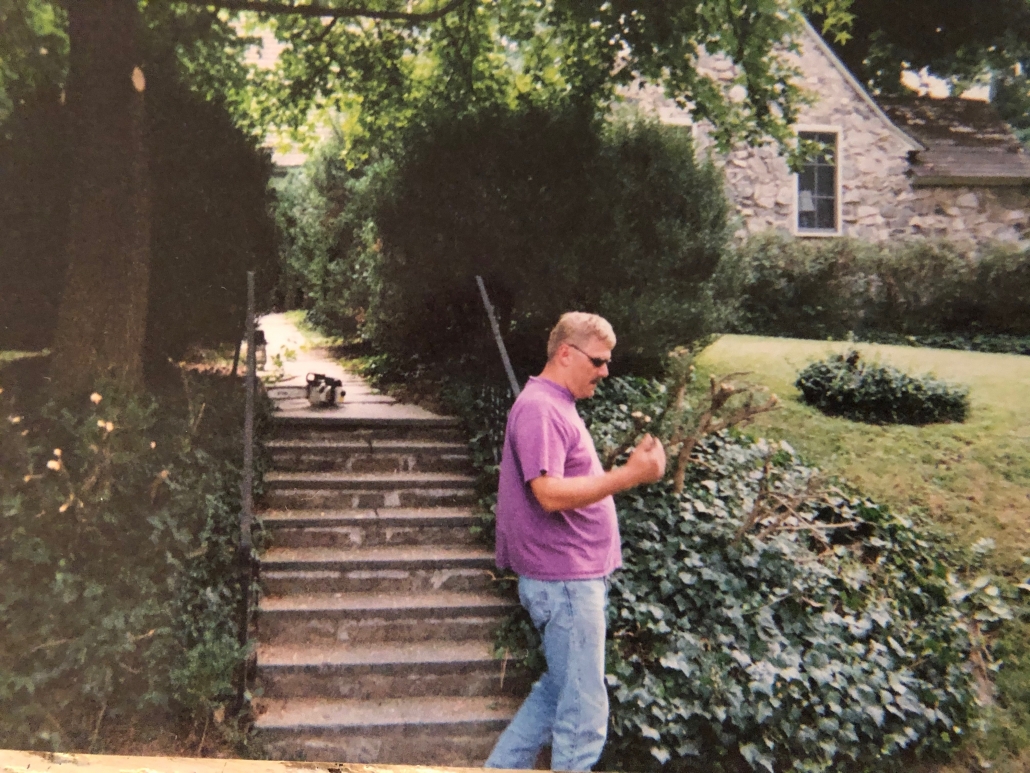
A mystery man walks by the cottage just before the removal of the boxwood.
Mary and John wasted no time making the bold move of ripping out the boxwood. They also relocated the HVAC units, exposing the charming facade for the first time in years.
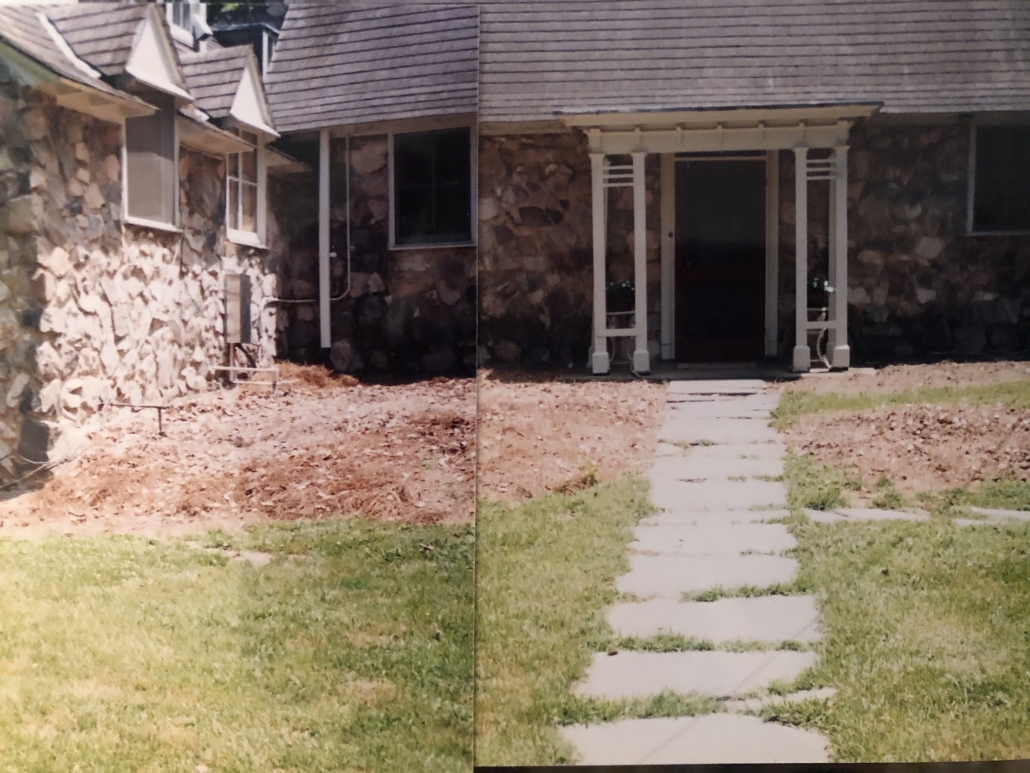
We created a courtyard, reusing the slate to create a small entrance terrace with generous steps, and softening it with plants.
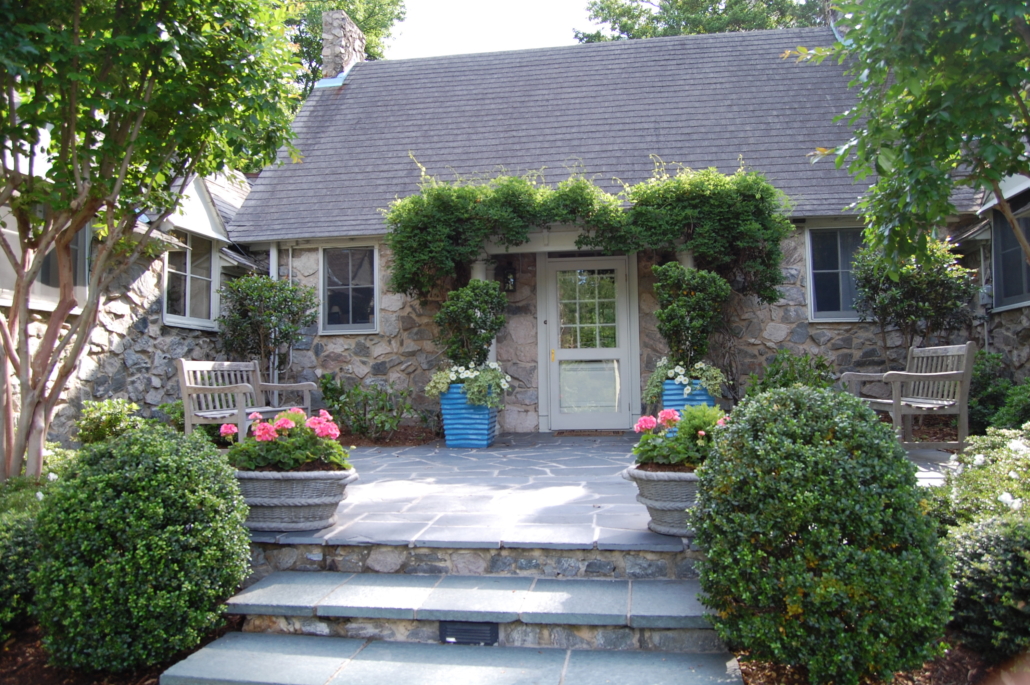
Boxwood, gardenia, crapemyrtle, pieris and camellia fill the planting beds. Akebia frames the doorway.
Next, we tackled the south side of the property. Note the boxwood swallowing the lovely side porch landing. We had many animated debates about whether to sacrifice or save the long-time resident, and in the end, decided to keep it and limb it up — marriage saved!
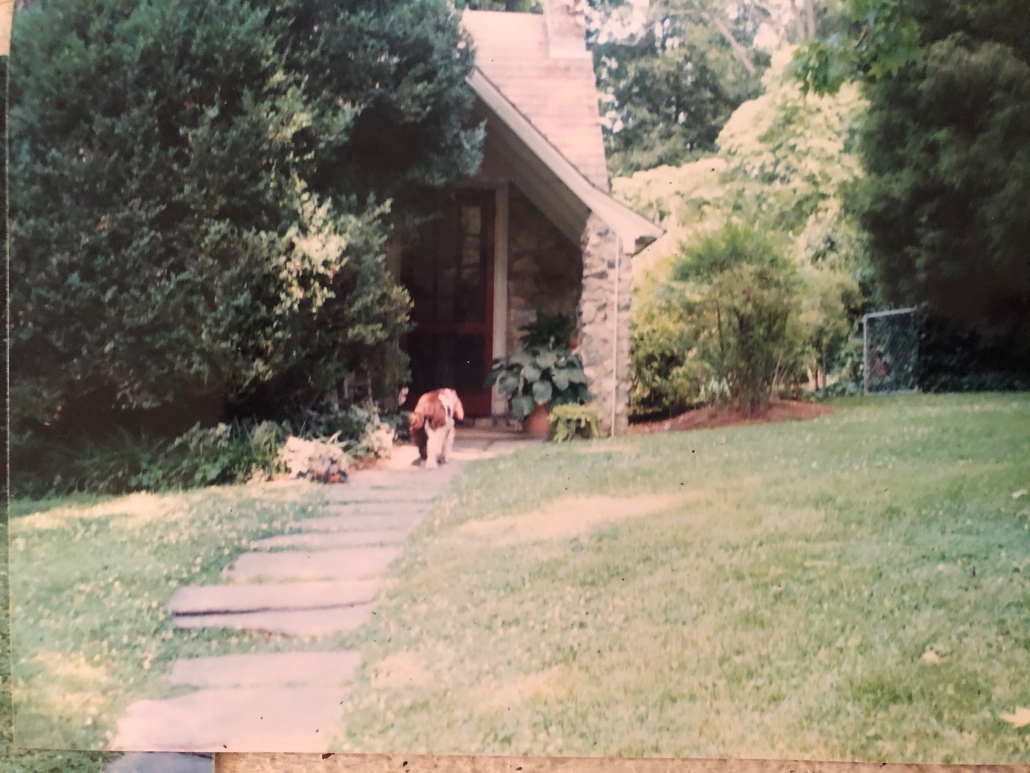
We installed large stone steps from the driveway to the south entrance, now visible through the limbed up boxwood.
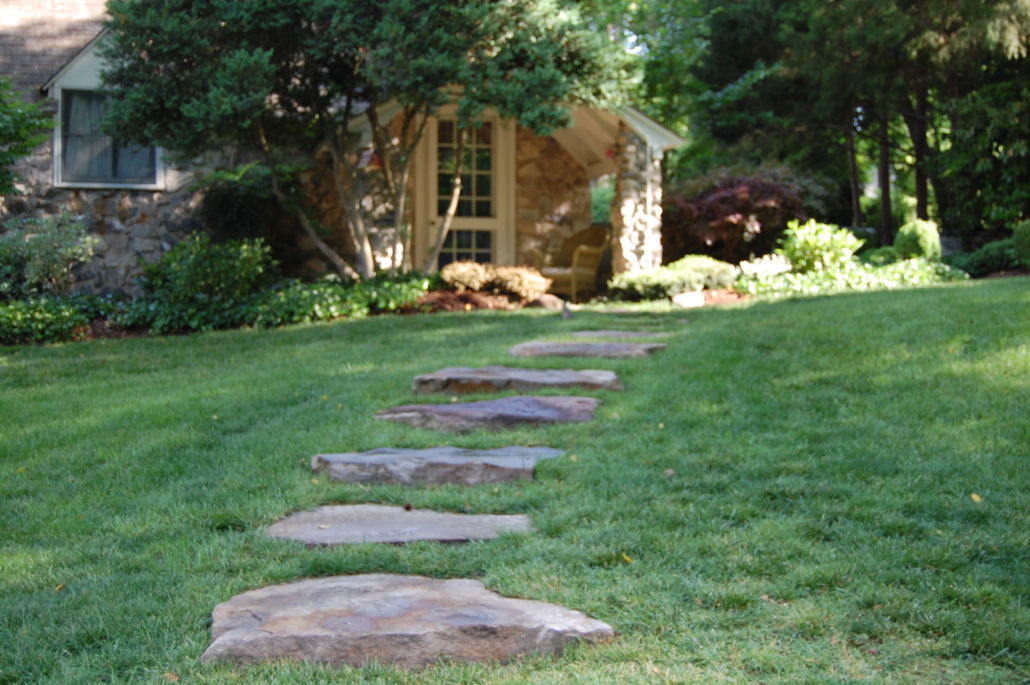
Photograph by Helen Horsley
The backyard, choked with weeds, sloped toward the house, creating drainage issues, and limiting the usable space in an already shallow backyard (about 20 feet).
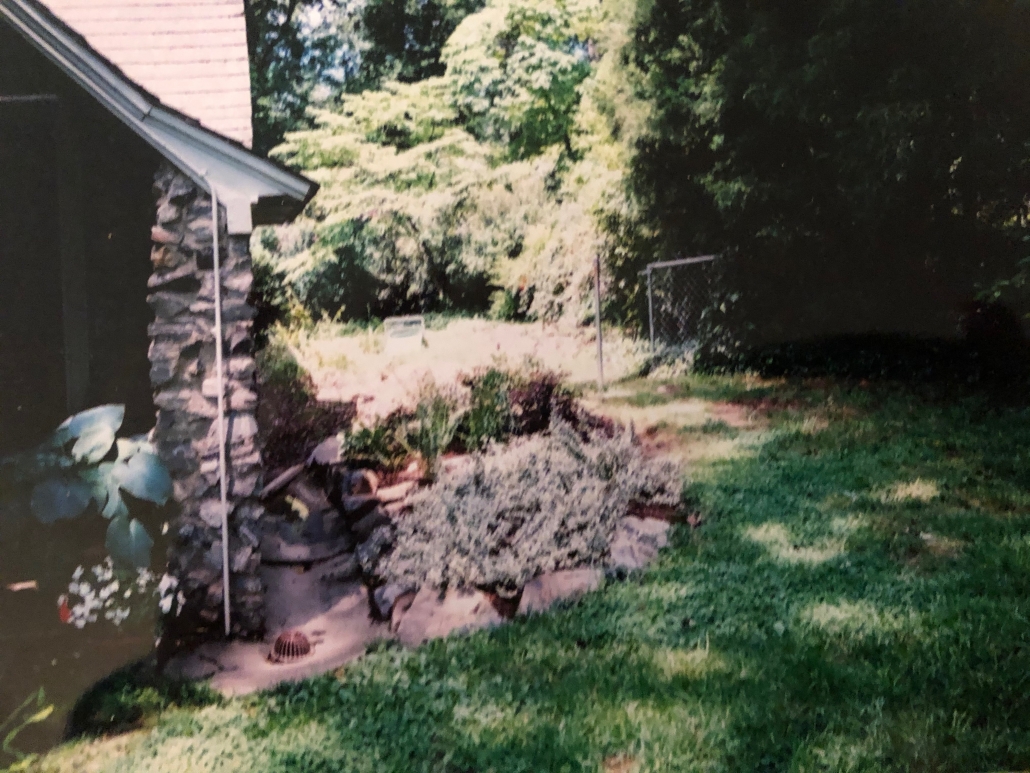
Looking north across the east border of the property, prior to construction
We needed to accomplish a lot in that narrow space — screen for privacy and create a welcome gathering space for gilling, dining and relaxing. To meet our goals, we excavated the slope and built a series of retaining walls, easing the drainage, creating level space, and allowing for an intimate terrace. As we did with the front terrace, we created pockets of garden beds between the house and terrace for plantings to set off the beautiful stone of the house.
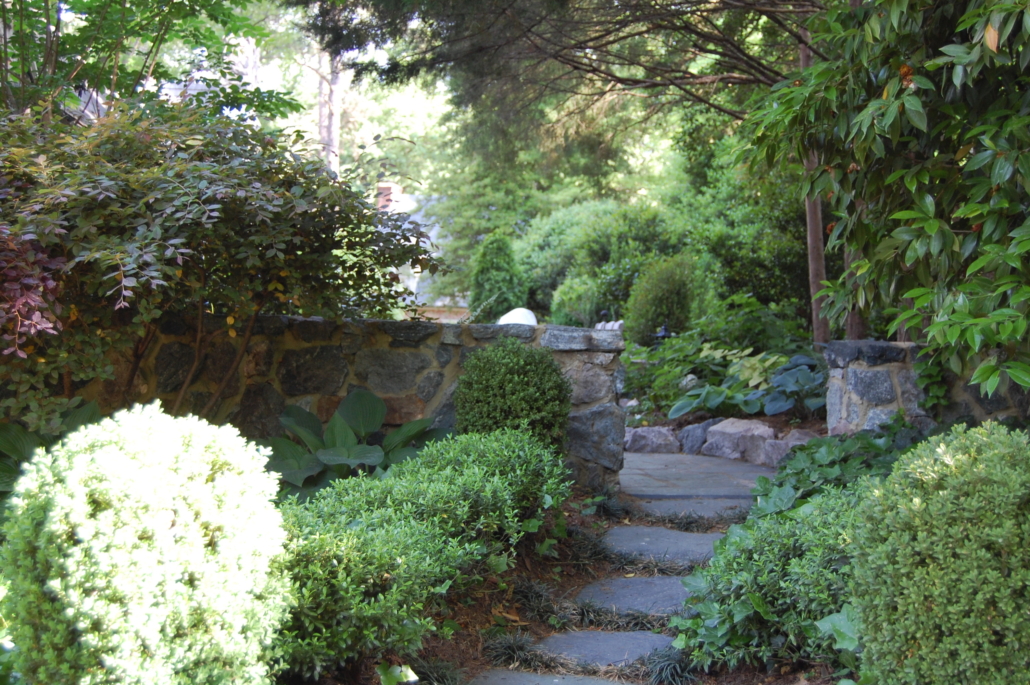
We engaged a mason who understood the importance of using materials and techniques complementary to the existing architecture. David Aldridge was an extremely talented mason — Jamaica born, a former accountant (we shared the dream of leaving white collar jobs to work in the great outdoors). David worked closely with John to match the stone walls to the house, handpicking each stone he used. Photograph by Helen Horsley.
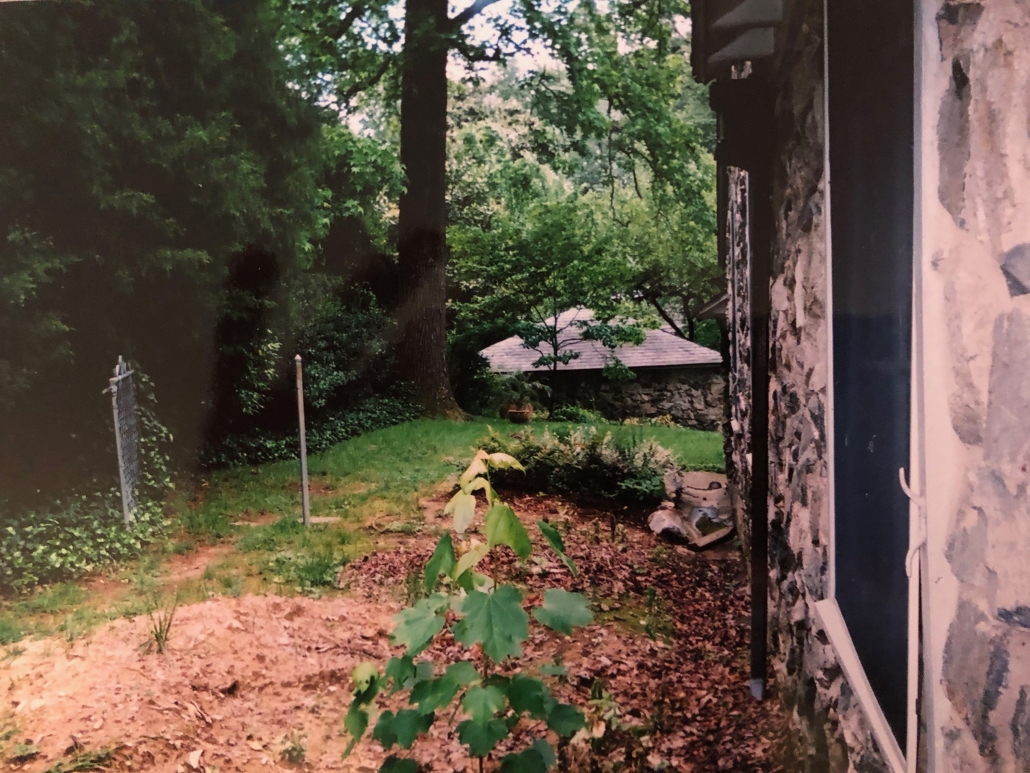
Looking south toward a forlorn chain link gate and post, and toward the garage beyond
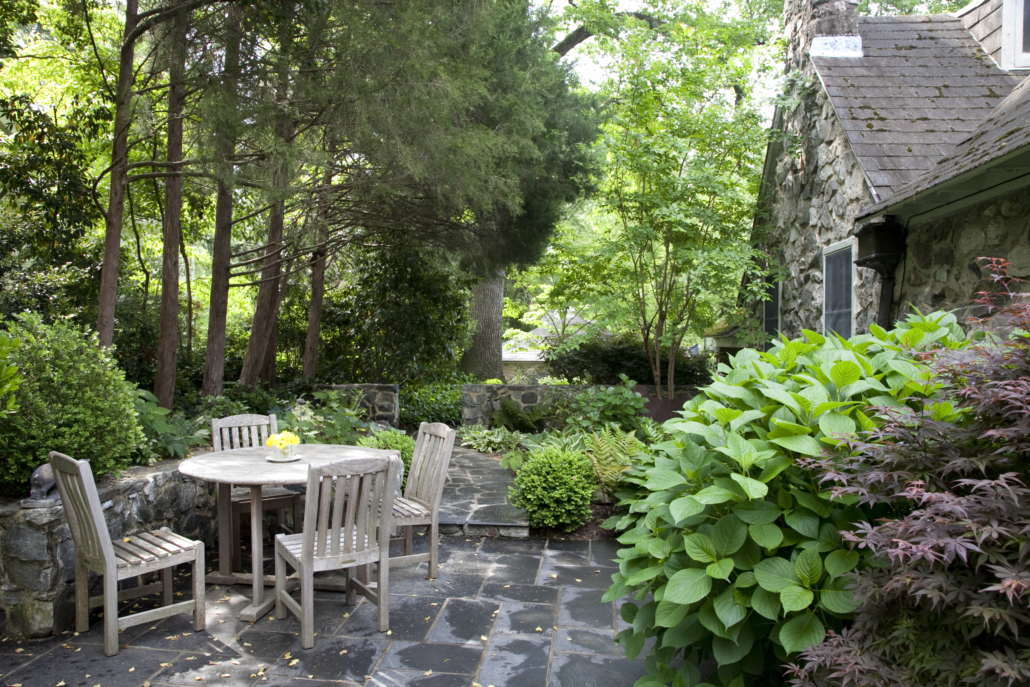
The terrace, post-construction. Photograph by Helen Horsley.
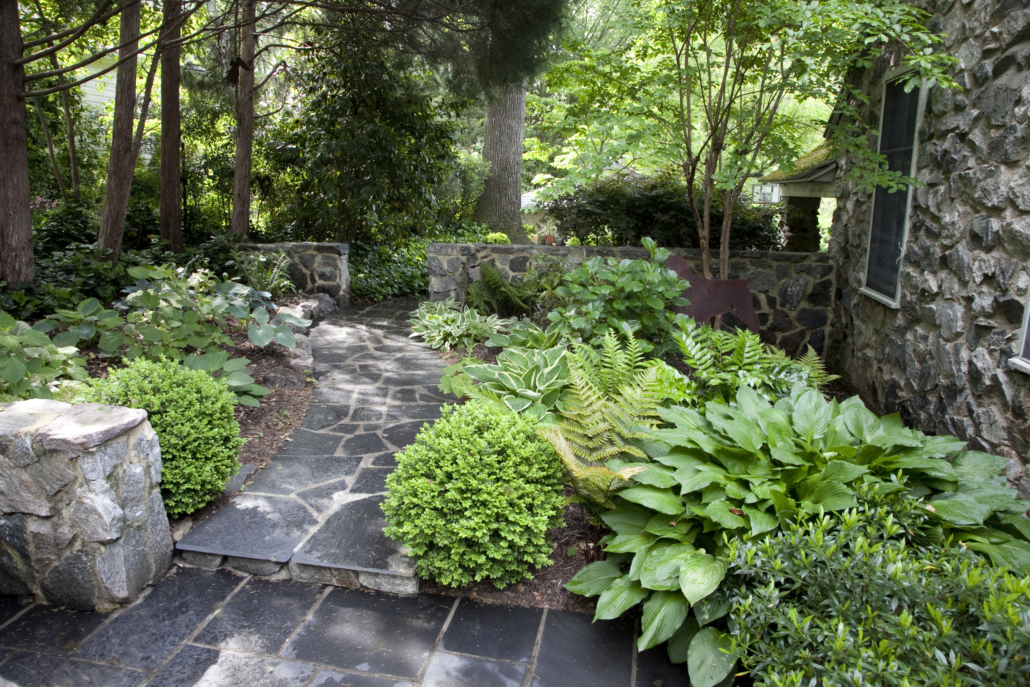
The woodland path, post-construction. Photograph by Helen Horsley.
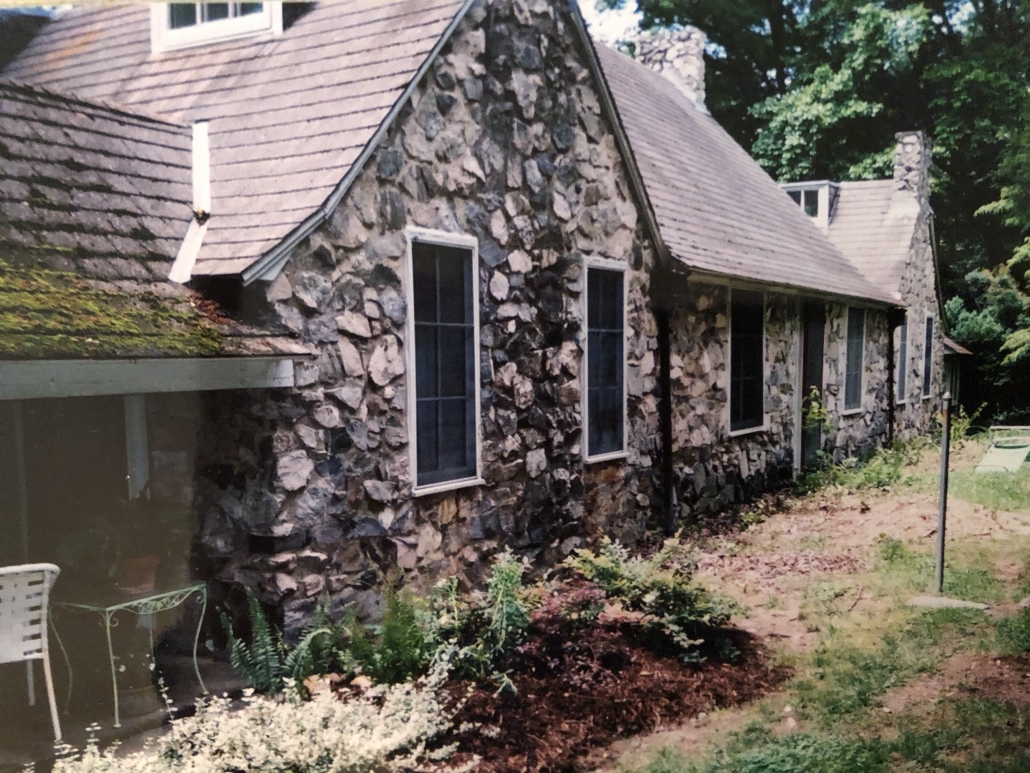
The back facade, pre-construction
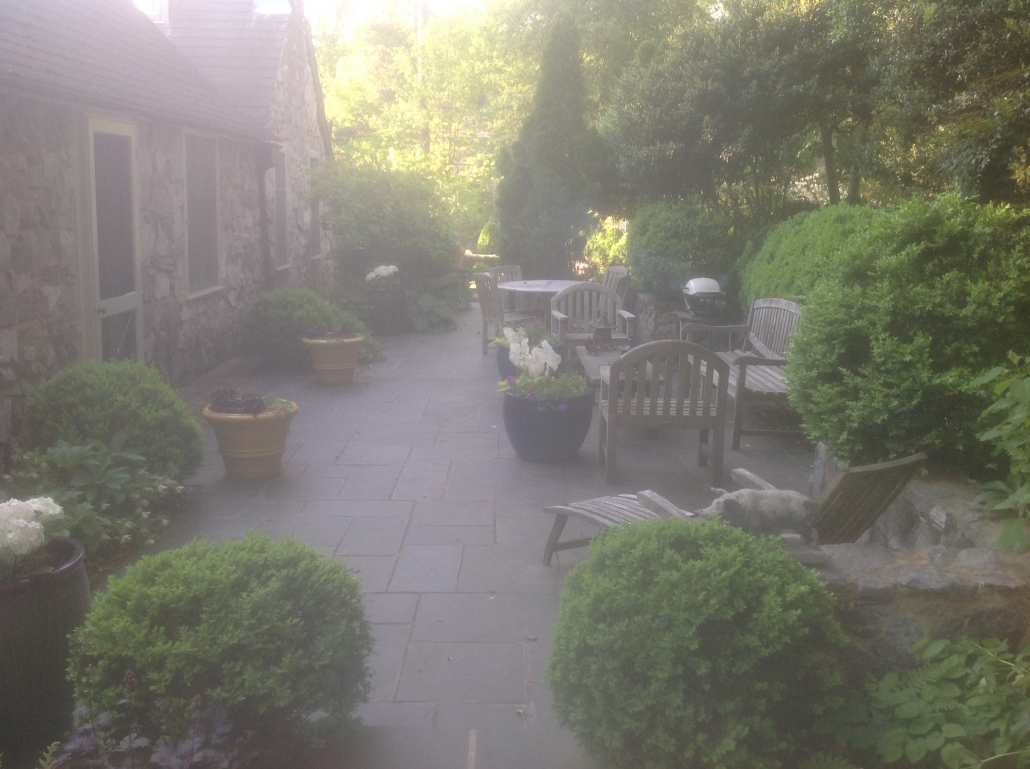
A recent sunrise photo of the terrace by John
Mary and John, with their newborn daughter Cabell, settled into the cozy stone cottage, but 8 years later they were ready to expand the footprint a bit. Sensitive once again to ensuring a seamless transition in keeping with the Flagg design, Mary and John worked with 3north for the design of the addition. I was tasked with continuing that transition in the garden.
Mary and John have been good stewards of this special Flagg stone cottage. Ernest Flagg wrote:
The most perfectly constructed object in nature, and also the most beautiful object in nature, is the human form as it approaches perfection. This, then, is the criterion of construction as it is of design. The study of its beauties is the veritable key to art… In the human form, as nature tries to make it, every feature is useful and every feature is beautiful. Each member is perfectly adapted to the function it has to perform; nothing is superfluous, yet the whole and every part is supremely decorative.
The Bacon/Crowders have not only embraced the Flagg design philosophy, they engaged, from the start, designers and craftsmen who practice with the same sensibility.
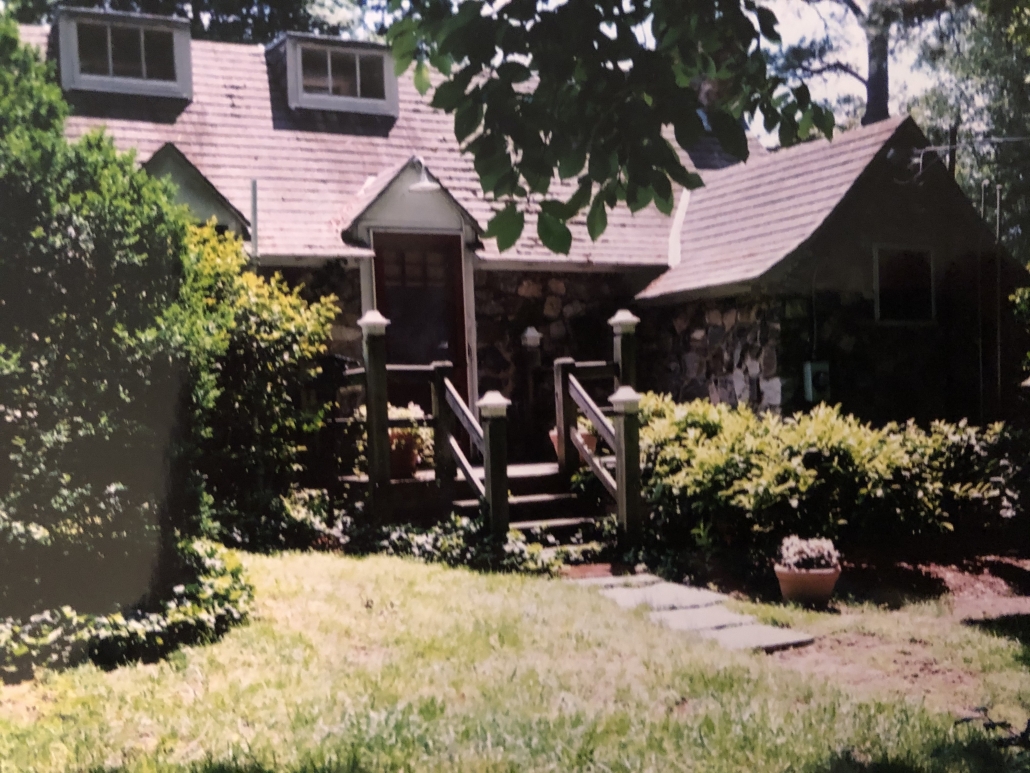
The north facade prior to construction
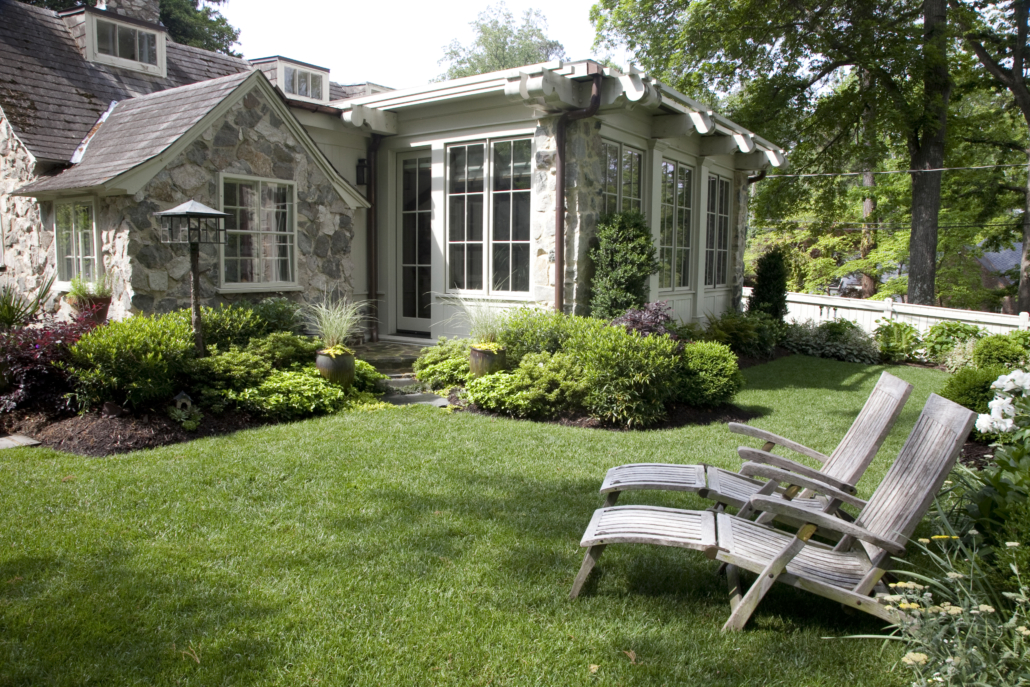
The north facade upon completion. Photograph by Helen Horsley.
Having created a series of intimate spaces in scale with the cottage, we continued the approach with two more outdoor rooms. Once again, we used stone walls and plantings to define the outdoor areas, and stone walkways and steps to lead from one space to the next. John sought to manipulate the grade to create the feel of a sunken garden.
A practical challenge drove the design for this garden, as is so often the case. The door to the outside was in an ideal spot for circulation in the new interior room, but left limited space for comfortable egress. The solution? A quarter arced landing with repeating step, creating an axis from which we repeated the curve across the garden in the form of a stone retaining wall with inset stone seat.
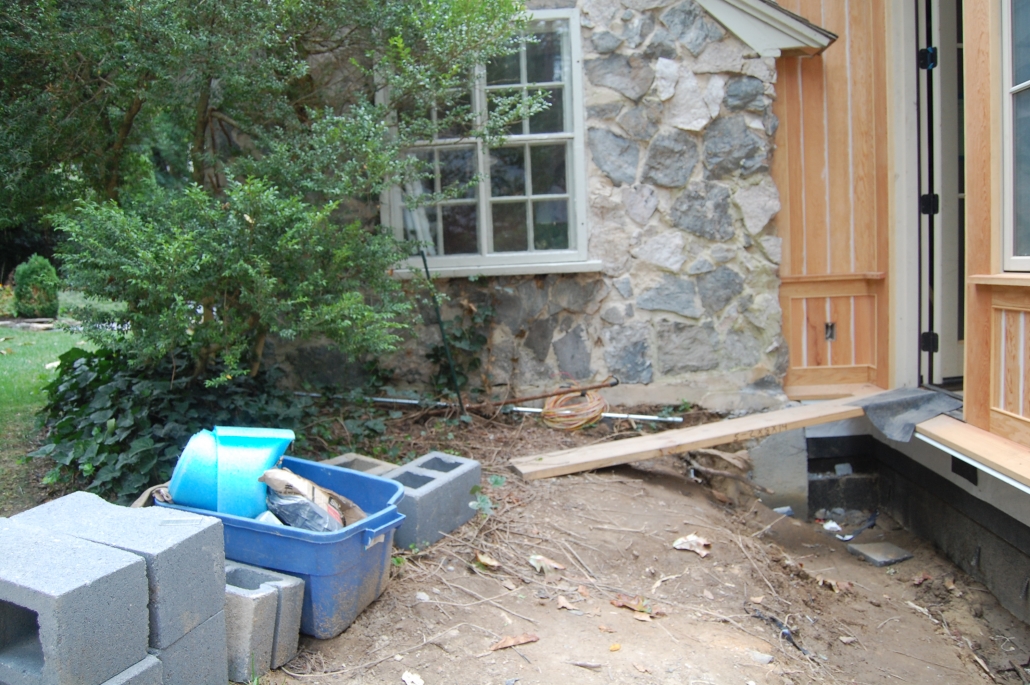
A tight space to exit
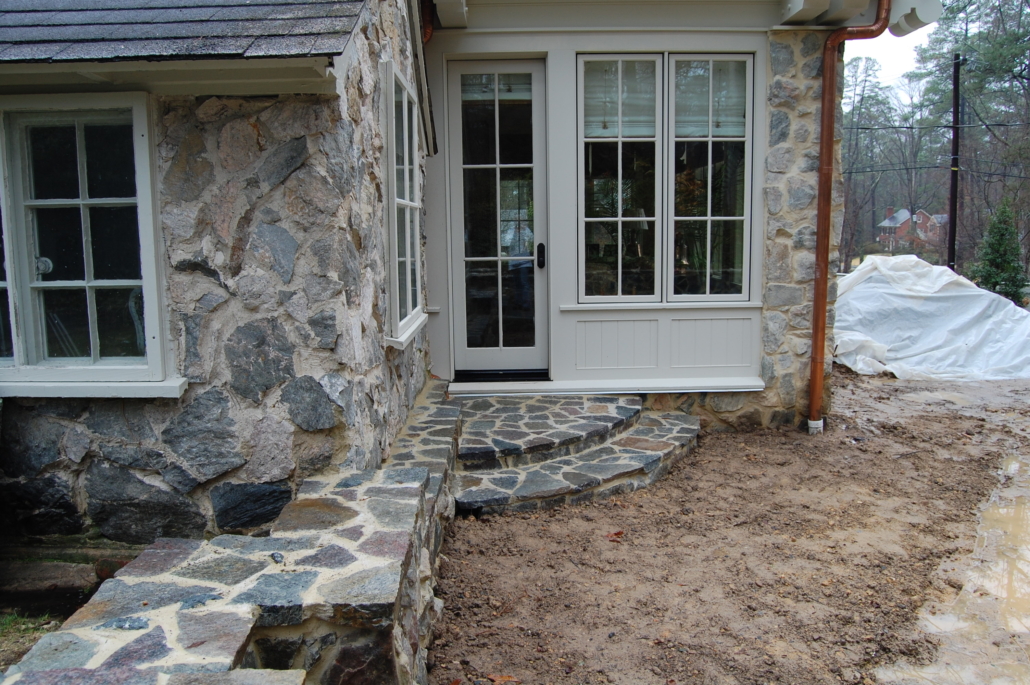
Stonework near completion
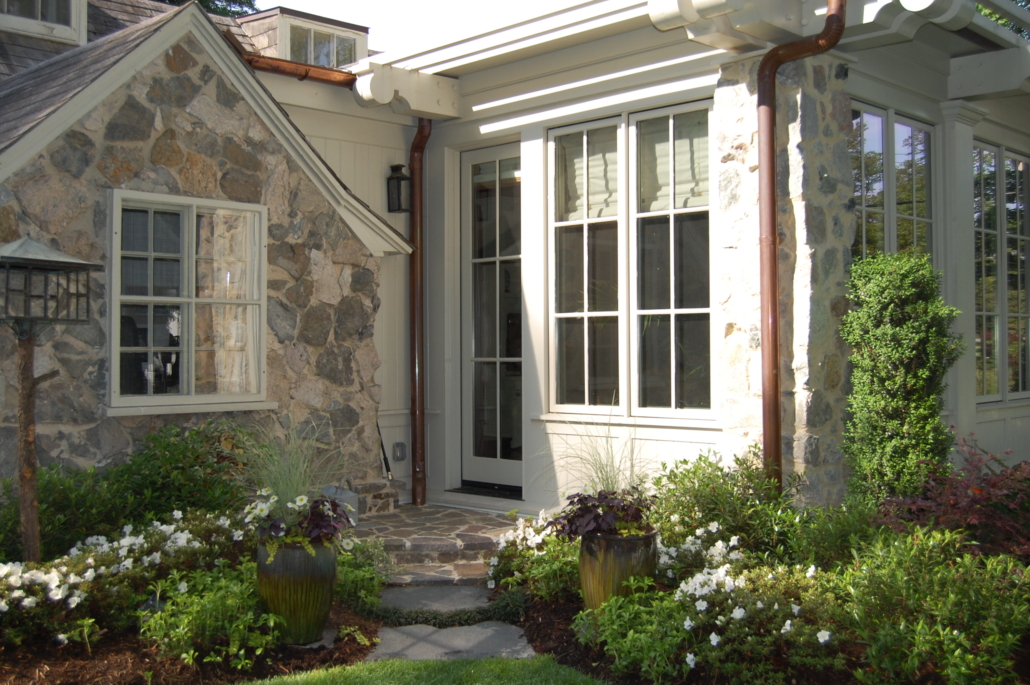
The entrance post-construction. Photograph by Helen Horsley.
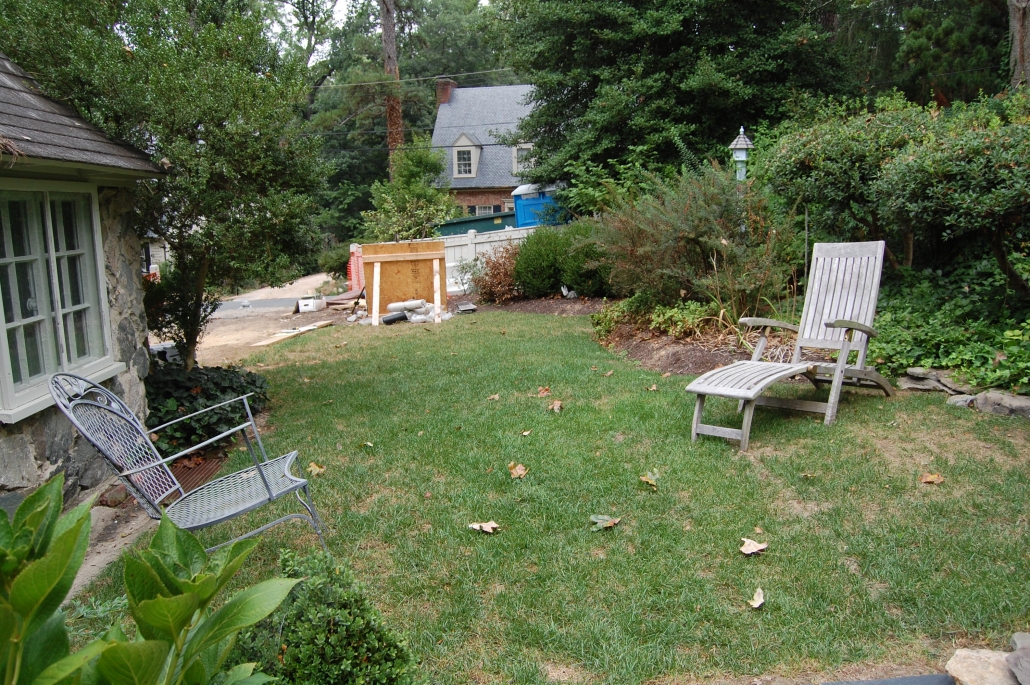
Looking north from the back terrace, prior to construction
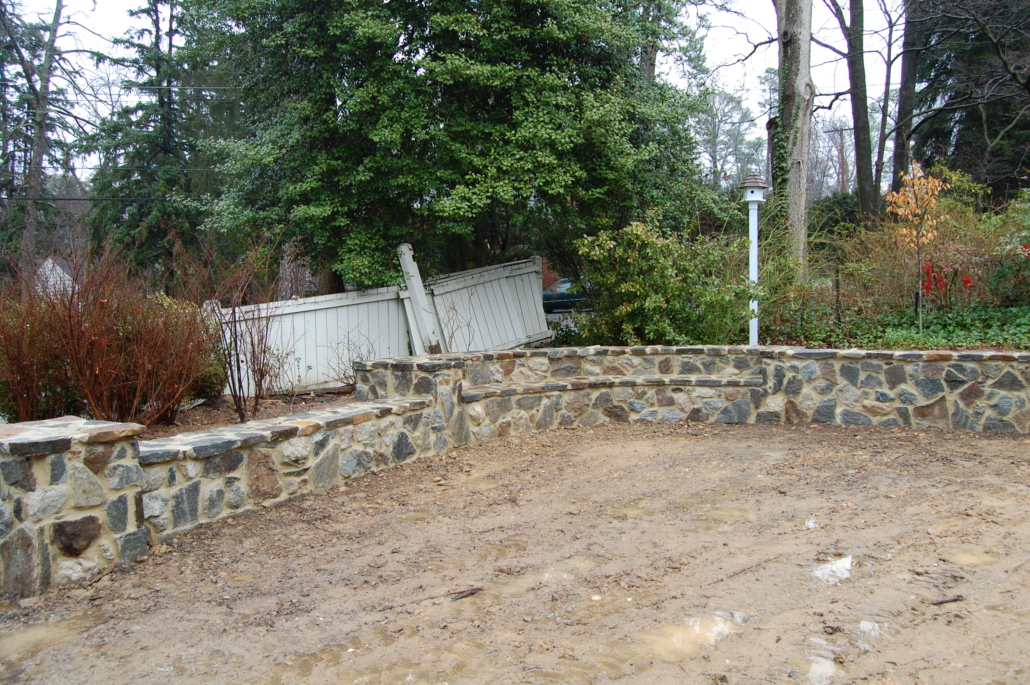
The retaining walls and seat wall go in
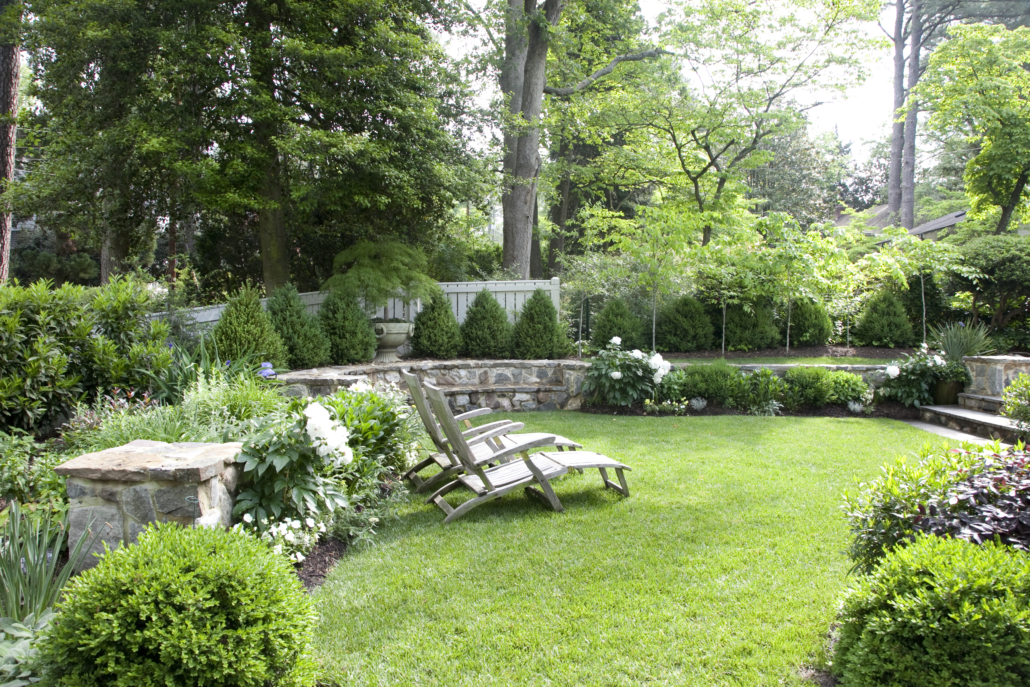
The “sunken” garden post-construction. Photograph by Helen Horsley.
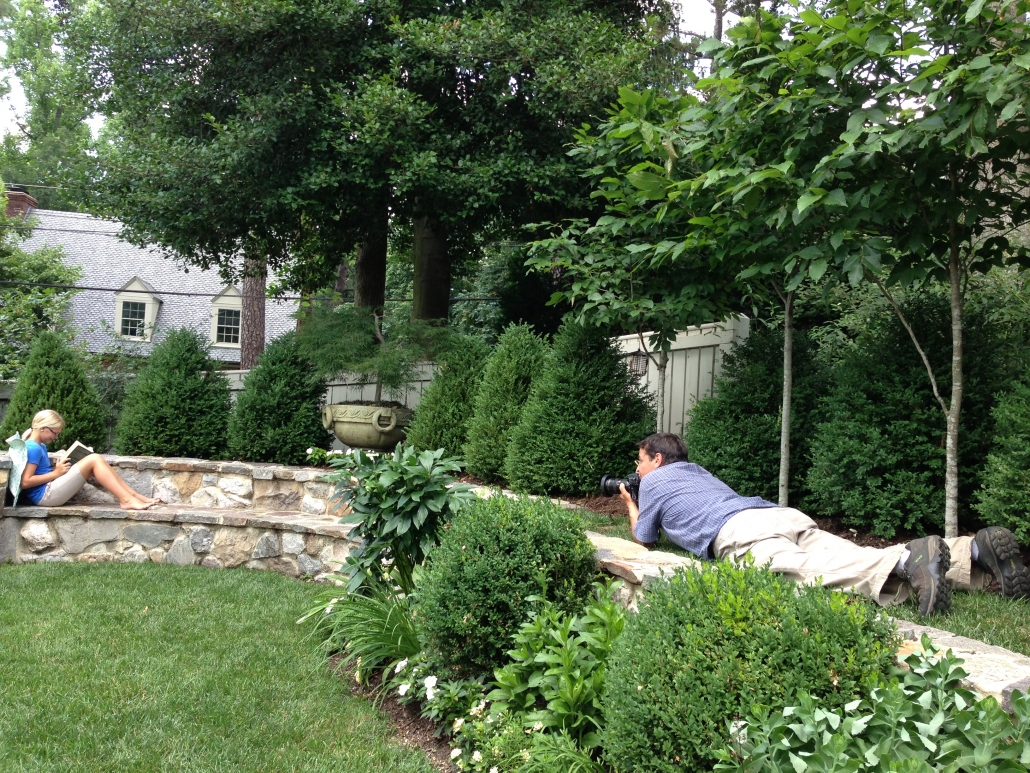
Cabell posing for a photo by photographer Rob Cardillo during a photo shoot for a feature in Traditional Home by Marty Ross
As can be seen in the drawing below, the stone seat is the central feature, lying on the central axis of both the back terrace walkway and the north path.

Landscape plan for the north gardens
The entrance to the adjacent space, centered on the broad expanse of windows, was subtly defined by two boxwood. A birdbath is centered on the windows, and a stone path along the axis bisecting the boxwoods leads to the north gate.
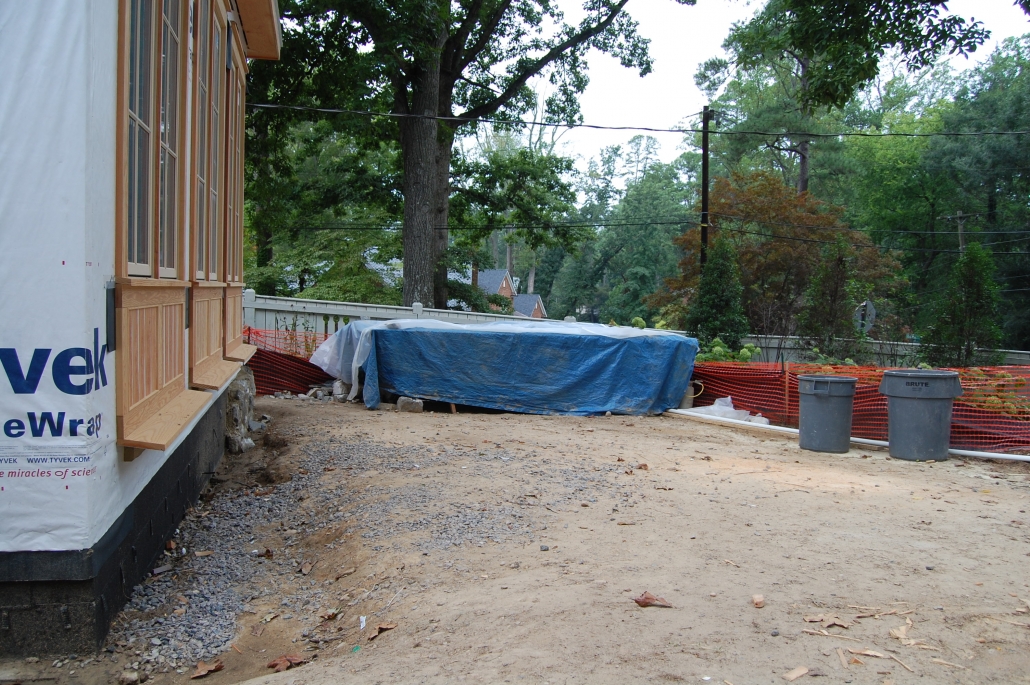
North garden during construction
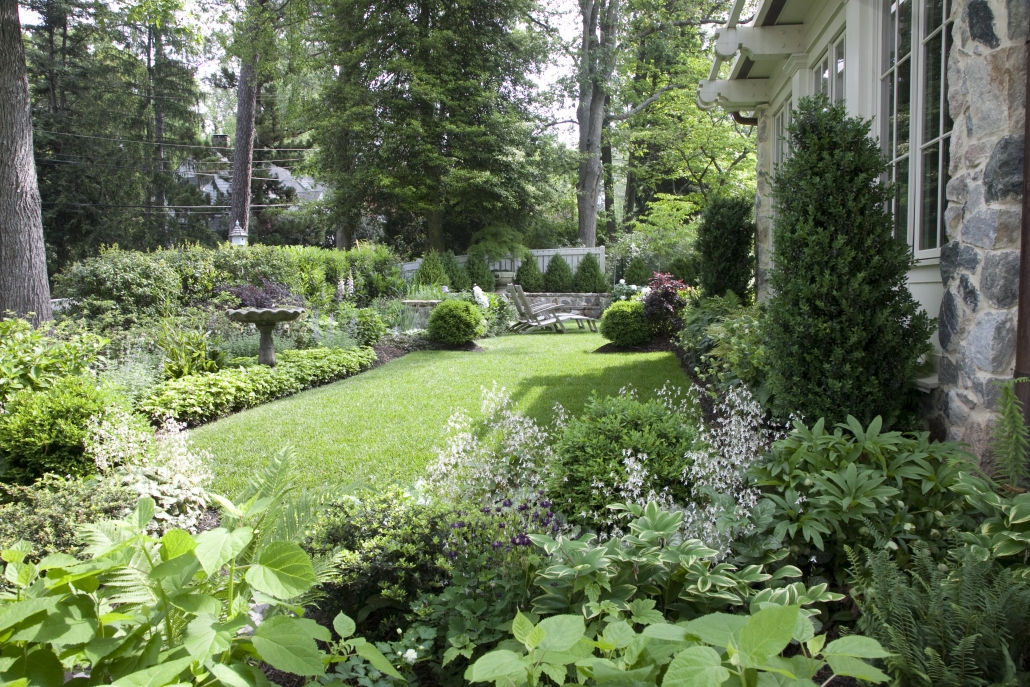
North garden, looking toward the seat wall, upon completion. Photograph by Helen Horsley.
Mary, John and Cabell spent the next 10 years caring for their cottage and gardens. Cabell has become a phenomenal squash player and Mary and John have nurtured and expanded the gardens over the years. Mary, an uber-talented flower arranger, has become quite the perennial guru, growing lush, beautiful borders. John is a meticulous gardener. He has patiently been training pleached beech hedges in the north gardens for the last 10 years, as well as espaliered fruit trees. He used to tell me he wanted planting beds with big shoulders — deeply cut bed lines with mounded soil. I was perplexed about this desire until I saw the “big shouldered” beds in England and had that a-ha moment.
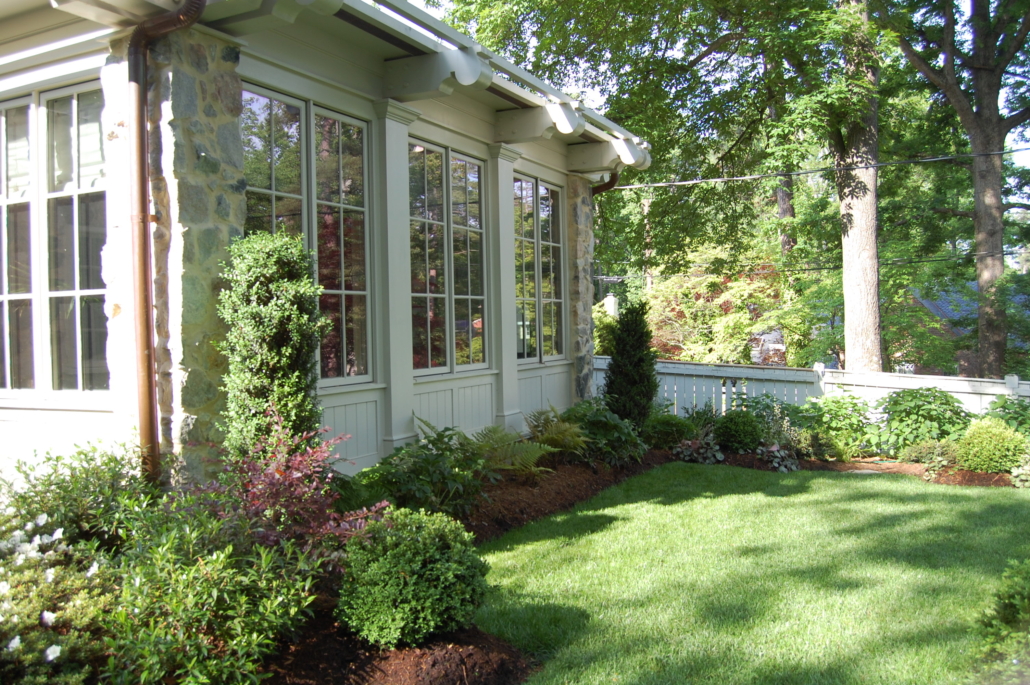
One of John’s broad-shouldered planting beds. Photograph by Helen Horsley.
Recently, Mary and John turned their attention to the detached stone garage, transforming it, again with the help of 3north, into a a stunning guest cottage with accompanying shed and tied together by a walled courtyard. I again collaborated with Mary and John on the garden, creating the retaining walls, steps, and circulation. But the planting was all them.
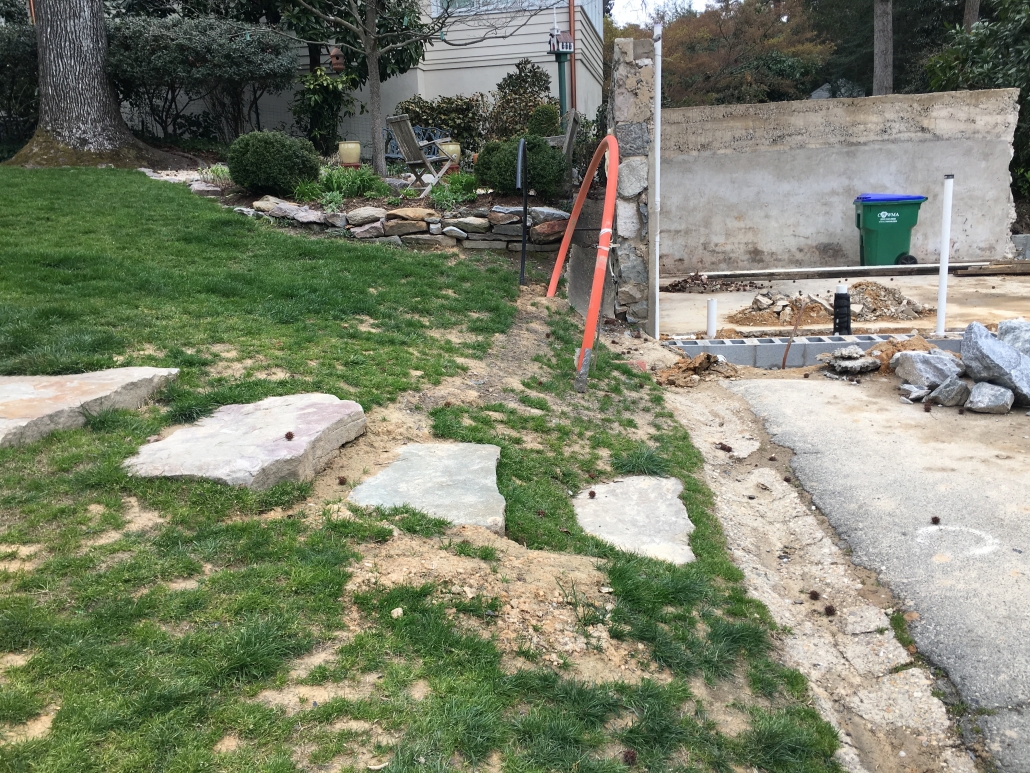
The garage, after being gutted, its walls preserved

After construction and planting
With the help of Terra Forma Landscaping, John transplanted and nurtured his beloved espaliered trees during construction. Our top priority in creating the garden’s retaining wall was that it be large enough to accommodate one of the espaliered trees.

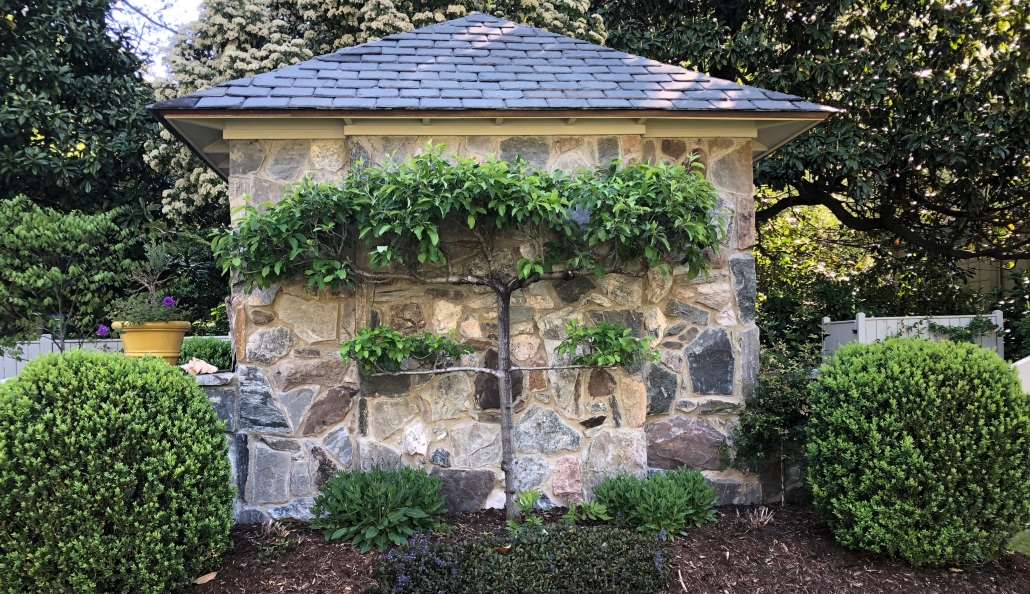
From there, Mary and John took over, building a dry-laid stone wall along the south property line, and filling the beds with beautiful mature boxwood, hydrangea, clematis, honeysuckle and perennials.
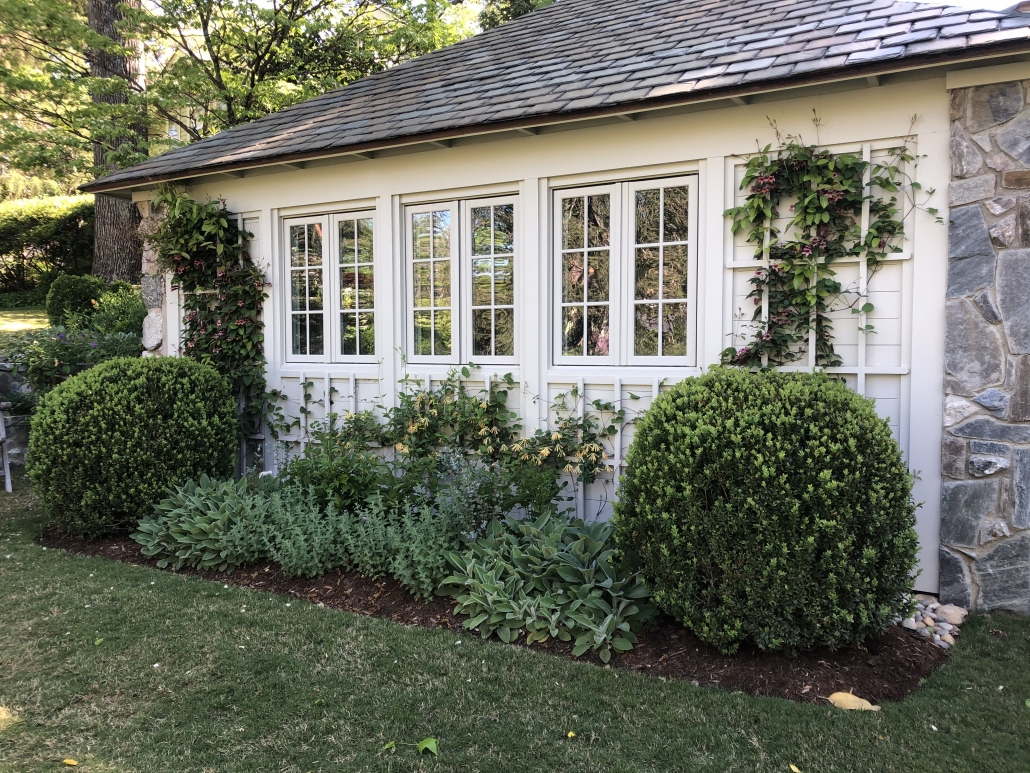
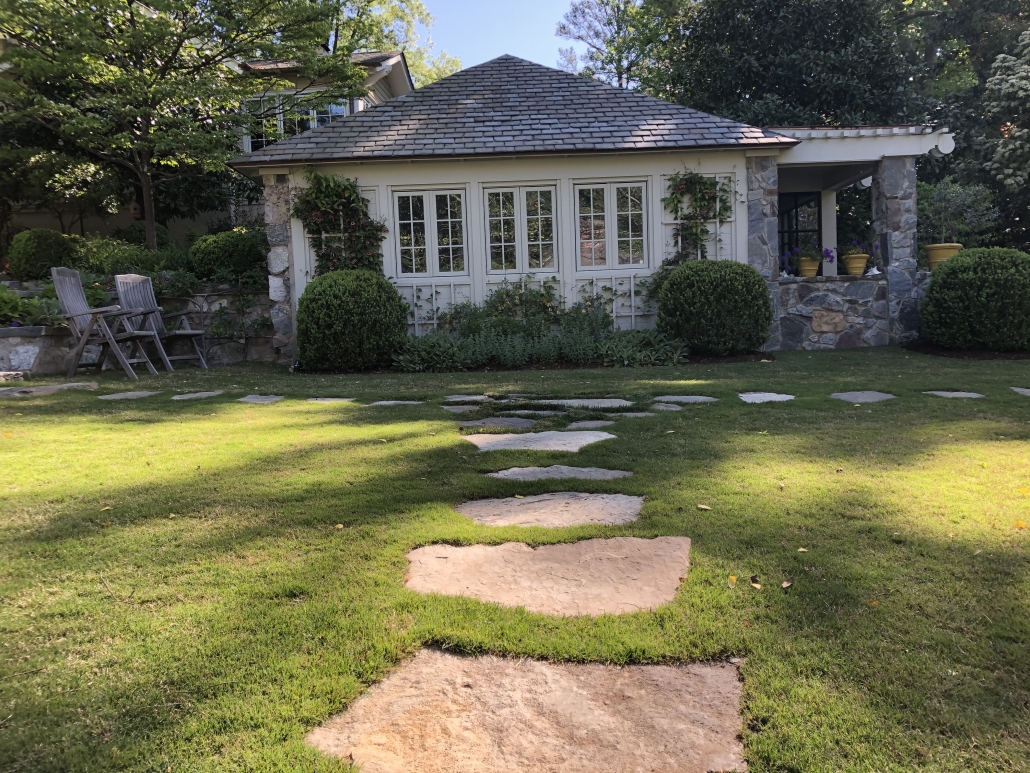
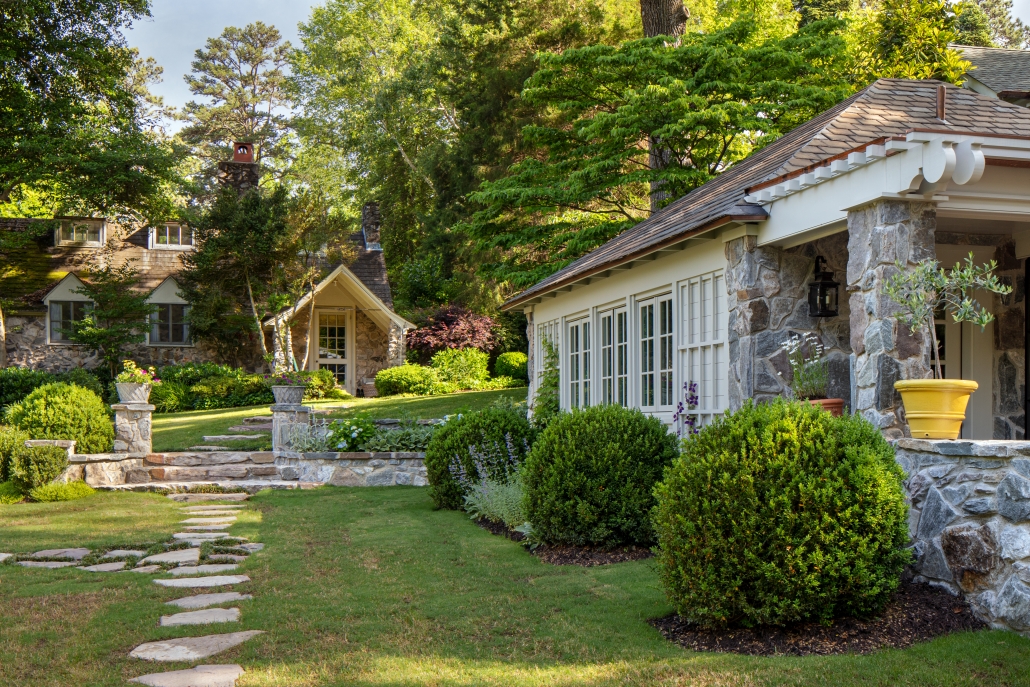
Photograph by Gordon Gregory
Ernest Flagg said, “the best art, and the only art which will ever lead to great results, must have for its basis the interpretation of beauty in nature.” Perhaps the Bacon/Crowders and Ernest Flagg are kindred spirits.
[custom-related-posts title=”Related Posts” none_text=”None found” order_by=”title” order=”ASC”]
SAVE THE INSECTS — AND THE WORLD!
Ok, that sounds a bit cheeky, but it is not an exaggeration. We need a robust insect population to survive. Why am I writing about the importance of insects on a garden design blog? Because the world’s insect population has fallen precipitously in recent years, and those of us who garden can do our part to help restore the balance.
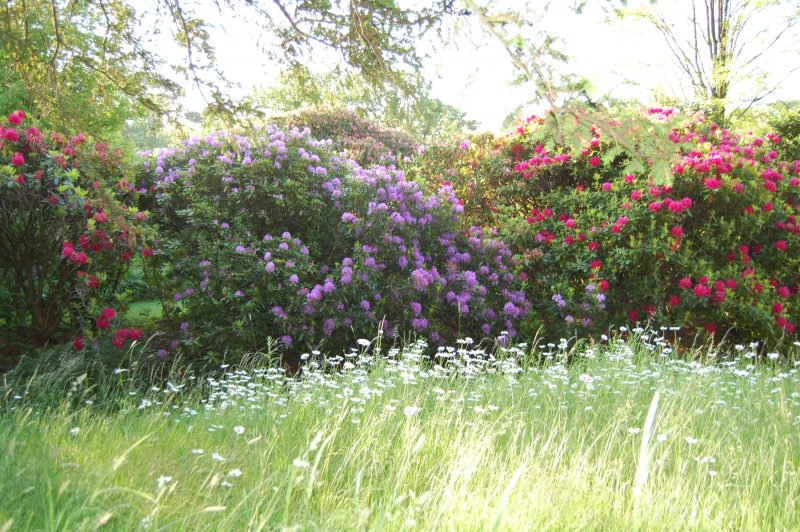
Insects are critical to the earth’s ecosystem in many ways. First, as pollinators, they are a necessary part of food production. At least a third of all agricultural crops are dependent on insect pollination for production. Strawberries, apples, and tomatoes are just a few of the foods reliant on insect pollination.
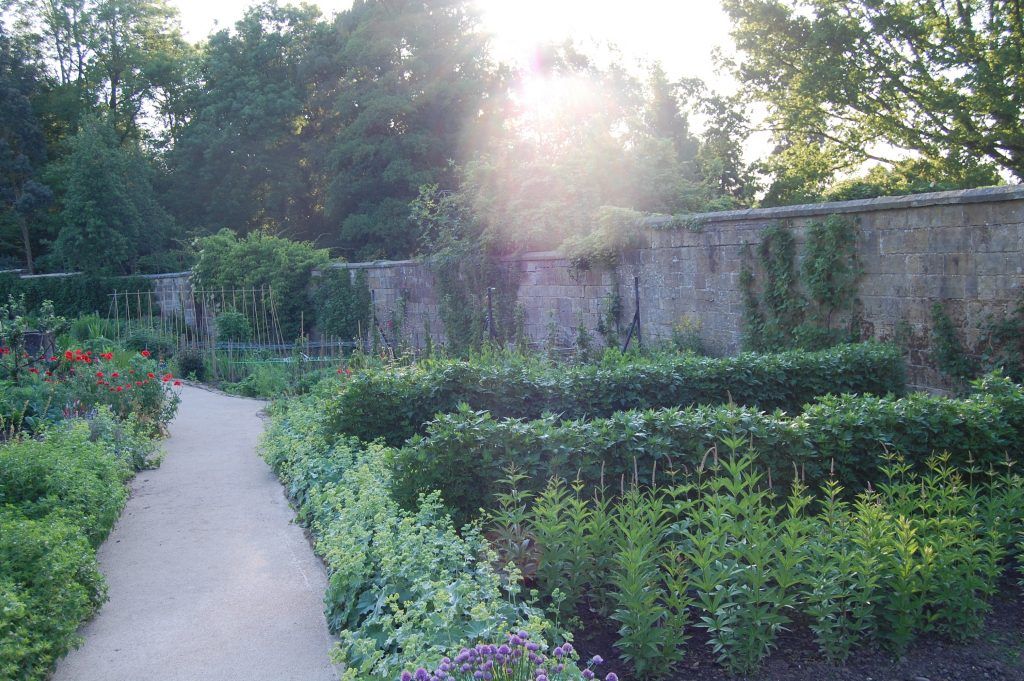
Perennials that draw pollinating insects are planted alongside vegetables in Gravetye Manor’s kitchen garden.
Second, they are a tasty and essential part of the diets of many birds, fish and animals.
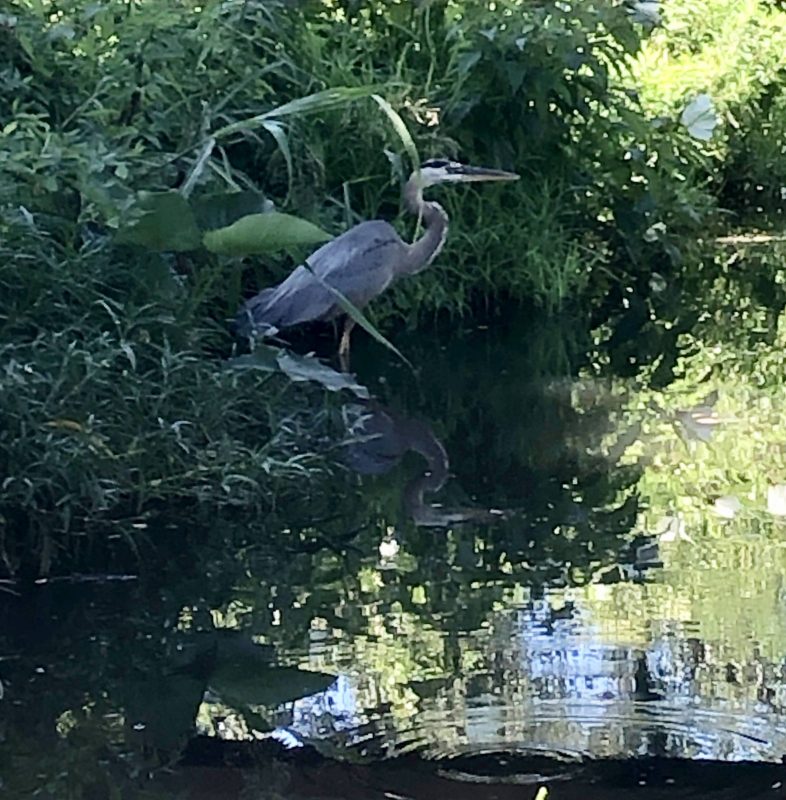
A Great Blue Heron hangs out along the Capital Trees Low Line. Herons eat fish, and fish eat insects.
Third, as Professor Anne Sverdrup-Thygeson writes in the Wall Street Journal (subscription required), “among the essential services that insects perform for us and the planet is waste management. As life ends for plants and animals of all sizes, from midges to moose, somebody or something has to break up and eliminate the dead organic matter. It might not be a hotshot job, but the processes of decomposition and decay are critical to life on Earth.”
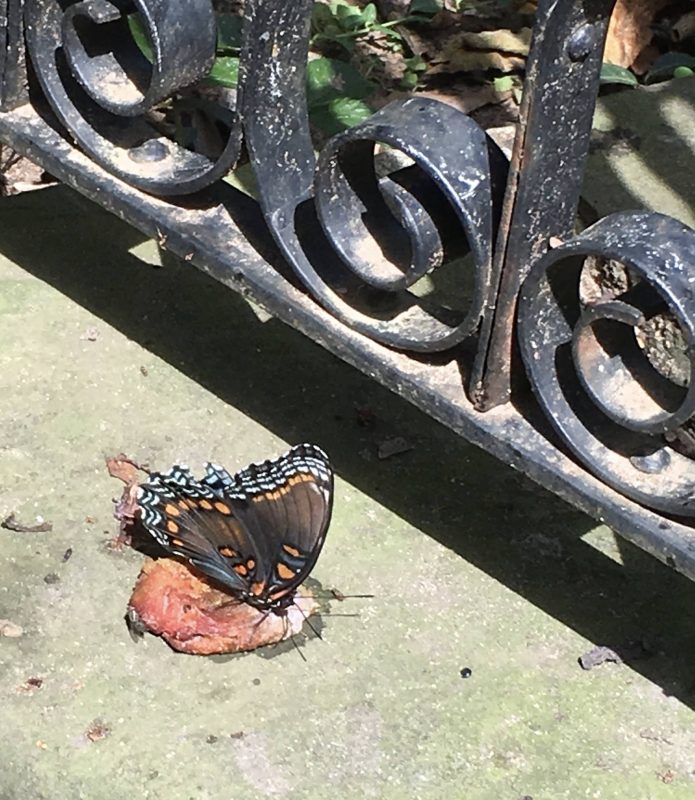
A butterfly feeds on a rotting fig.
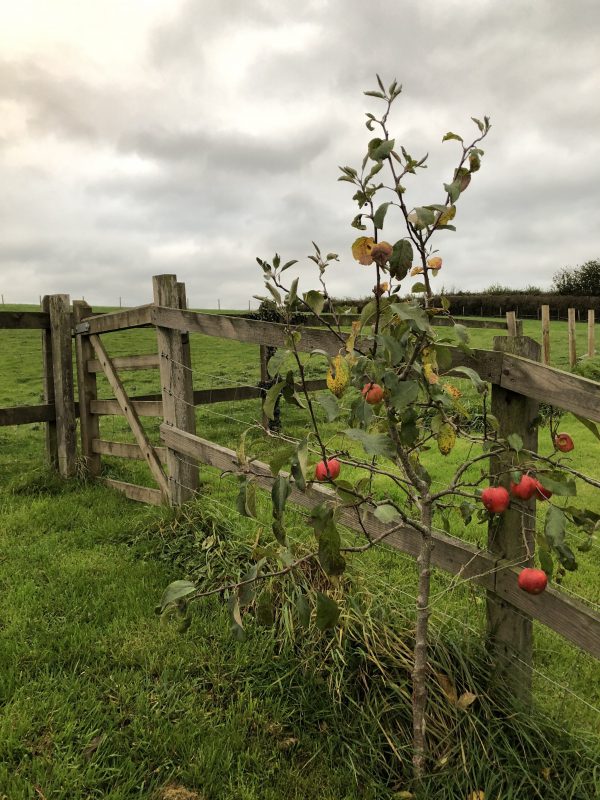
Insects will contribute to the necessary decomposition of the apples that fall to the ground. Rampisham Hill Farm, Dorset, England.
Here are a few fascinating statistics cited by Sverdrup-Thygeson, a professor of conservation biology at the Norwegian University of Life Sciences, and the author of the book Buzz, Sting, Bite: Why We Need Bugs :
- While humans have doubled our population in the past 40 years, the number of insects has been reduced by almost half, according to a 2014 report in the journal Science.
- Three quarters of all known plant and animal species on this planet are insects. Those giant quantities help to keep nature in balance, so anything that affects them ultimately affects us.
- Herbivores eat just 10% of all plant production. 90% is left lying on the ground — impressive amounts of protein and carbohydrates in need of recycling. Insects eat the rotten remains, which not only clears the ground of dead plants and animals, but also returns the nutrients to the soil. Without it, new life could not grow.
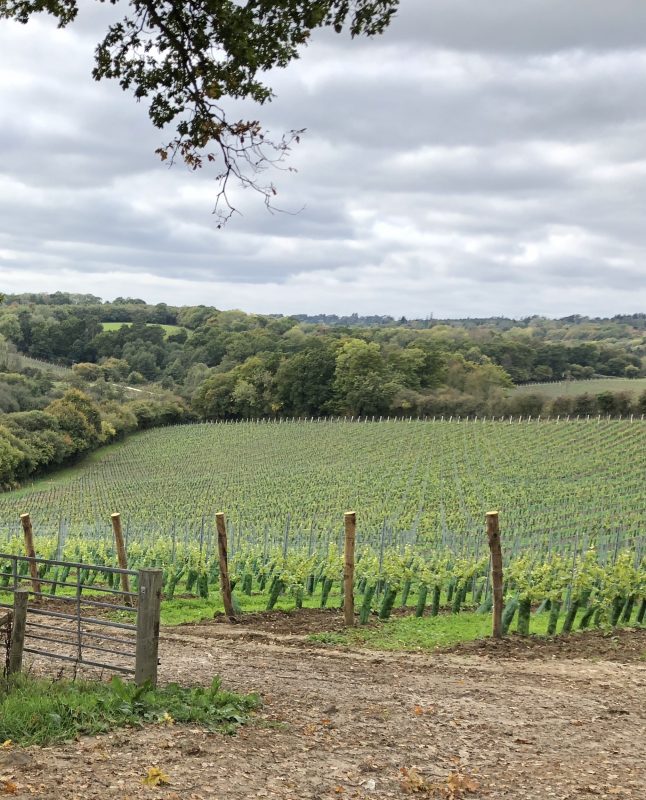
Shrubs, trees, and wildflowers border this field, providing pollinators for the crops, shelter and food for birds and wildlife, and erosion control to protect streams.
WHAT WE CAN DO TO HELP
- Plant more trees, shrubs, vines and perennials on your property. Shoot for making a large percentage of those plants native, as those are the plants our native insects rely on. Reduce the amount of mown lawn, and increase planting beds and meadows. Consider planting fewer “double” flower cultivars, as these tend to contain little nectar, and are difficult for pollinators to access. Leave as many wild, undisturbed areas as possible to support wildlife.
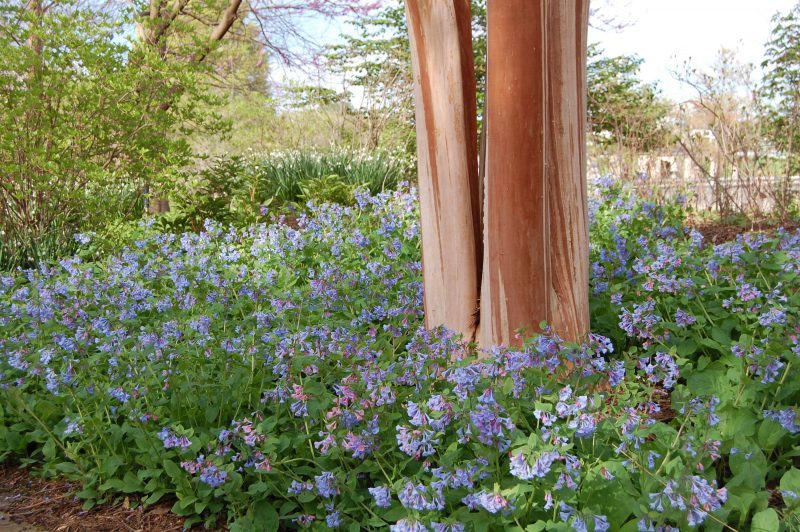
Native Virginia Bluebells (Mertensia virginica) spread under a Crapemyrtle (Lagerstroemia indica) at Lewis Ginter Botanical Garden.
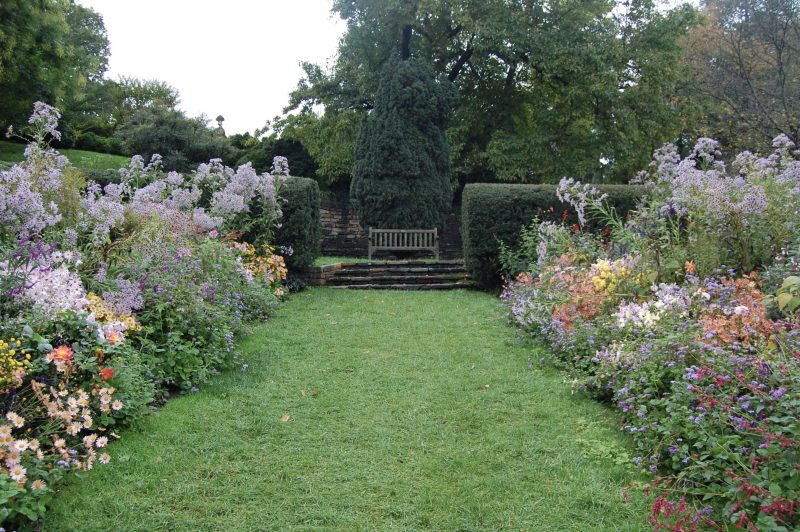
This four-season border at Dumbarton Oaks includes native and non-native perennials, and, importantly, provides nectar, pollen, food, and shelter year- round.
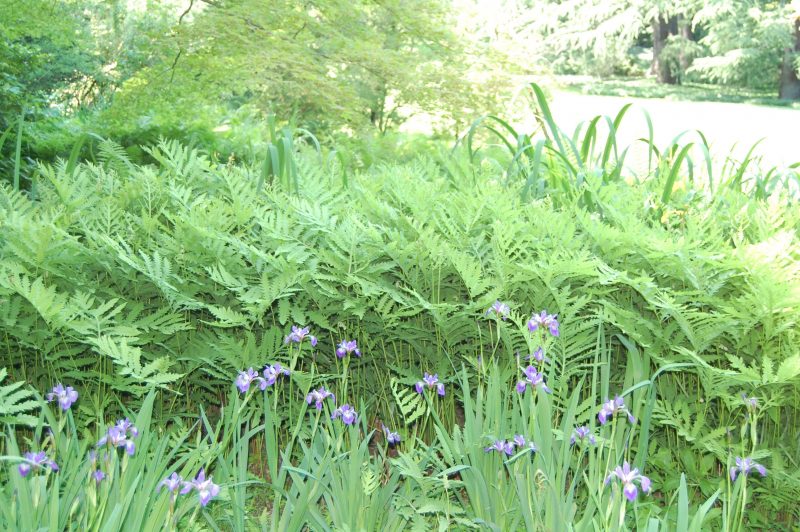
Native Blue Flag Iris (Iris versicolor) and Sensitive Fern (Onoclea sensibilis) are planted in a large swath.
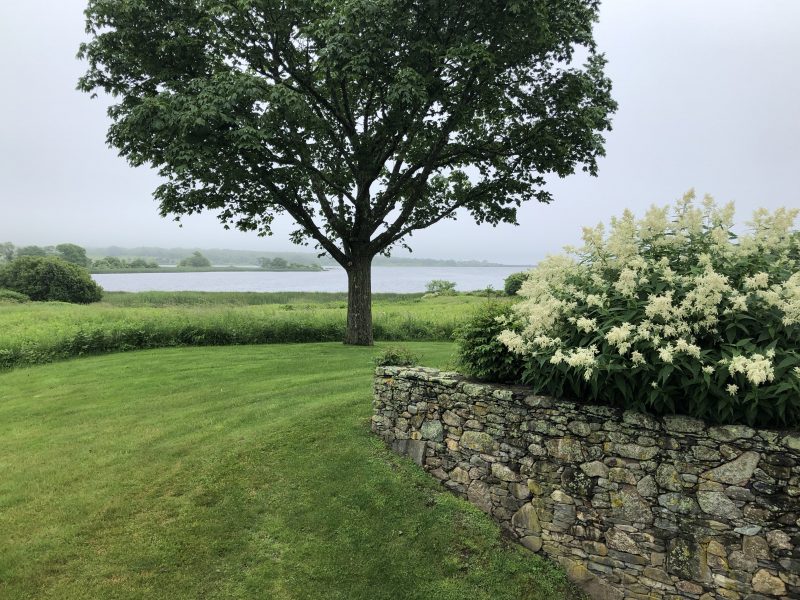
The owner of this Little Compton, Rhode Island garden limits the amount of mowed lawn, allowing meadow to grow along the edge of Brigg’s Marsh, which filters pollutants, limits erosion, and attracts and protects insects.
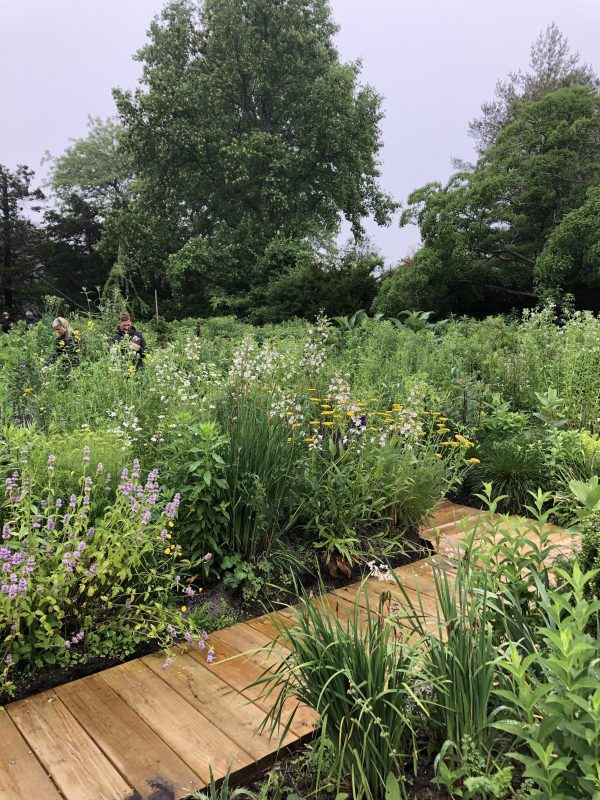
Perennials and grasses are cultivated in a meadow planting at Sakonnet Garden. Owners John Gwynne and Mikel Folcarelli continuously study and experiment with the best methods of providing a biodiverse habitat for specific species of birds native to the area.
2. Reconsider what it means to have a cultivated garden. For those who love a manicured garden, try to throw a little caution to the wind and become a bit less tidy. Do not cut back perennials and grasses until late winter or early spring,and leave as many wild, undisturbed areas as possible, allowing wildlife to use the plants for shelter, food and nesting material.
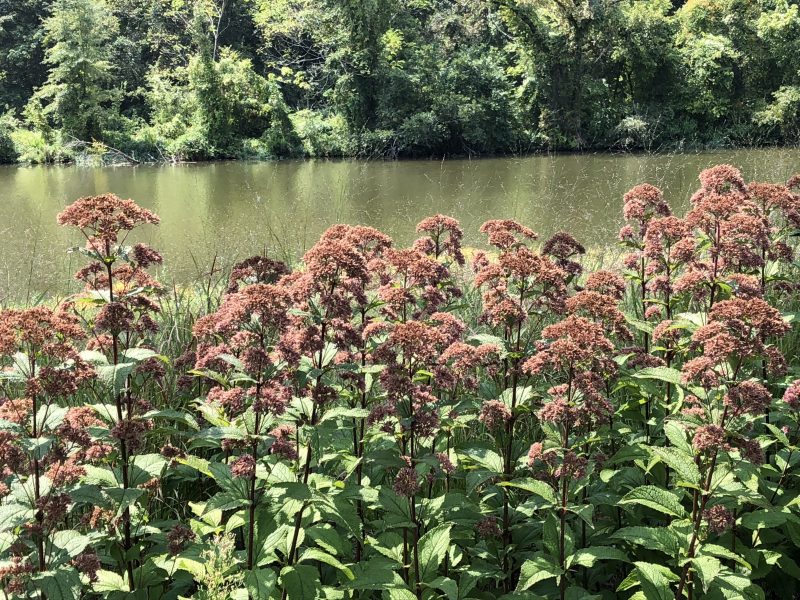
Capital Trees leaves the native Joe Pye Weed (Eutrochium purpureum) throughout the winter along the Low Line and at Great Shiplock Park in the rain garden.
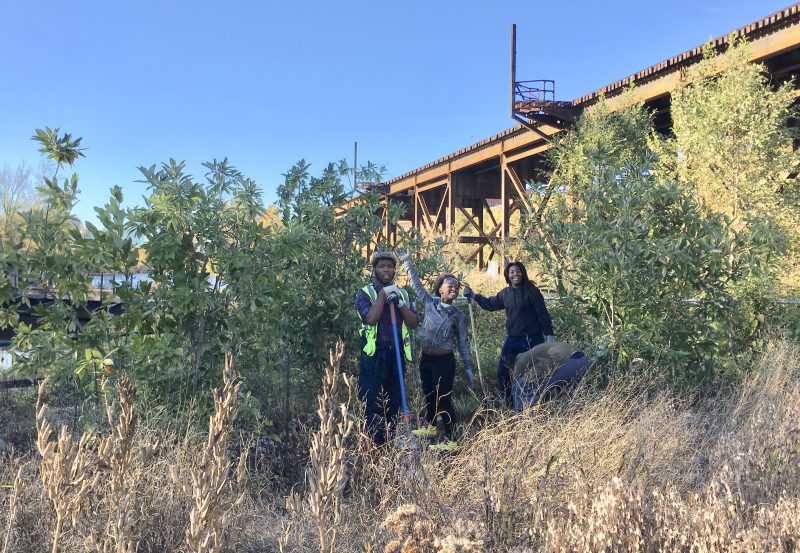
Members of the Groundworks RVA Green Team cut back the Joe Pye Weed and grasses in the rain garden at Great Shiplock Park in late winter.

Capital One employees volunteer their time with Capital Trees to cut back shrubs and perennials in late winter. Capital Trees leaves most plants unpruned throughout the fall and winter to provide food, shelter and nesting material for wildlife at Great Shiplock Park and the Low Line.
3. Cease or minimize the use of pesticides. Many of you have heard me say that I’m a Darwinist gardener. I began as such because I just didn’t have the time or inclination to deal with high-maintenance plants that could not thrive without my special attention or intervention. As it turns out, my laziness paid off, as this is also the most environmentally sound way to garden. Pesticides are not selective. They kill whatever they come into contact with. Spray a plant to kill one pest (or the entire property to kill mosquitos), and you kill other species that come into contact with the poison, thus affecting the entire ecosystem.
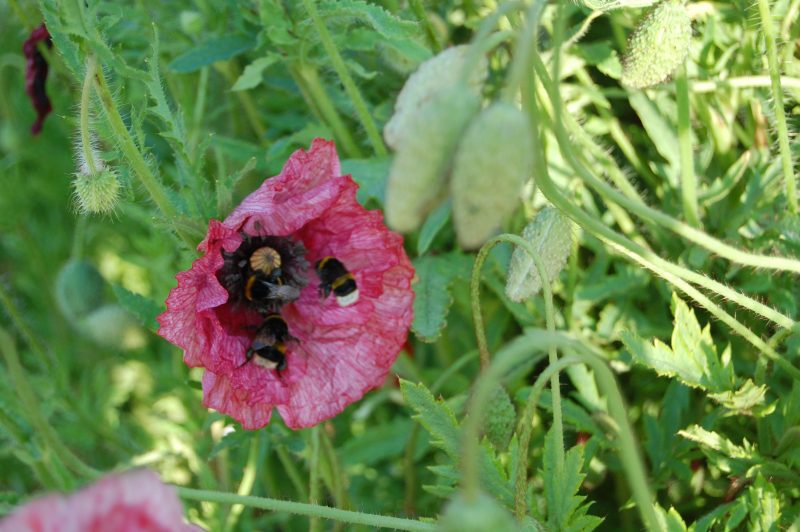
Bees feast on a Poppy in the Gravetye Manor kitchen garden.
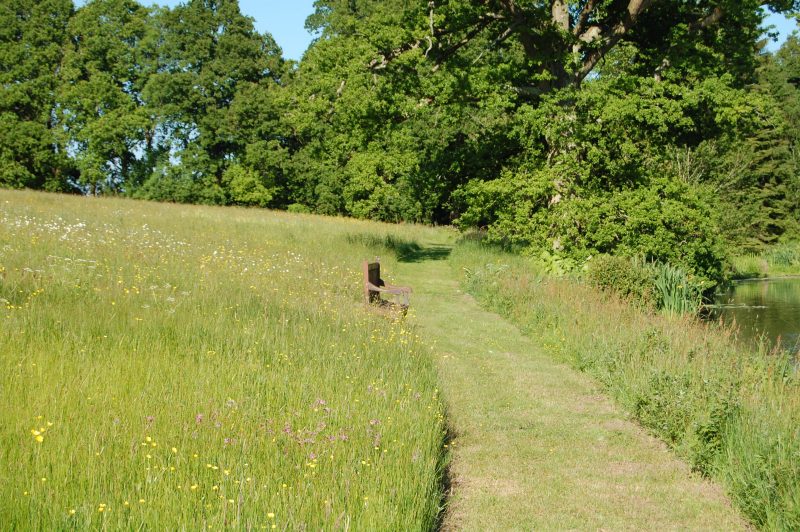
Gravetye Manor leaves the fields unmowed throughout the growing season, cutting a path near the water’s edge.
4. For those with larger properties, including farms, offset the monoculture of crops by allowing wide buffers to border the fields, and increase the amount of land dedicated to meadows, hedgerows, verges or tree canopy.
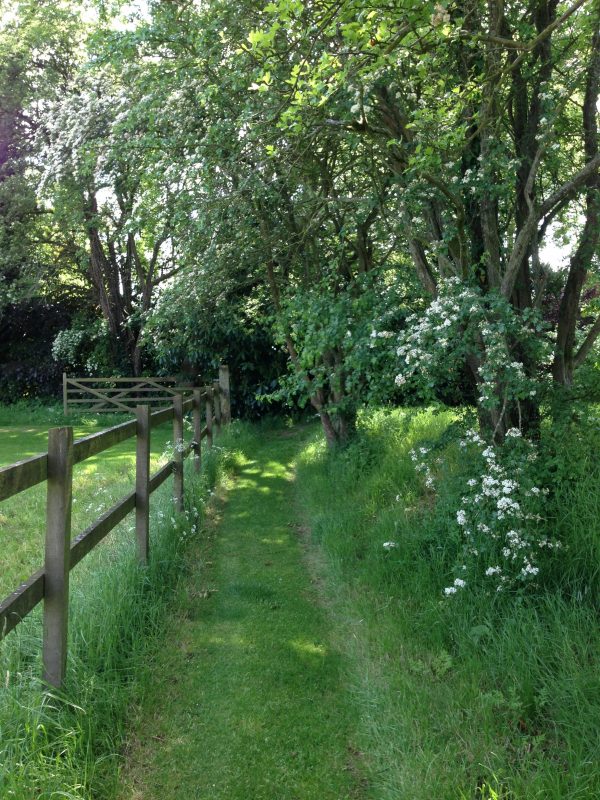
Flora and Ed allow grasses and wildflowers to grow through much of their property in Lasham, England. Flora owns a cooking school on the property and grows some of the food used for her delicious meals.
5. If your property includes woodlands, allow some fallen trees and branches to decay, providing homes for insects.
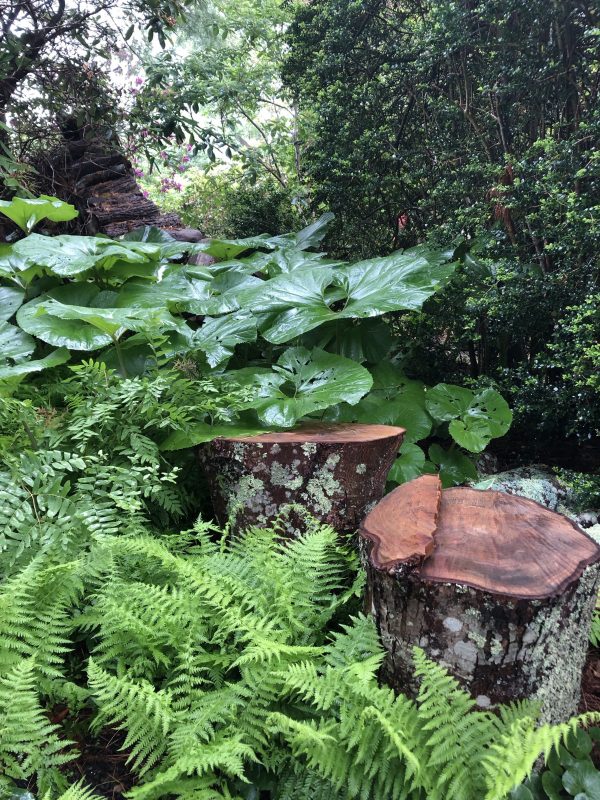
Woodland plants grow alongside the decaying tree stumps in Sakonnet Garden.
6. Encourage your locality and state to increase conservation and wilderness areas; to plant more shrubs, trees and perennials in public parks and increase the matrix of green spaces throughout the city and region; to join the verge movement, by decreasing the frequency of mowing in roads’ rights-of-way during the growing season.
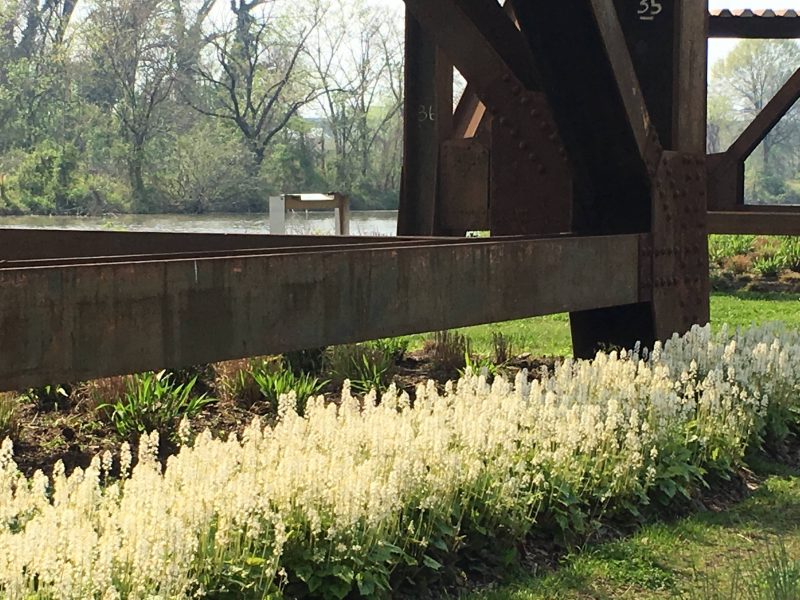
Native Foamflower (Tiarella cordifolia) grows at the edge of the CSX viaduct along the Capital Trees Low Line and Virginia Capital Trail.
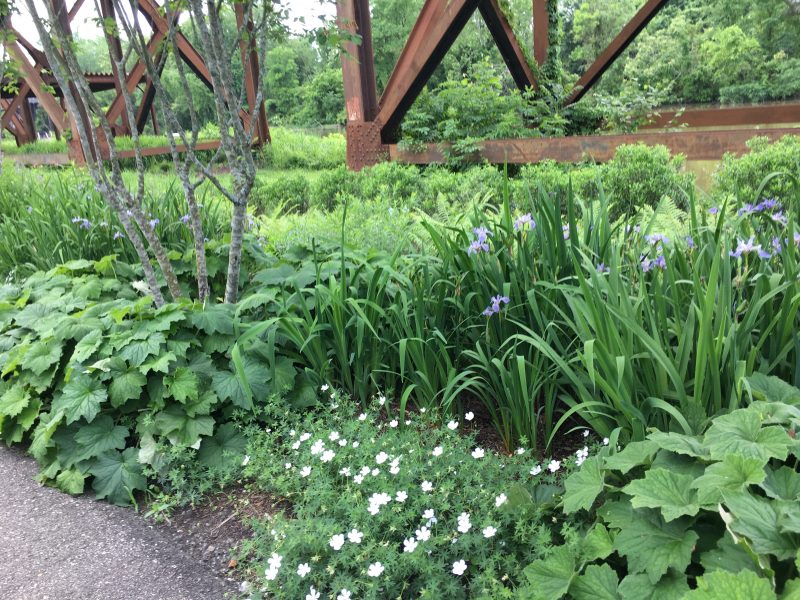
Perennials and native trees grow along the Capital Trees Low Line and Virginia Capital Trail in Richmond’s Shockoe Bottom.

James River Association’s Amber Ellis leads a group of volunteers planting native woodland perennials at the James River Park System’s Chapel Island. JRA and Capital Trees work with the JRPS Invasive Plant Task Force to restore native habitat throughout the James River Park System.
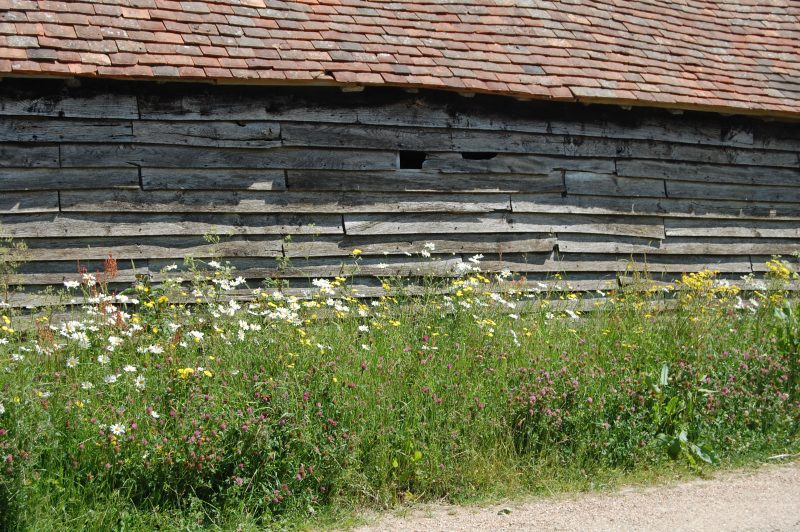
In England, Plantlife is leading the charge to encourage localities to allow roadside verges to go unmown duirng the growing season. Let’s do the same in our own localities. It saves the government money and increases the amount of public space providing wildlife habitat.
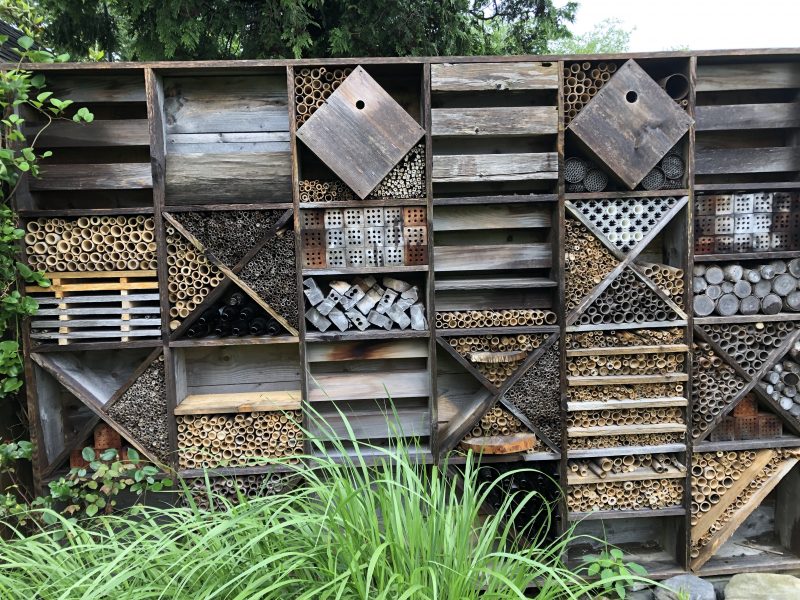
How cool is this insect house at Sakonnet Garden? By using a variety of materials, the insect house (also called an insect hotel) attracts a wide range of insects.
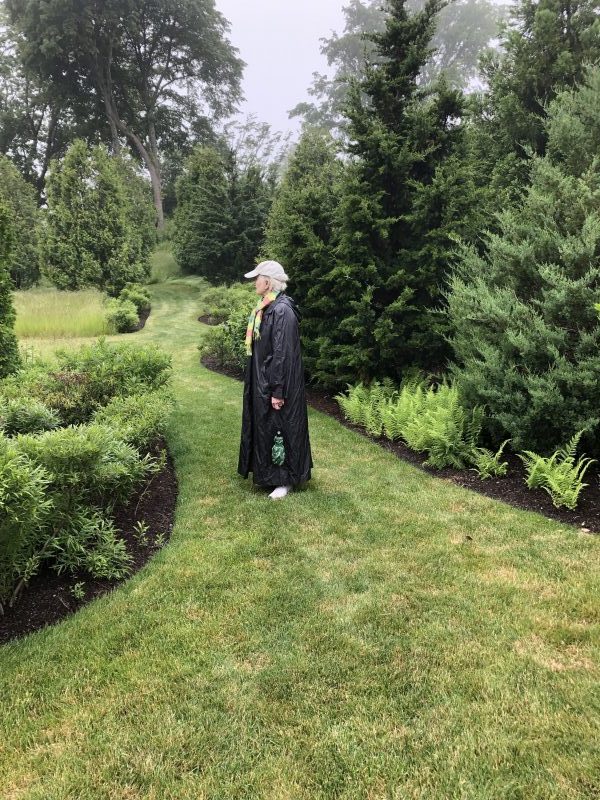
You can just see the wheels turning as Hylah Boyd, who forwarded me the Sverdrup-Thygeson article, surveys the landscape. The Capital Trees Board member has recommended that boy scouts and other volunteer groups build insect houses in Richmond’s parks and public landscapes. Capital Trees is exploring the possibility of building one along the Low Line.
In conclusion, I again quote Sverdrup-Thygeson: “high biological diversity makes ecosystems more resistant and resilient. . . A varied global landscape provides many more opportunities for the flourishing of complex insect life — and everything that depends on it, including us.”
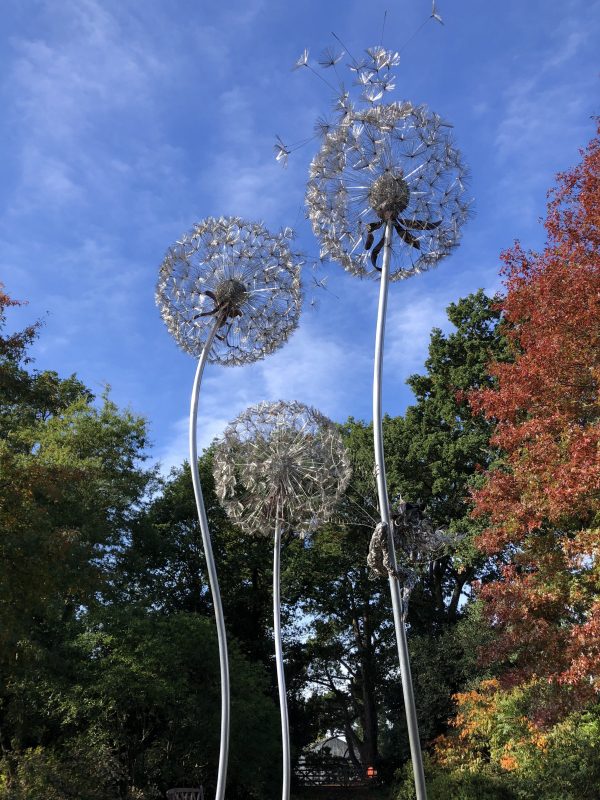
Let’s do our part to make sure that we can continue to enjoy fantastical steel dandelions (at the Royal Horticulture Society’s Wisley Garden) as well as nature’s version.
[custom-related-posts title=”Related Posts” none_text=”None found” order_by=”title” order=”ASC”]
STRUCTURAL ELEMENTS TO ELEVATE YOUR LANDSCAPE
Winter is the perfect time to critically evaluate our gardens. With many of the plants in dormancy, the strength of our gardens’ bones is revealed. Take a winter walk through your property to determine whether it might benefit from the incorporation of the following structural elements:
EDGING
Whether lining a driveway with cobbles or defining the separation of the lawn and planting beds with brick, an edge makes a garden’s design stand out.
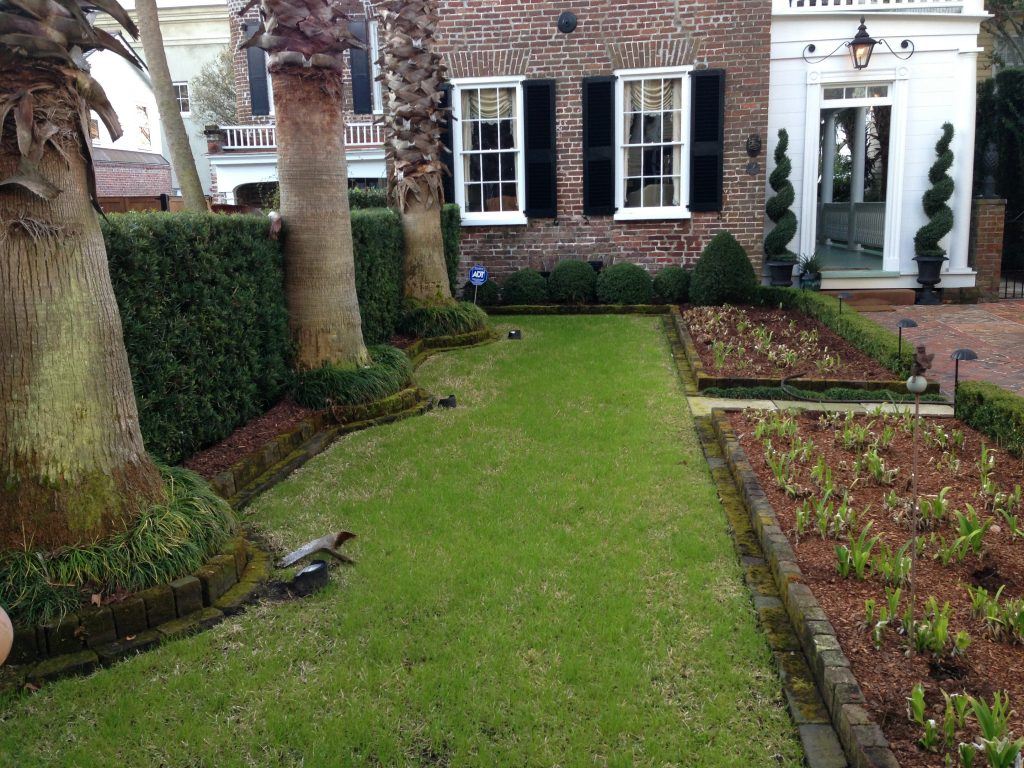
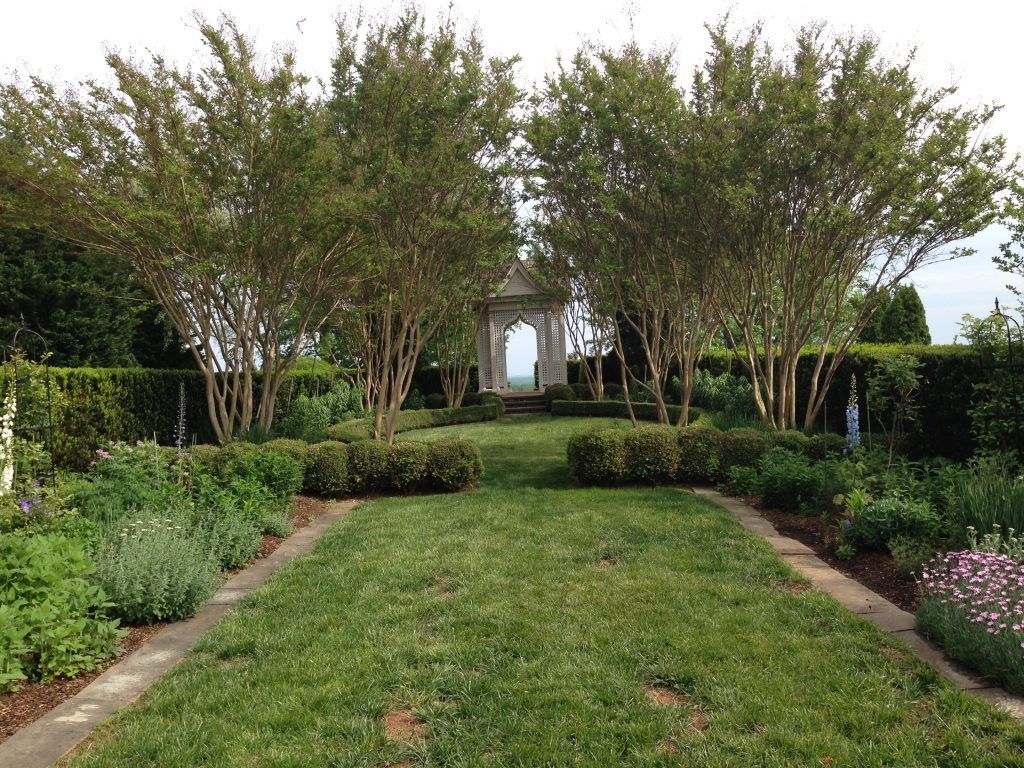
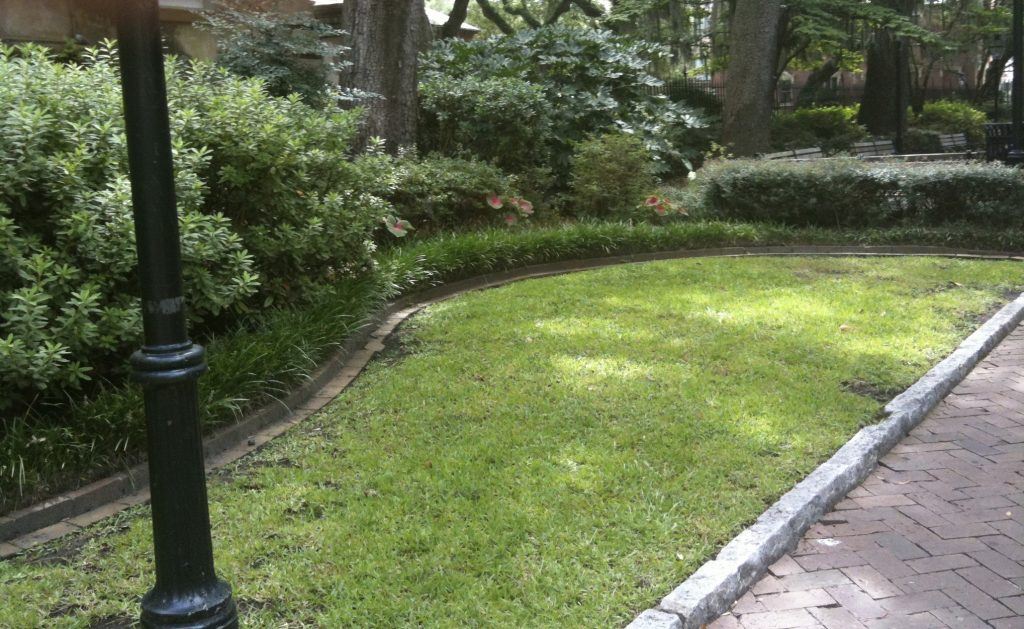
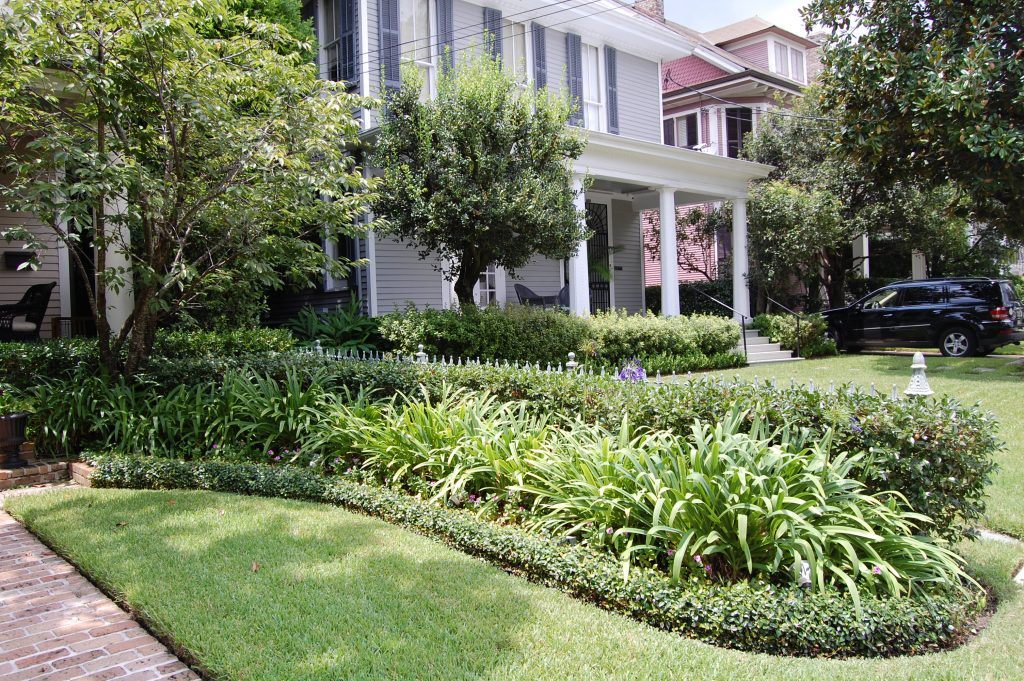
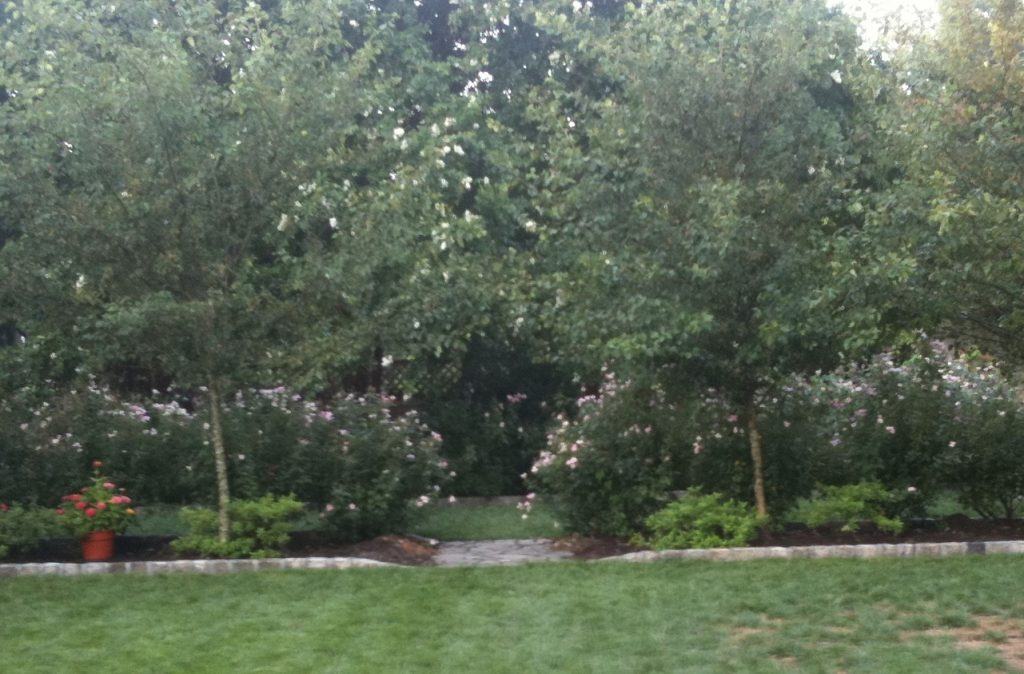
WATER
A water feature can be a subtle addition to the garden, tucked into a corner, or a central feature. Be sure to add a spout or other means of water flow to prevent mosquitos and to add the alluring sound of moving water. When designing a water feature, I always make sure to soften and frame it with plants, to avoid a harsh assault of pavement.
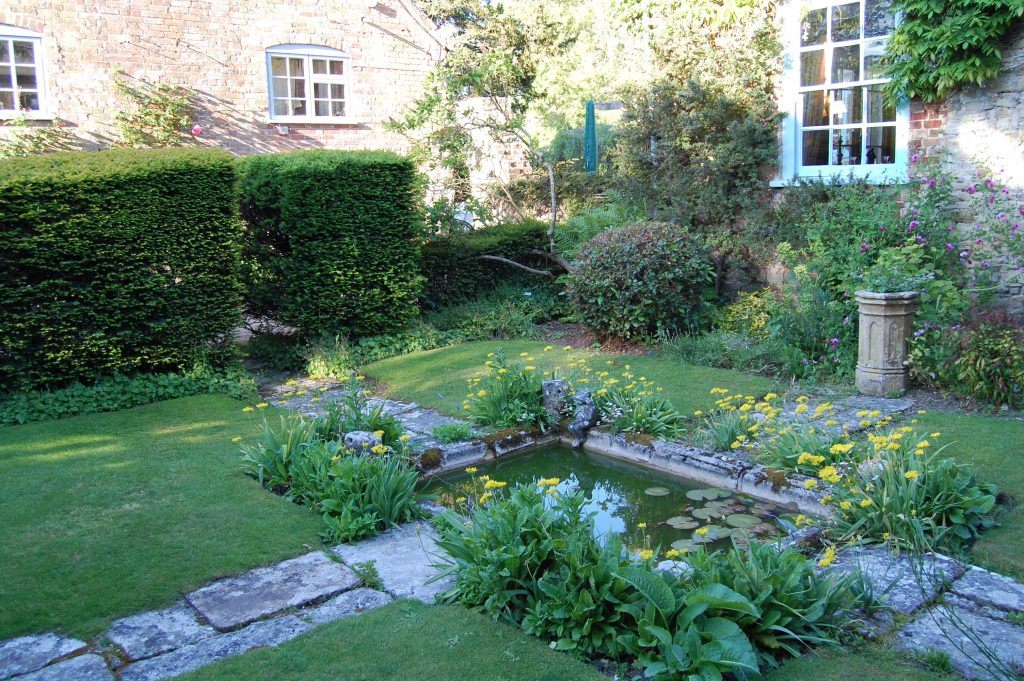
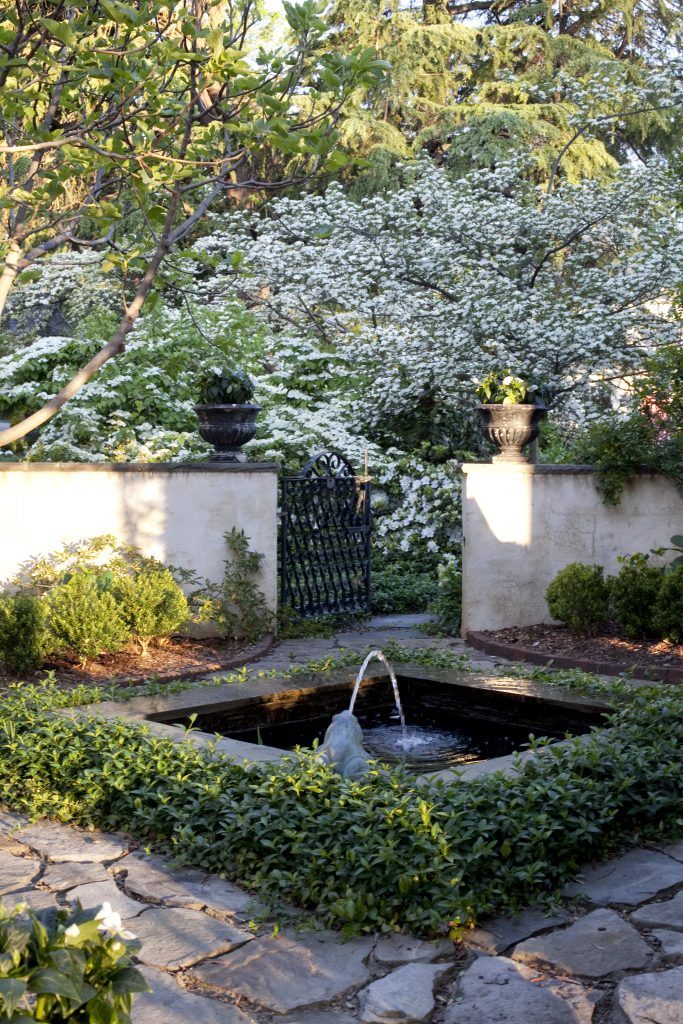
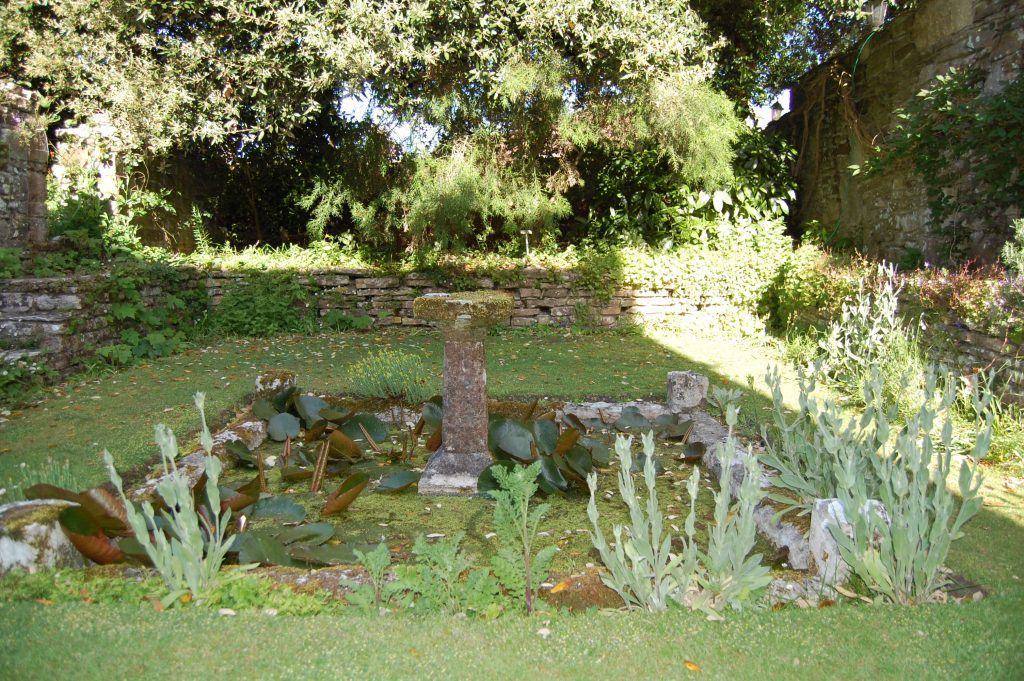
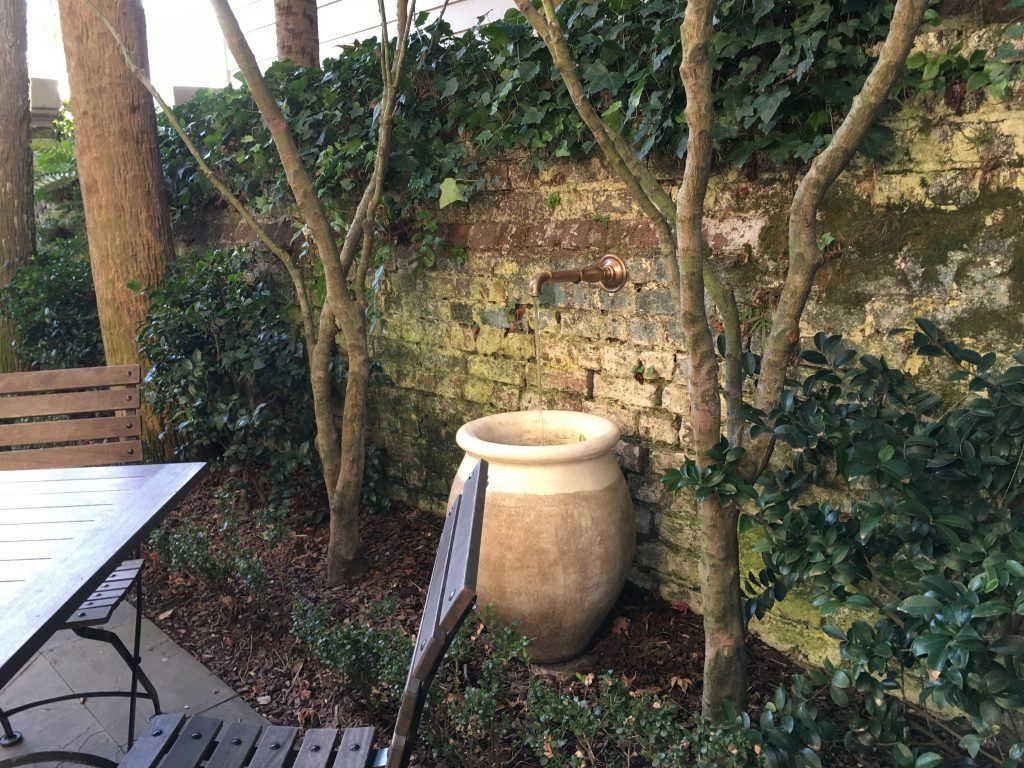
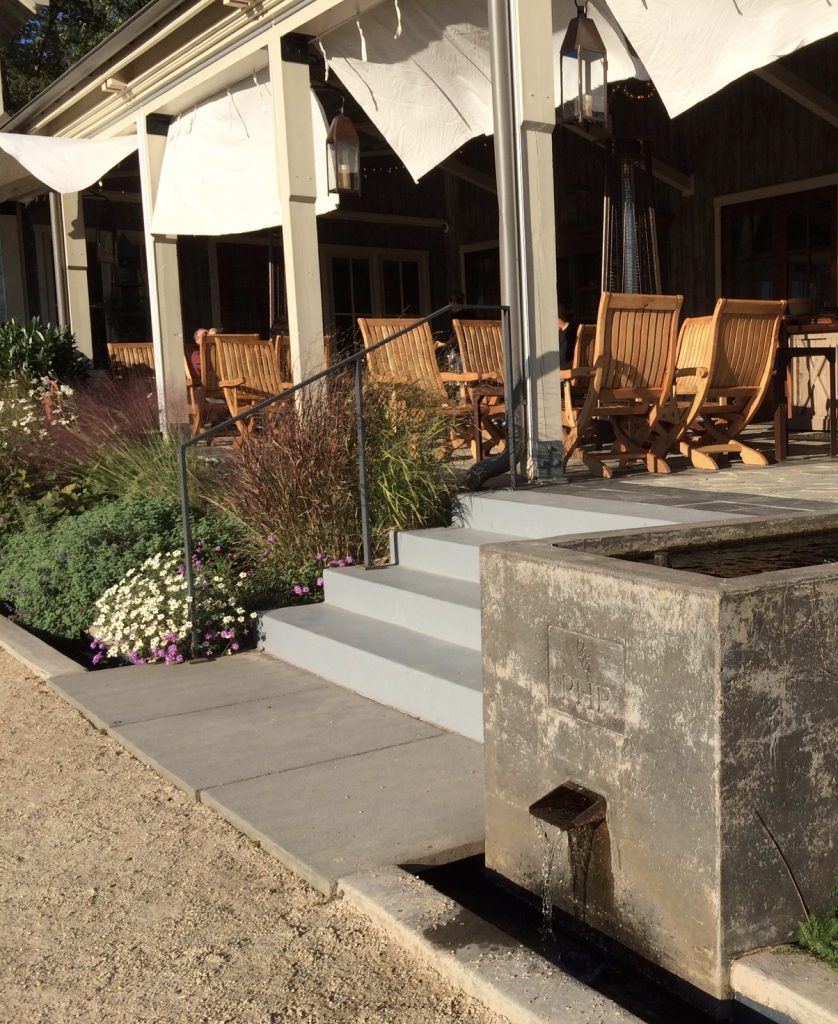
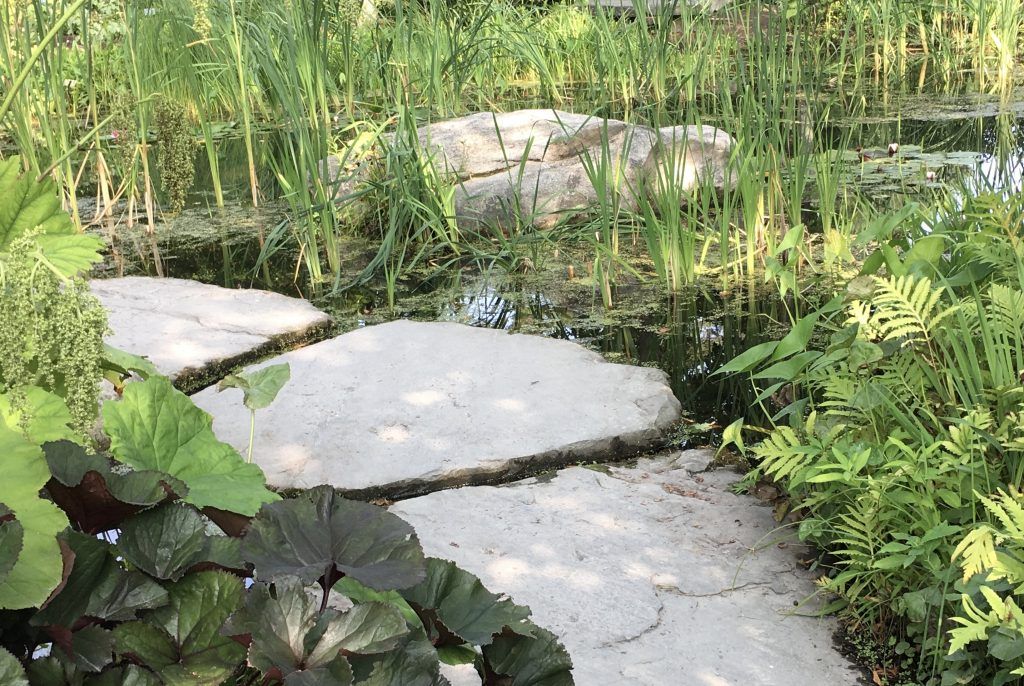
FRAMING AN ENTRANCE OR VIEW
Transitions are critical in a garden. Incorporate a gate, arbor or other feature that beckons to highlight the movement from one garden space to another.
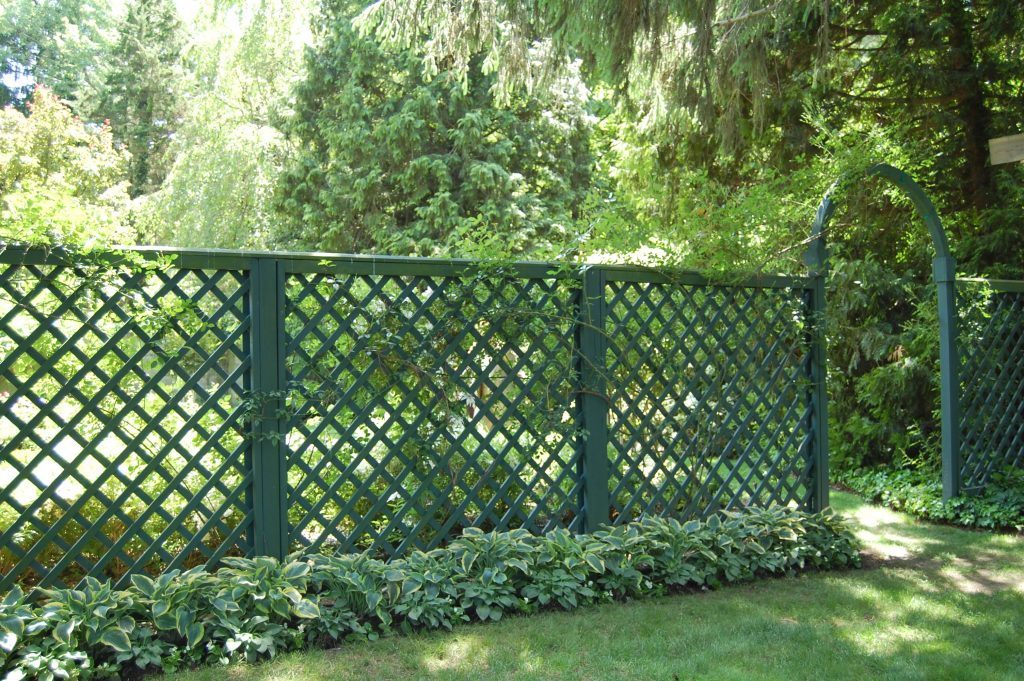
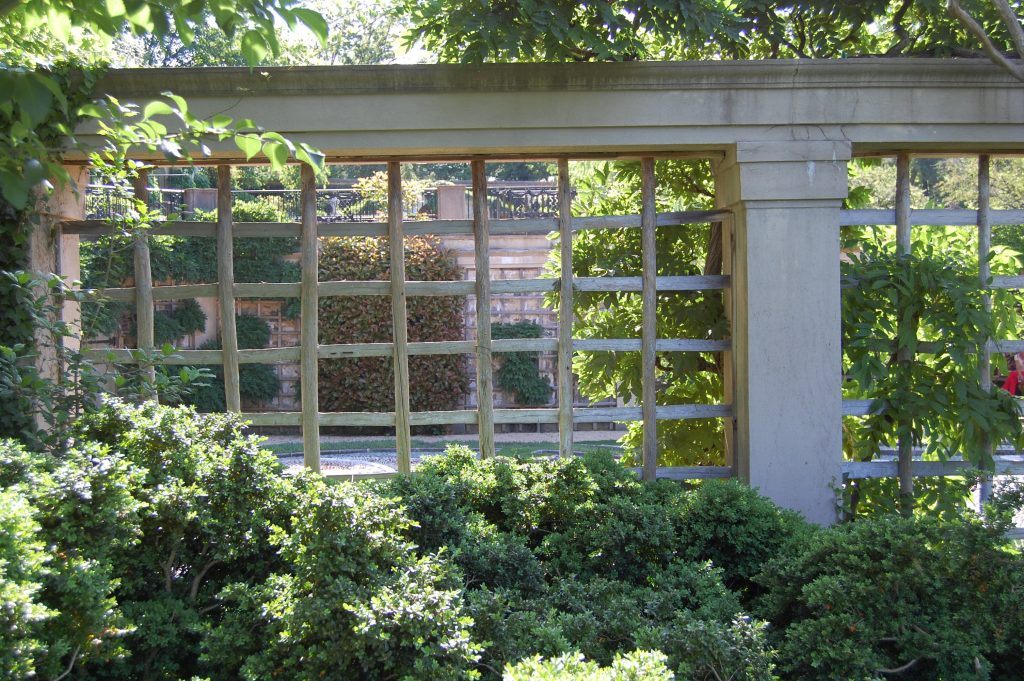
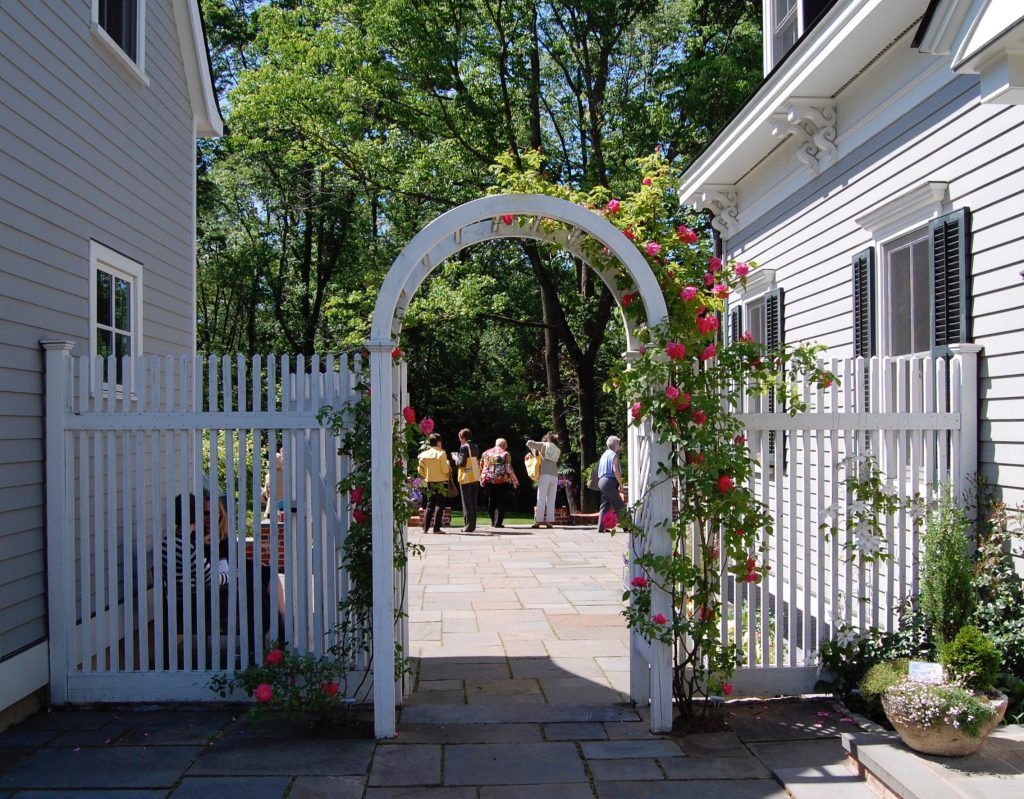
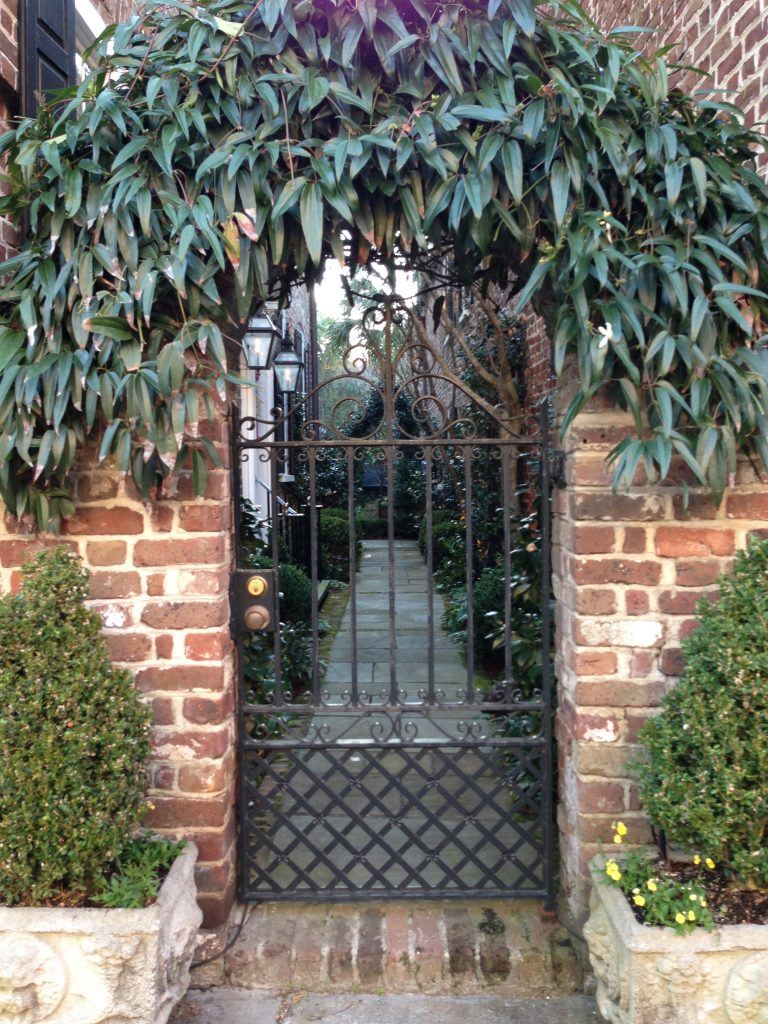
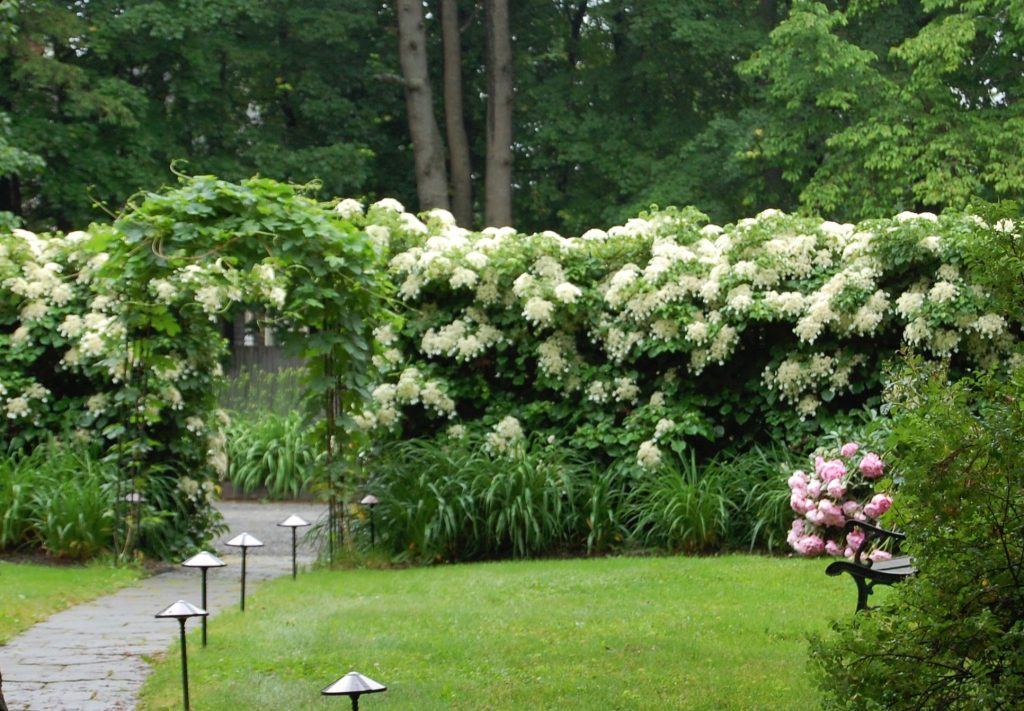
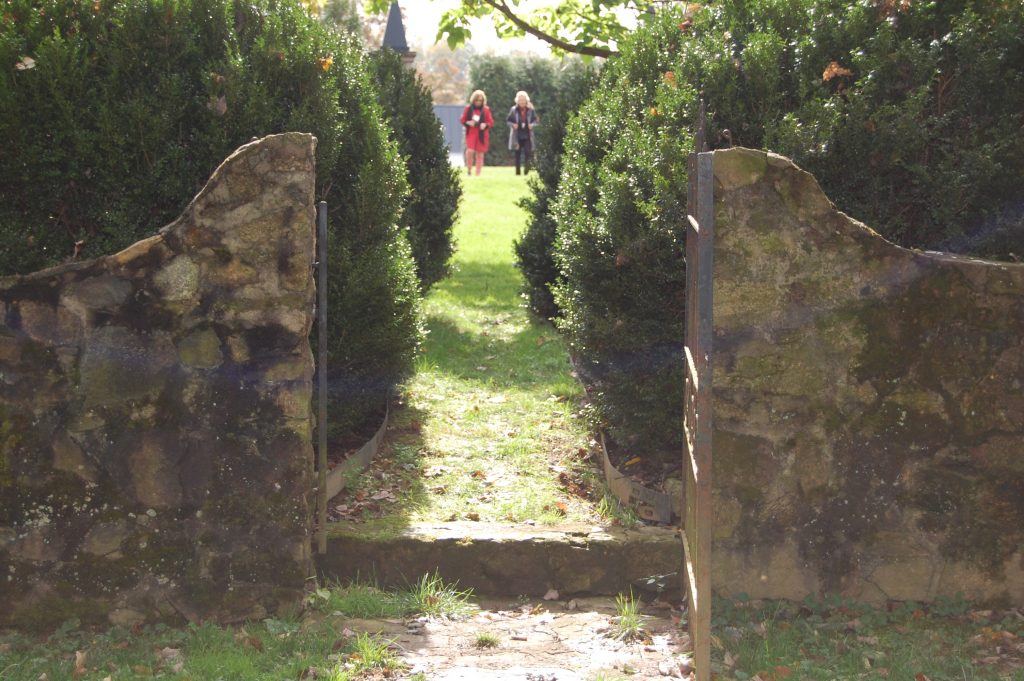
WALLS
Even the slightest change in grade in a garden is an opportunity to introduce a beautiful wall. Plants are always enhanced when enveloped by a wall made of natural materials.
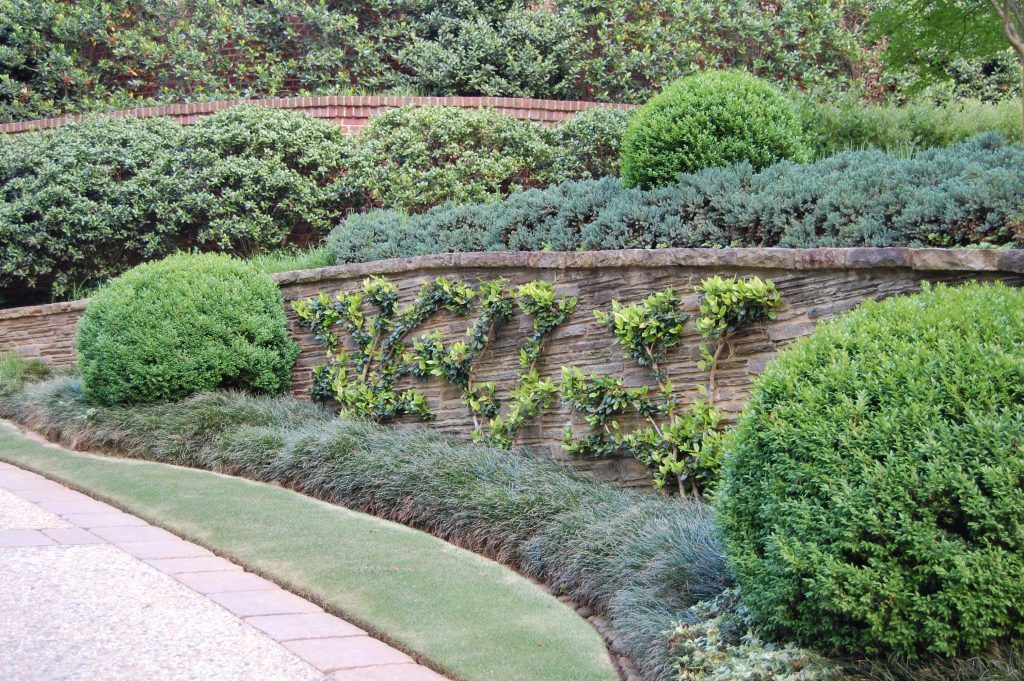
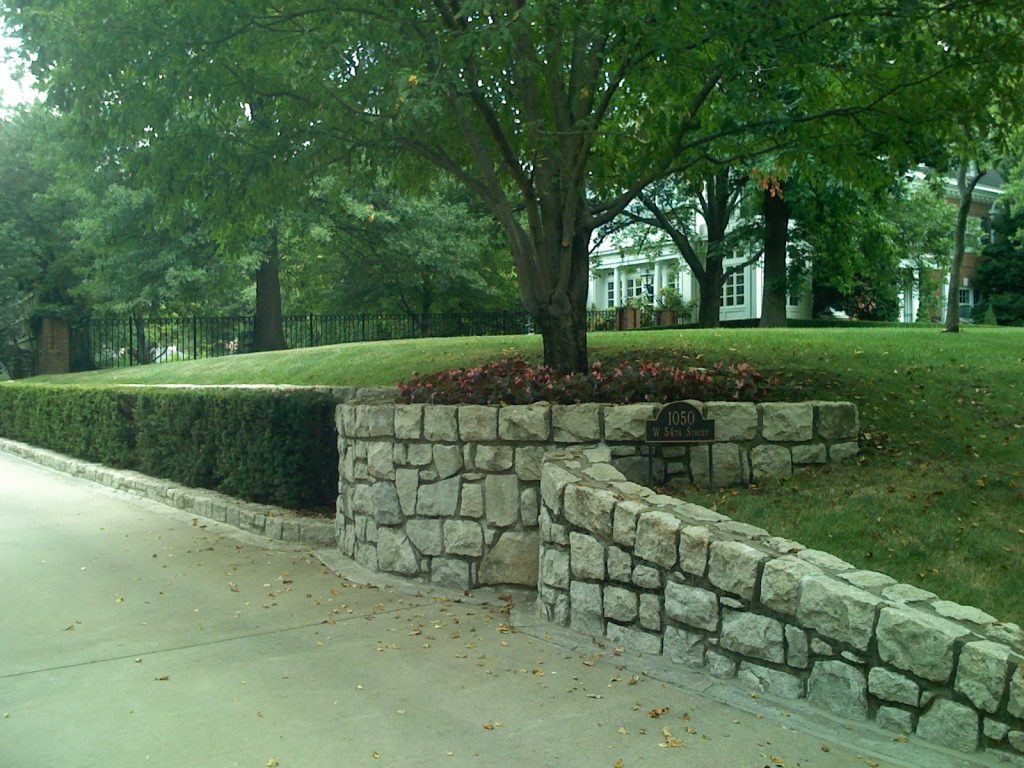
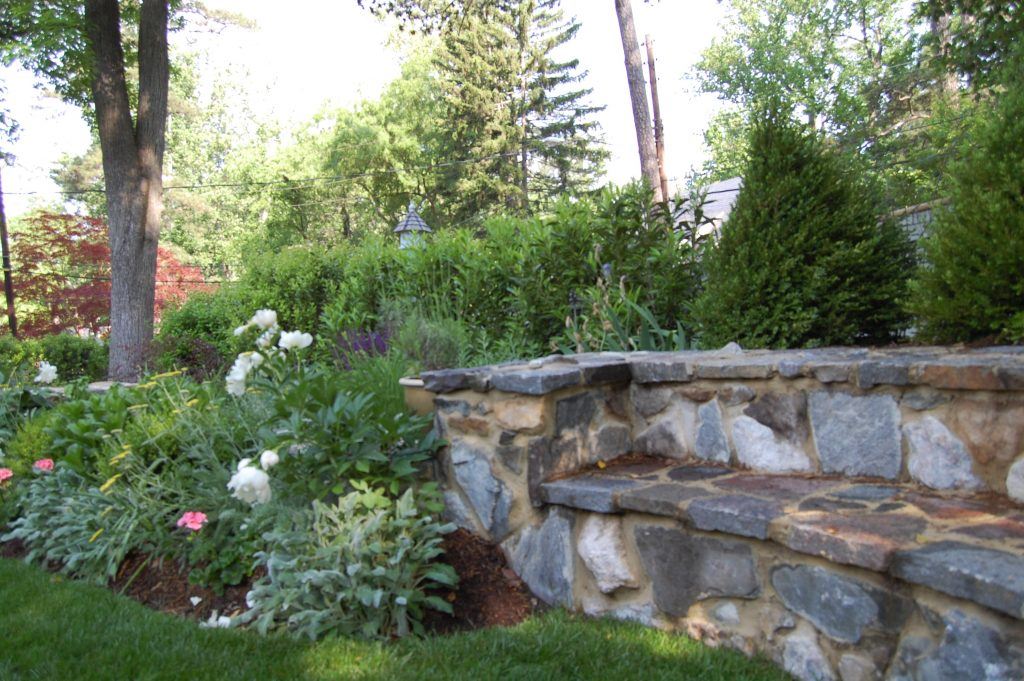
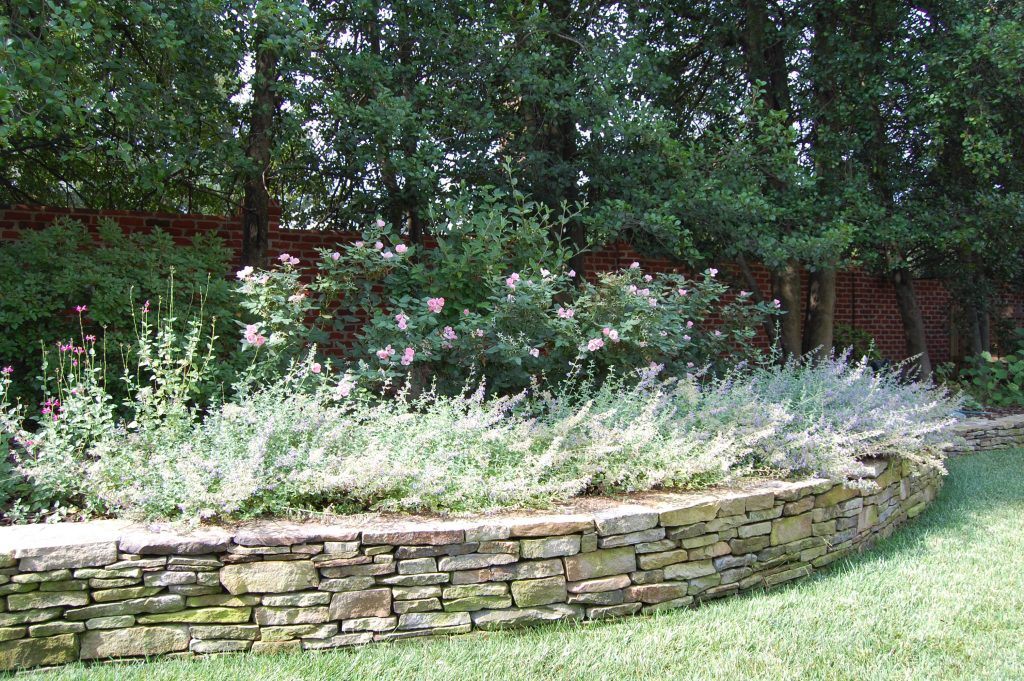
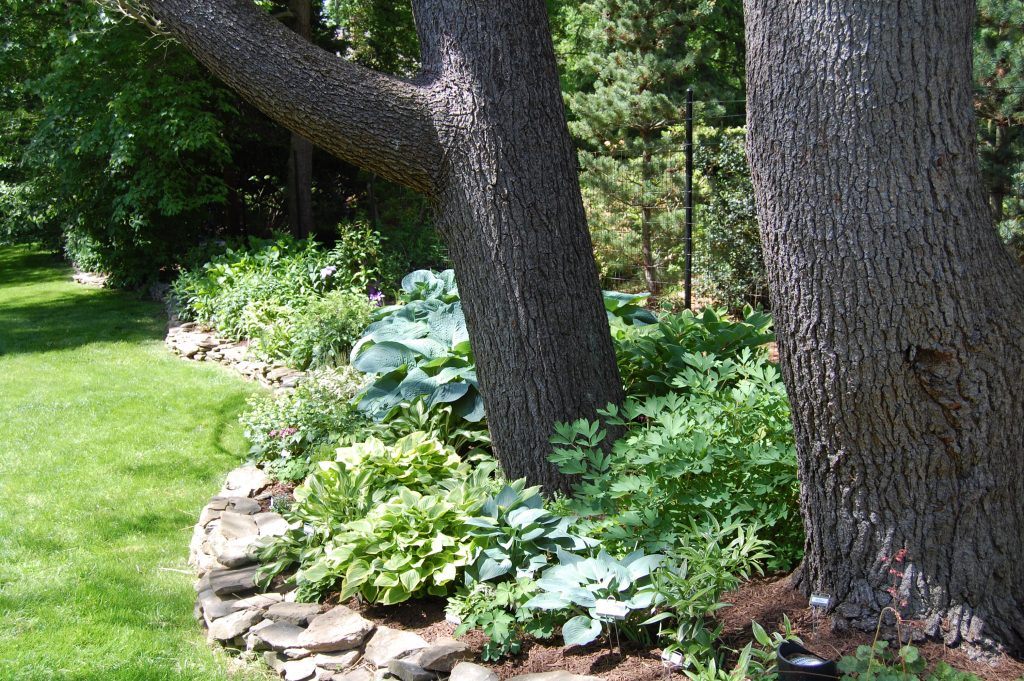
WALKWAYS
Circulation is the thread that holds a garden together. A garden should lead us from one space to another, sometimes subtly, other times audaciously. There is a hierarchy in landscape walkways. Broad paths, usually mortared, signal direction to a main entrance. Stepping stones set in the turf or garden bed lure the garden lover or the curious to, quite literally, get off the beaten path and explore.
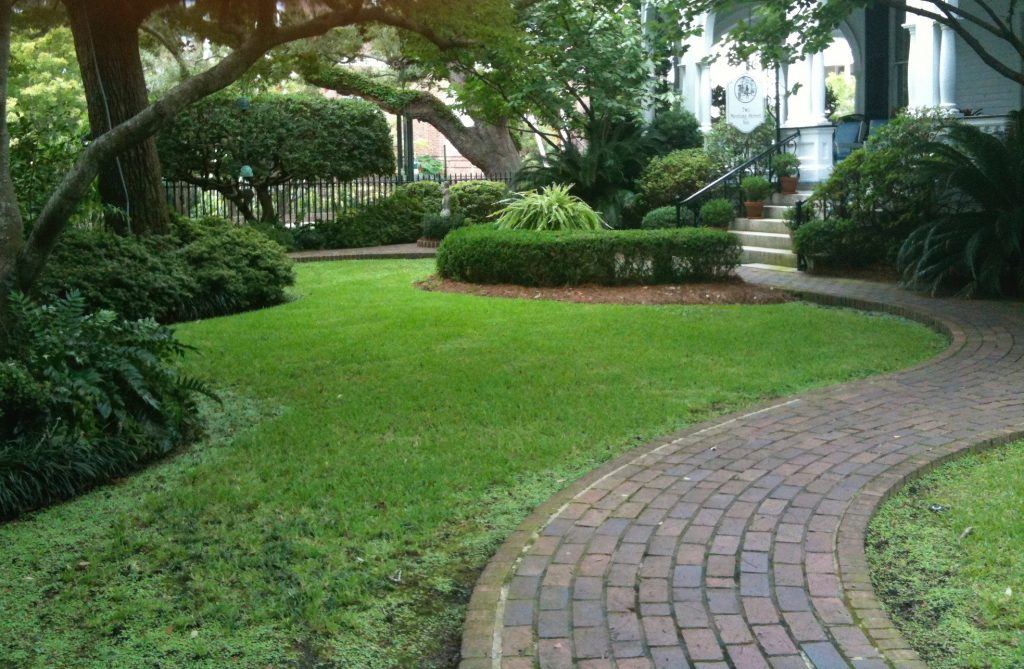
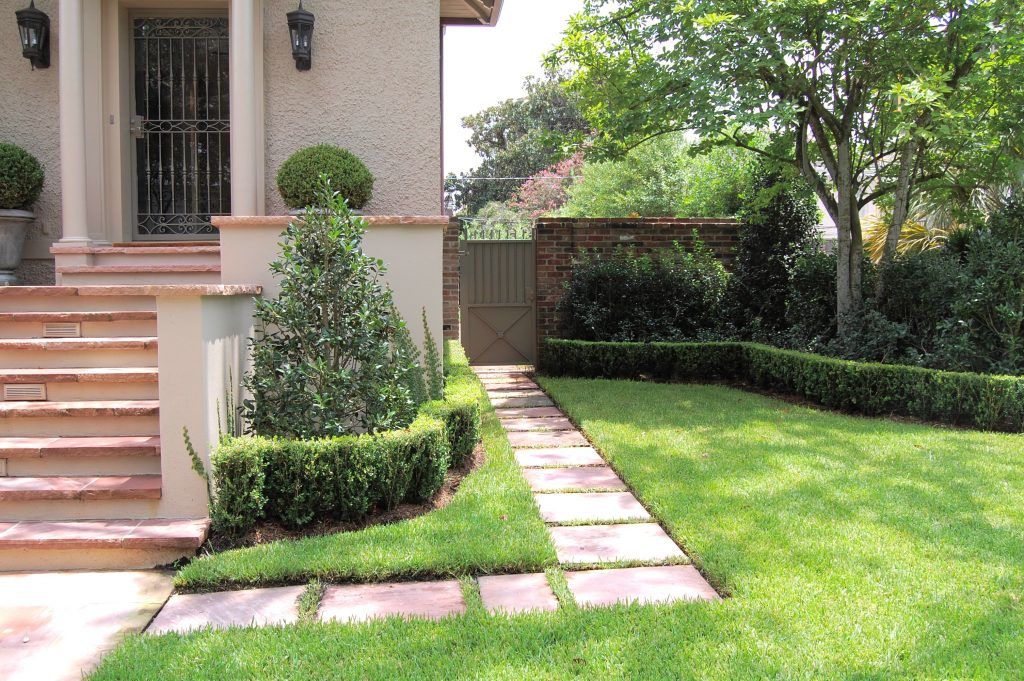
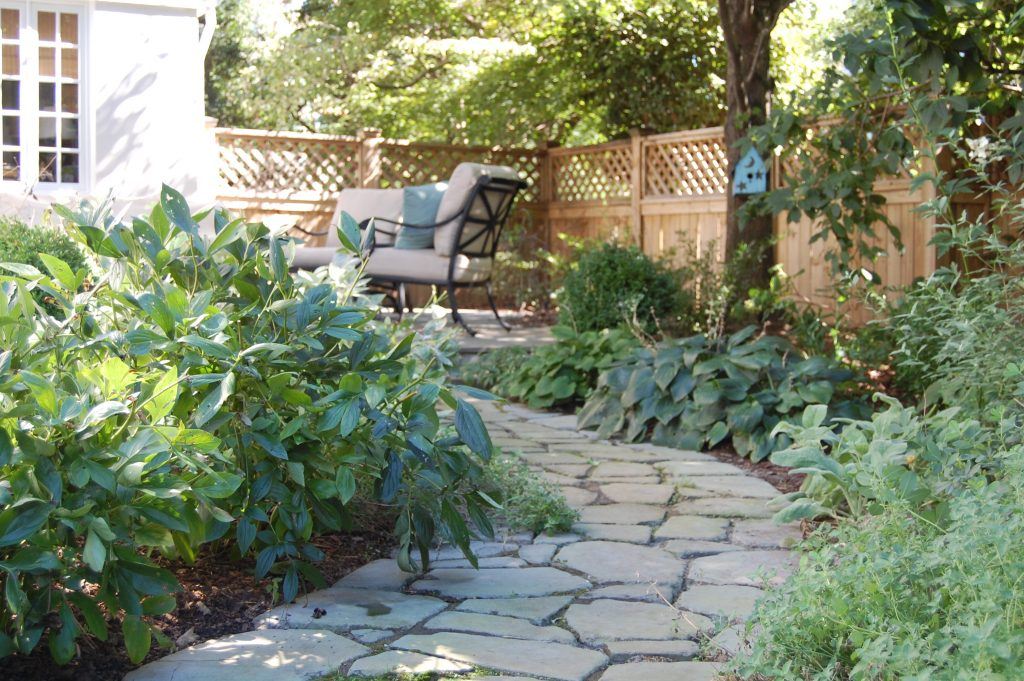
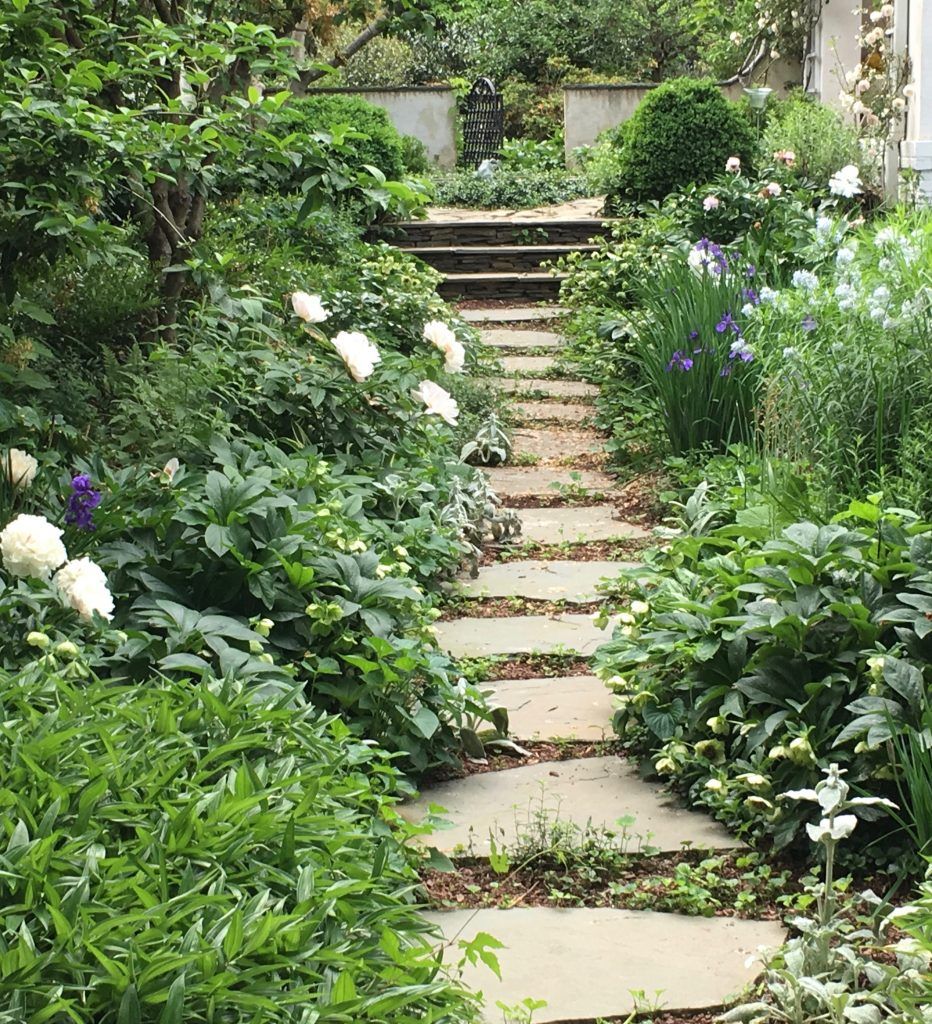
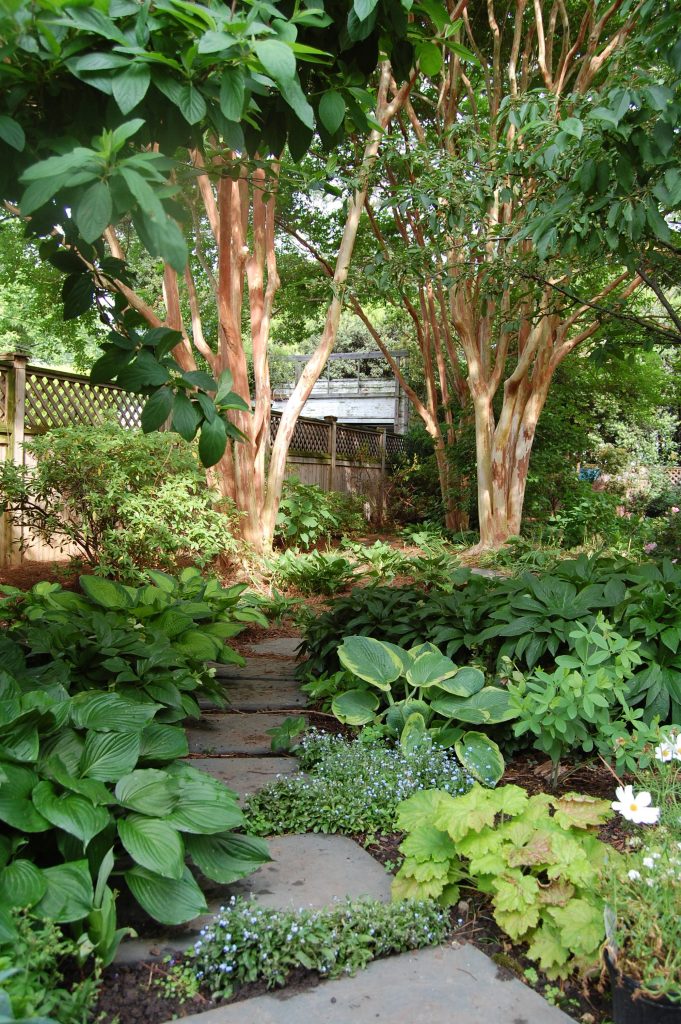
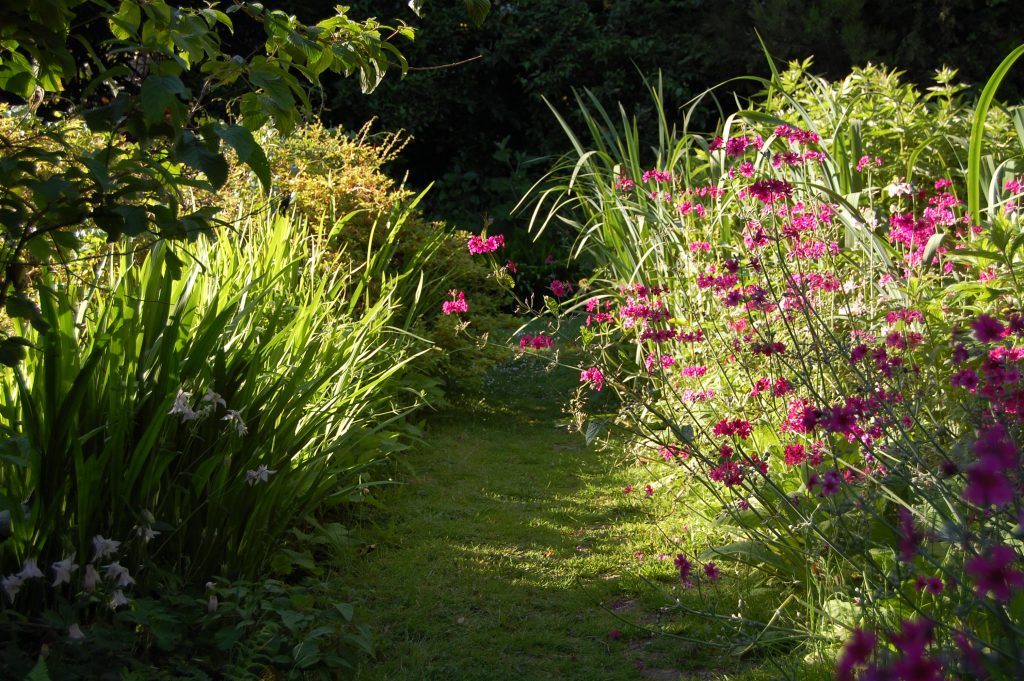
FOCAL POINT
A well-designed landscape uses focal points to enhance the garden’s structure. A focal point can be a seat, an urn or some other garden ornament. It can be on an obvious axial point, or more subtly tucked into a corner of the garden.
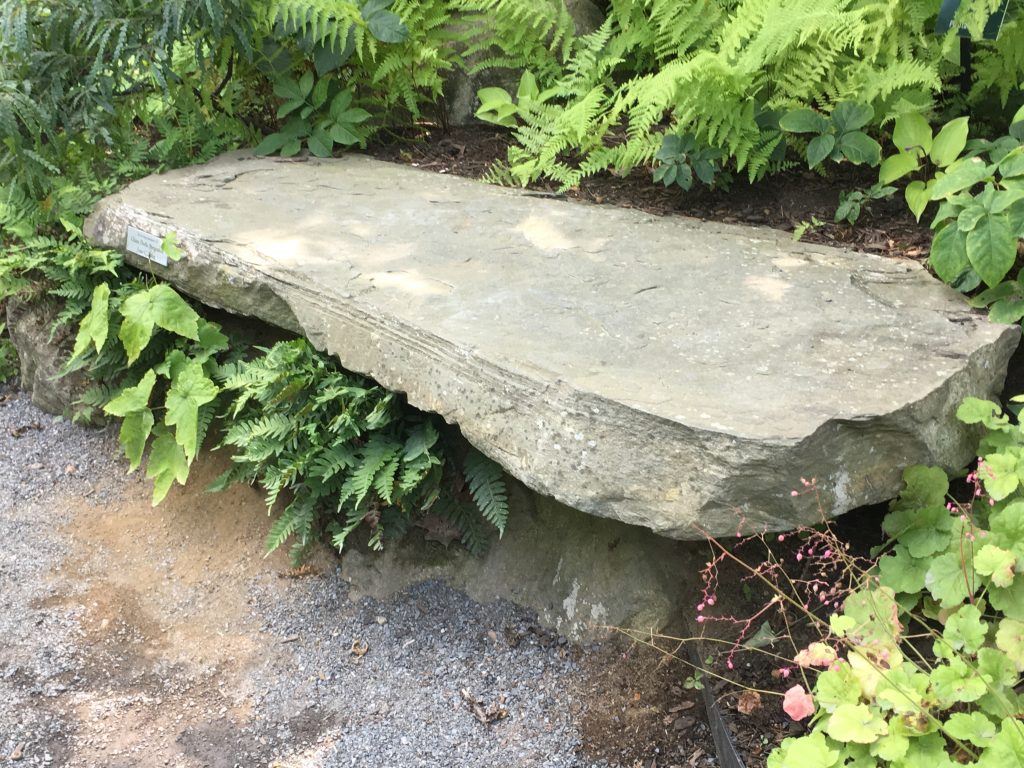
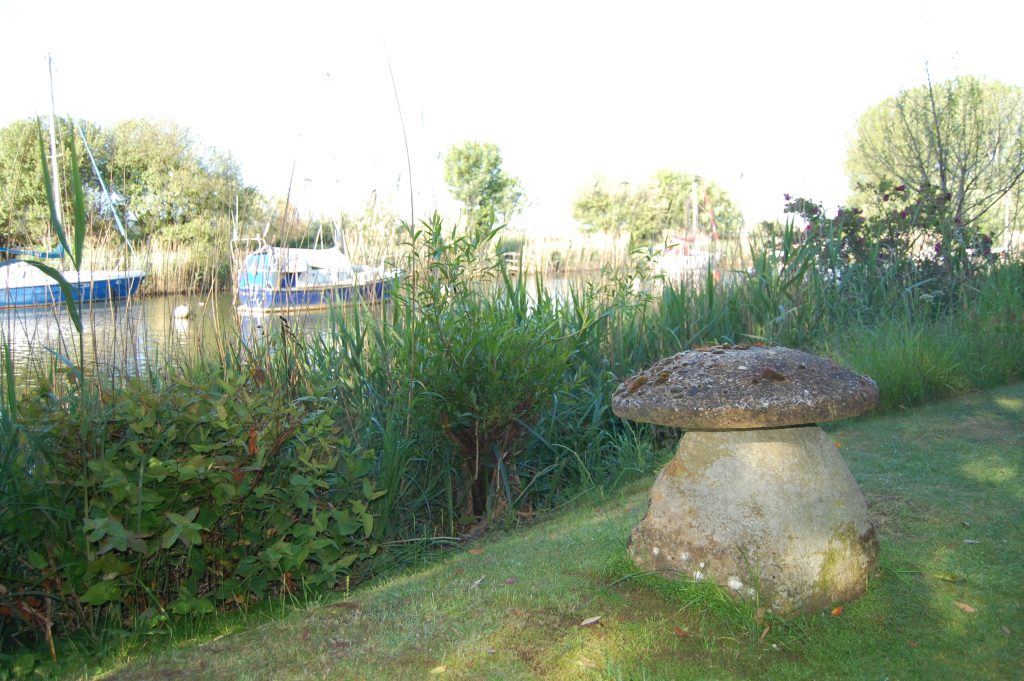
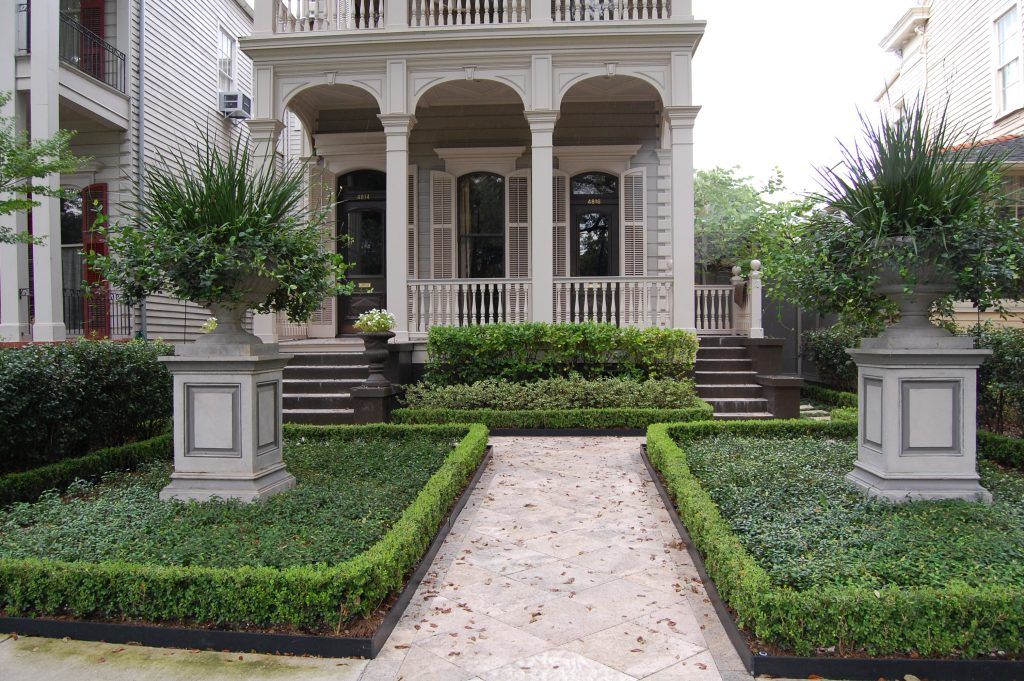
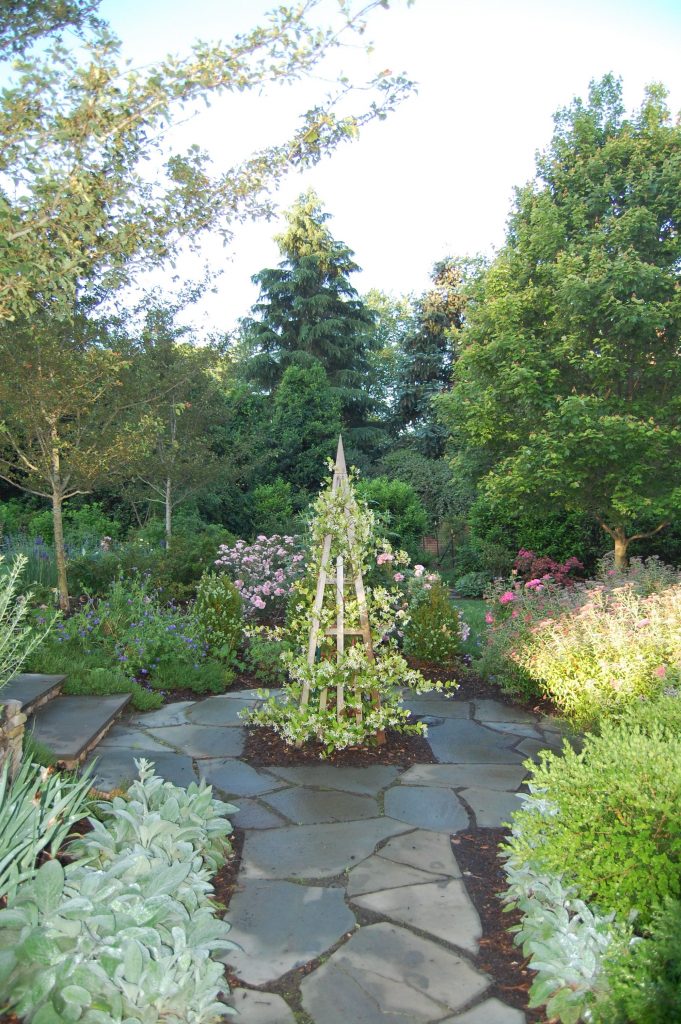
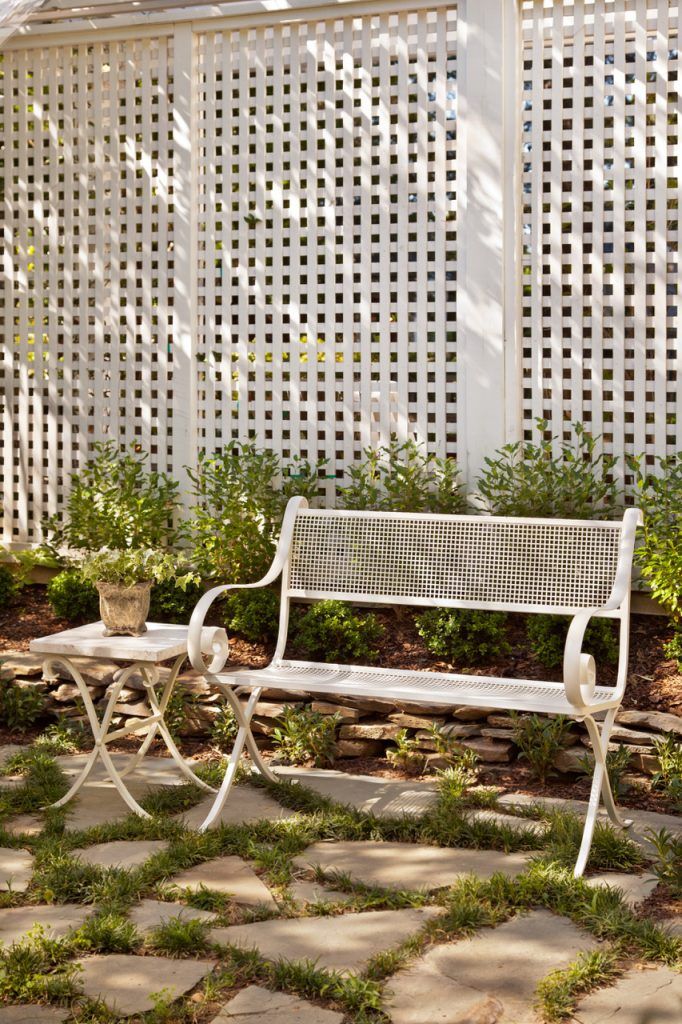
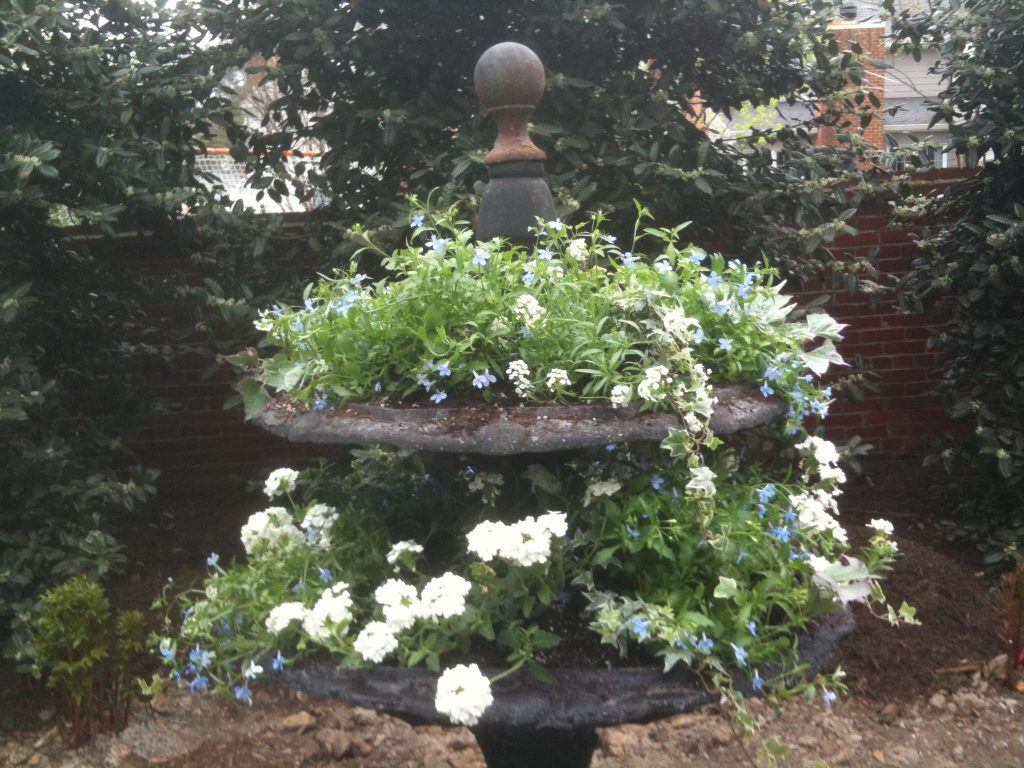
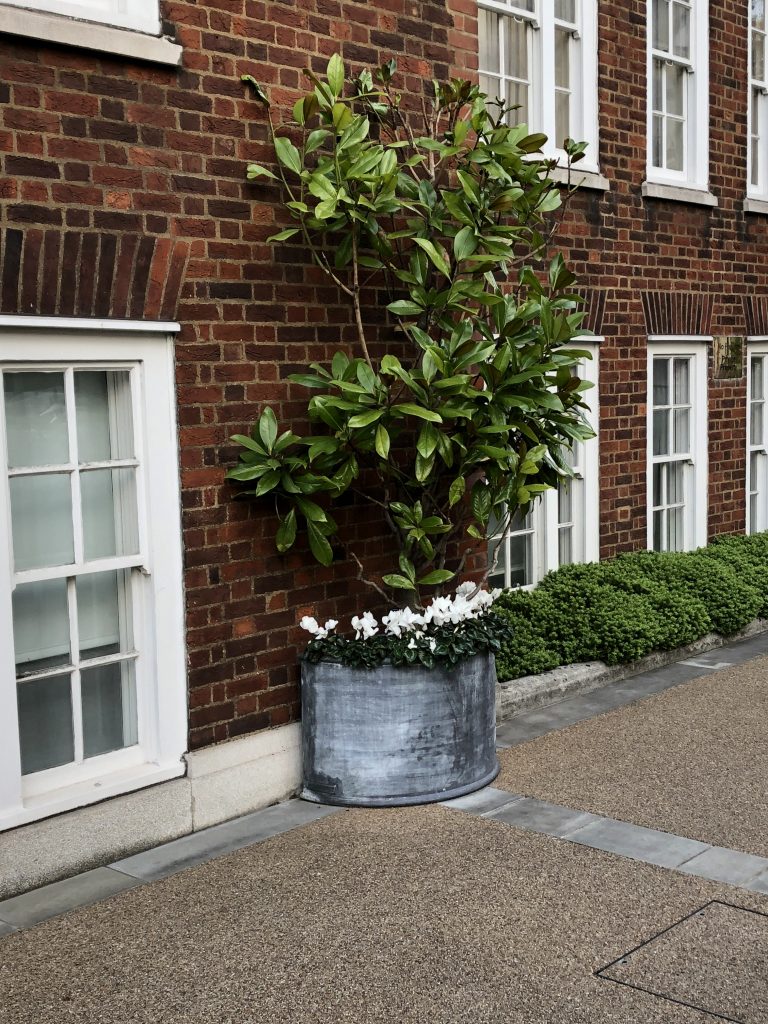
[custom-related-posts title=”Related Posts” none_text=”None found” order_by=”title” order=”ASC”]
PLANTS TO GROW FOR BEAUTIFUL GARDENS AND STUNNING ARRANGEMENTS
With the Garden Club of Virginia’s annual Historic Garden Week tours upon us, here are a few suggestions for plants you can grow and use in arrangements like those you see on tour. I highlight four arrangements here that were created for last year’s tour by the talented gardeners and arrangers Susan Robertson, Margy Brown, Ida Farinholt, Sally Ellington and Gretchn Japhet. Almost all of the plants used in the arrangements came from their own and others’ gardens.
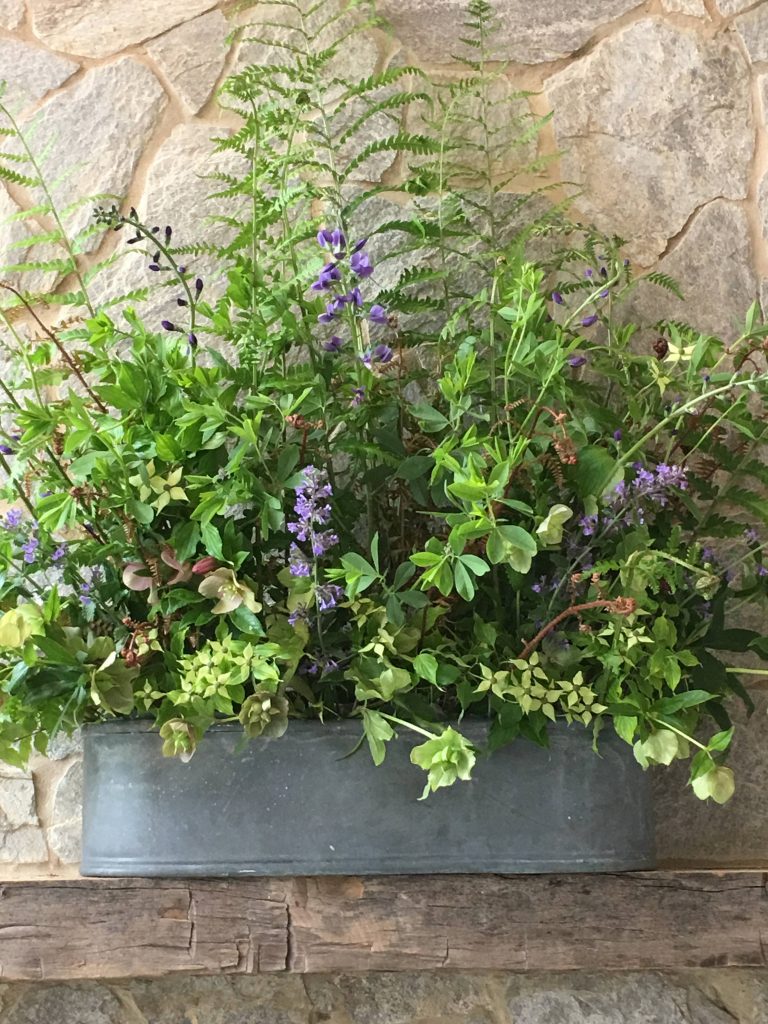
The mantel arrangement above is like a Virginia spring garden that snuck indoors. The backdrop of the stone wall, rough hewn timber mantel and simple galvanized metal container is perfect for the natural arrangement displaying many native plants. Included in the arrangement are false indigo (Baptisia australis, native), kousa dogwood (Cornus kousa — it’s cousin, Cornus florida, is native), lenten rose (Helleborus orientalis), dixie wood fern (Dryopteris x australis, native), Autumn Fern (Dryopteris erythrosora), the foliage of coral honeysuckle (Lonicera sempervirens, native) and Catmint (Nepeta x faassenii).
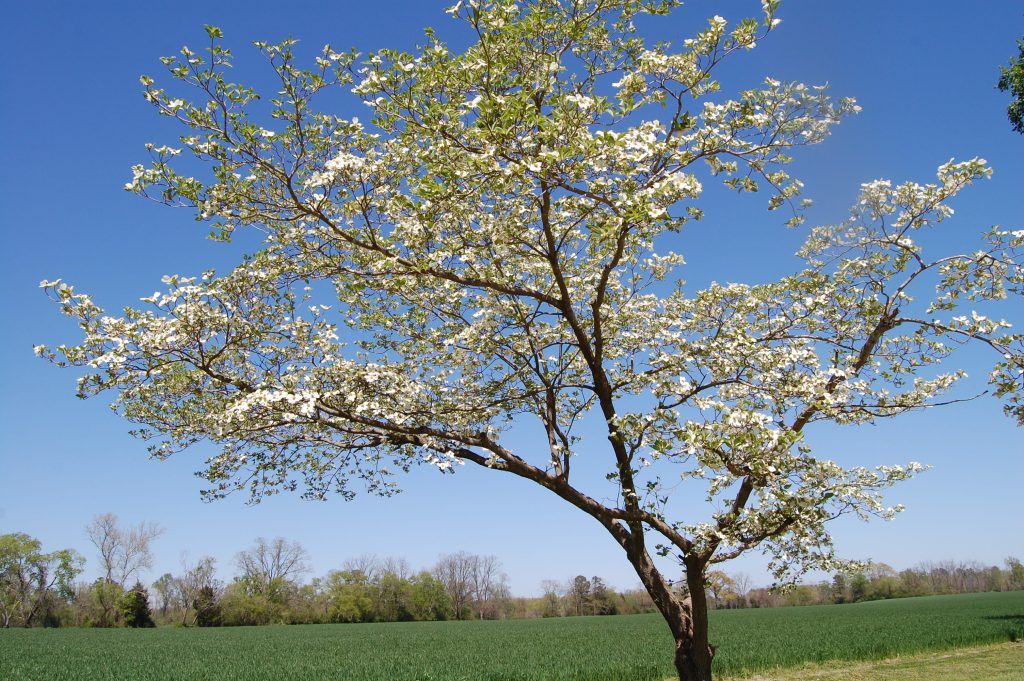 Kousa dogwood was used in the arrangement, but the native flowering dogwood, which flowers earlier and before it leafs out, is a fantastic choice for your garden. Kousa dogwood, native to China, supports no insect herbivores. Our native dogwood supports 117 species of moth and caterpillar as well as many other insects. http://www.bringingnaturehome.net/gardening-for-life.html
Kousa dogwood was used in the arrangement, but the native flowering dogwood, which flowers earlier and before it leafs out, is a fantastic choice for your garden. Kousa dogwood, native to China, supports no insect herbivores. Our native dogwood supports 117 species of moth and caterpillar as well as many other insects. http://www.bringingnaturehome.net/gardening-for-life.html
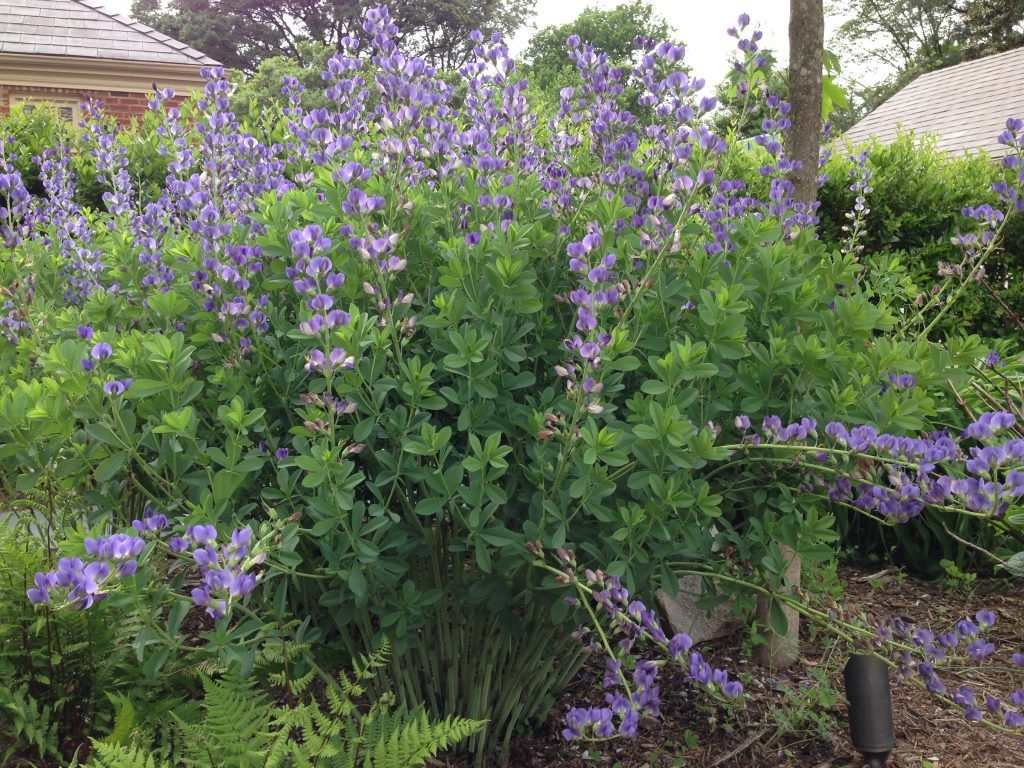 False Indigo, with its sweet pea-like flowers, is native, prefers part sun, and is attractive for its foliage and bloom.
False Indigo, with its sweet pea-like flowers, is native, prefers part sun, and is attractive for its foliage and bloom.
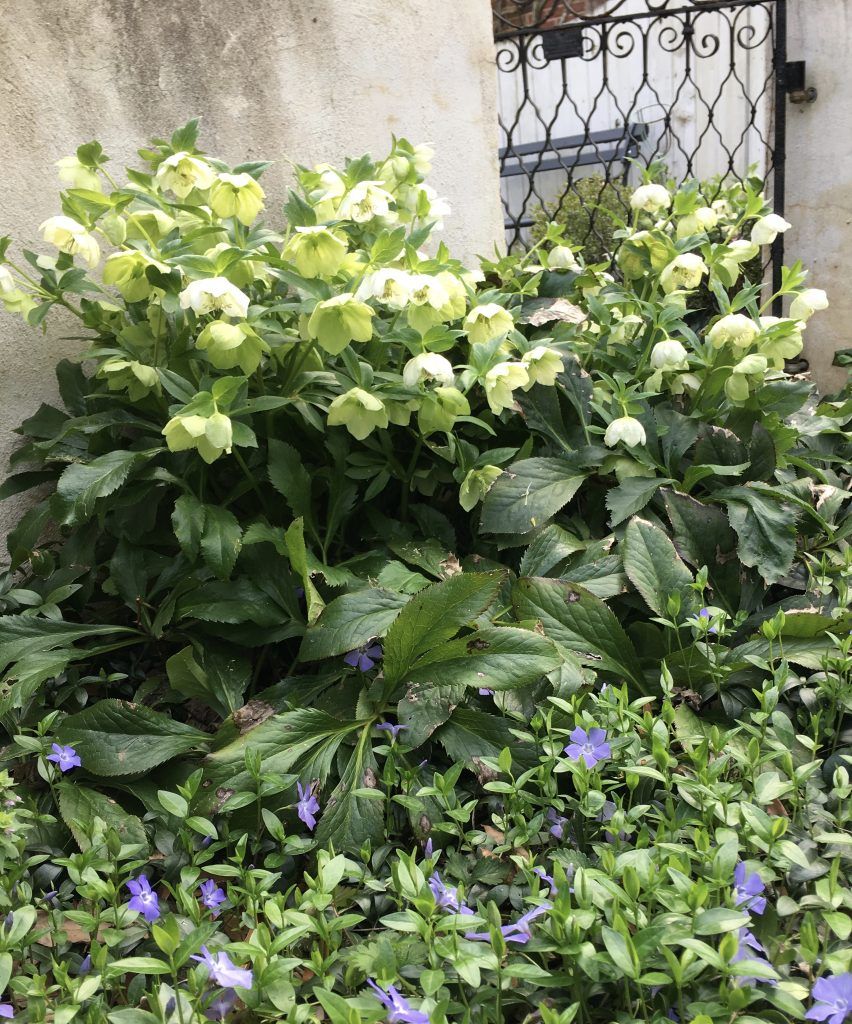 Lenten Rose is one of my favorite plants. It is evergreen, the blooms (actually the bracts), persist for up to three or four months, and it happily, but not aggressively, self-seeds. It is happiest in part shade or shade.
Lenten Rose is one of my favorite plants. It is evergreen, the blooms (actually the bracts), persist for up to three or four months, and it happily, but not aggressively, self-seeds. It is happiest in part shade or shade.
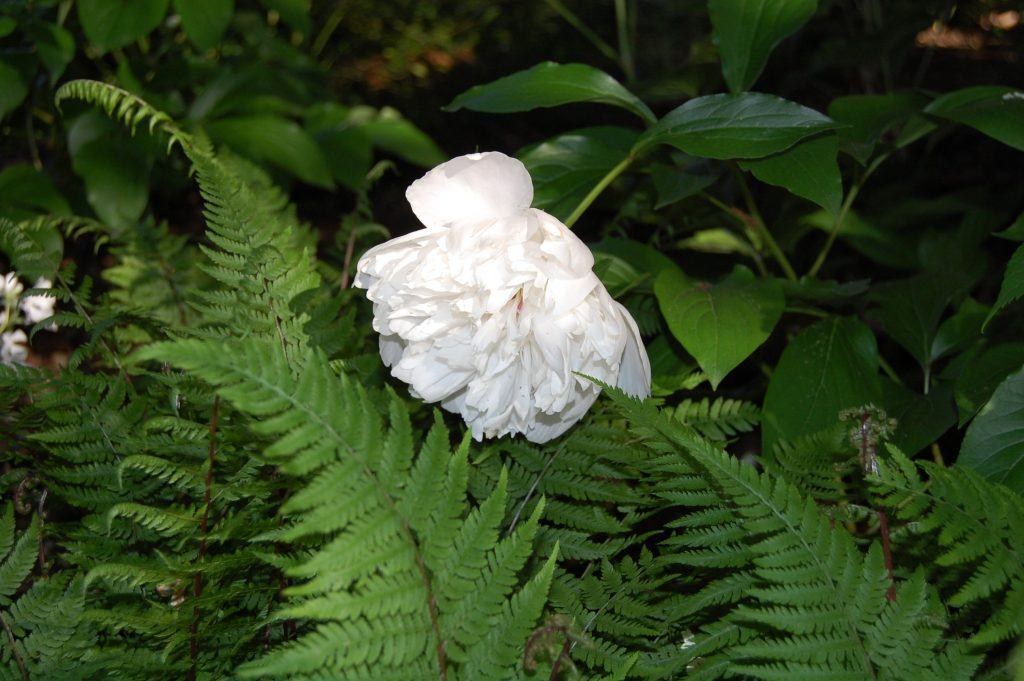 The native Dixie wood fern and the young (red) fiddlers of autumn fern were used in the arrangement. Another lovely fern, which is native, is Lady Fern (Athyrium filix-femina). It is more delicate than most ferns, but provides an airy sweep in the garden.
The native Dixie wood fern and the young (red) fiddlers of autumn fern were used in the arrangement. Another lovely fern, which is native, is Lady Fern (Athyrium filix-femina). It is more delicate than most ferns, but provides an airy sweep in the garden.
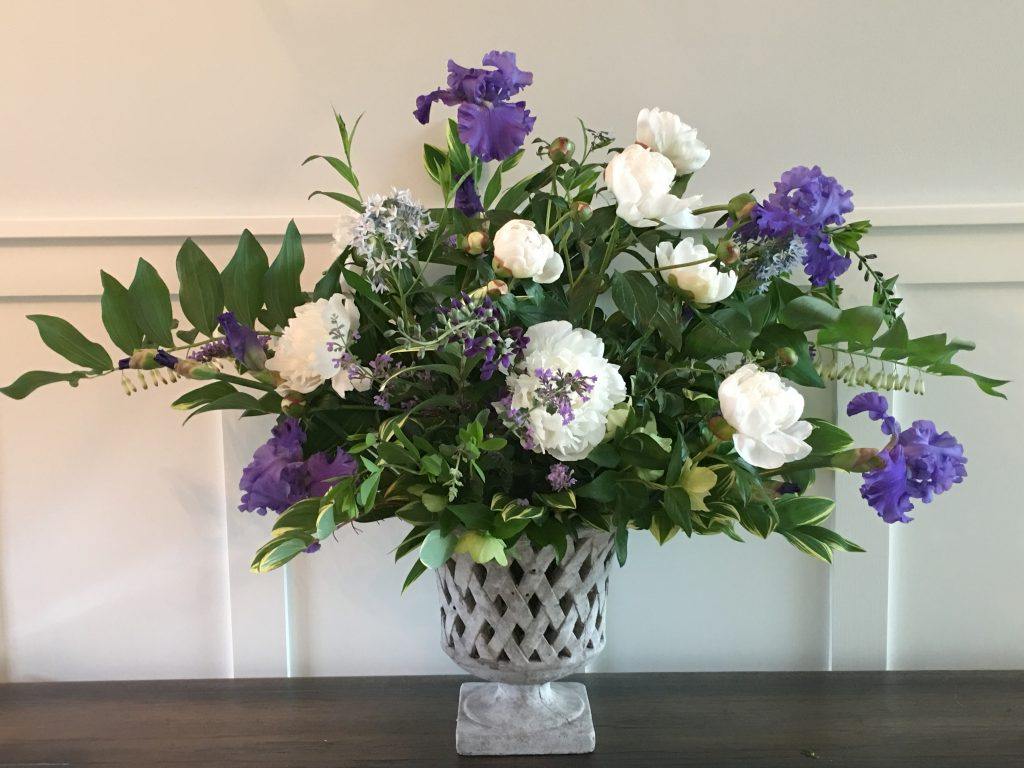 The greens in the arrangement above allow the spectacular peonies (Paeonia latifolia) and bearded iris (Iris germanica) to stand out. Supporting players are both the native solomon’s seal (Polygonatum biflorum var. commutatum and it’s variegated cousin (Polygonatum odoratum var. pluriflorum ‘Variegatum’), false indigo, lenten rose, and blue star (Amsonia tabernaemontana).
The greens in the arrangement above allow the spectacular peonies (Paeonia latifolia) and bearded iris (Iris germanica) to stand out. Supporting players are both the native solomon’s seal (Polygonatum biflorum var. commutatum and it’s variegated cousin (Polygonatum odoratum var. pluriflorum ‘Variegatum’), false indigo, lenten rose, and blue star (Amsonia tabernaemontana).
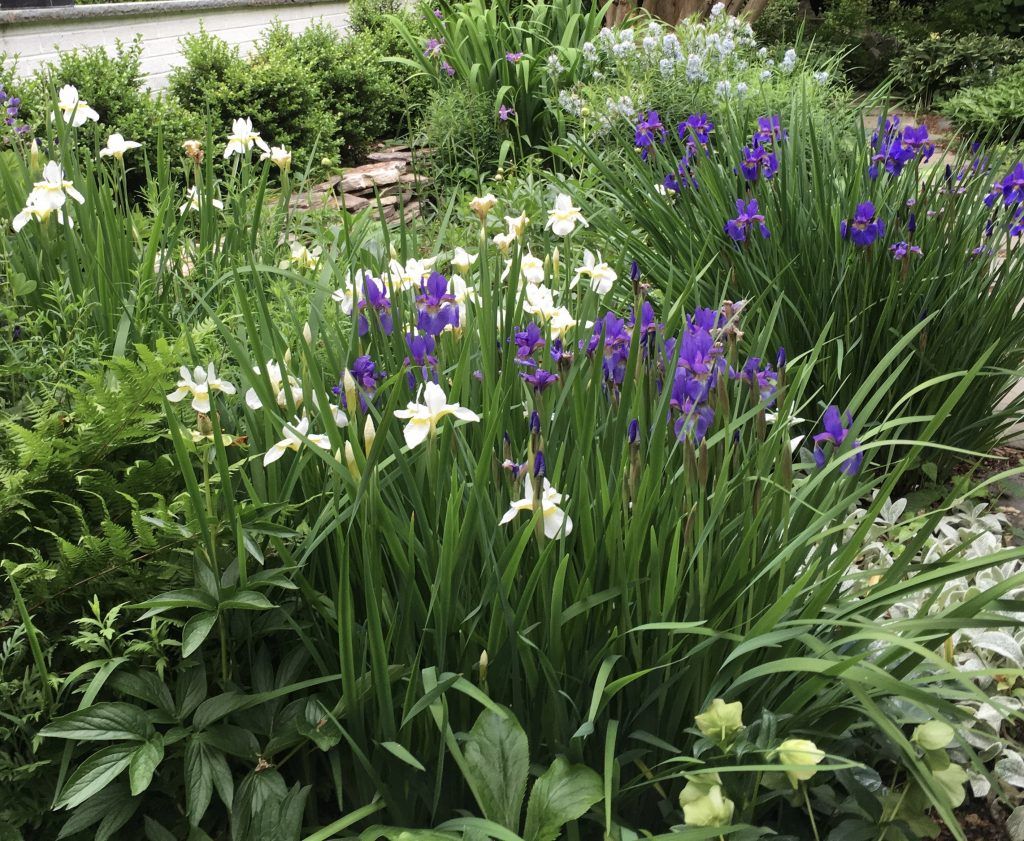 The iris used in the arrangement is bearded iris. Above are two siberian iris cultivars (Iris siberica ‘Caesar’s Brother’ and ‘Butter and Sugar’). Siberian iris, as well as the native blue flag iris (Iris versicolor) will tolerate wet soil conditions. The sword-like foliage provides nice structure in the perennial border when the plant is not in bloom.
The iris used in the arrangement is bearded iris. Above are two siberian iris cultivars (Iris siberica ‘Caesar’s Brother’ and ‘Butter and Sugar’). Siberian iris, as well as the native blue flag iris (Iris versicolor) will tolerate wet soil conditions. The sword-like foliage provides nice structure in the perennial border when the plant is not in bloom.
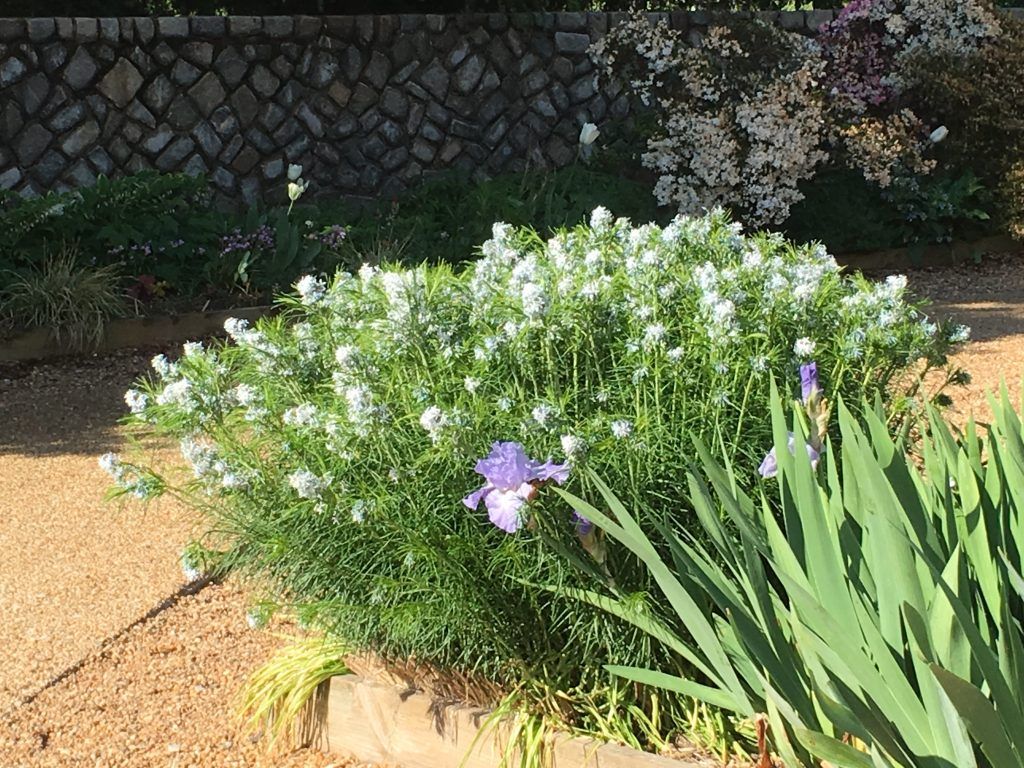
Amsonia hubrichtii (threadleaf bluestar) is pictured above. The native Amsonia tabernaemontana (eastern bluestar) is pictured below with the native blue flag iris). A. hubrichtii has spectacular yellow fall foliage. Amsonias tolerate full sun to part shade, and benefit from having their foliage cut by 1/3 to 1/2 after blooming for less floppy foliage (the foliage will continue to grow).
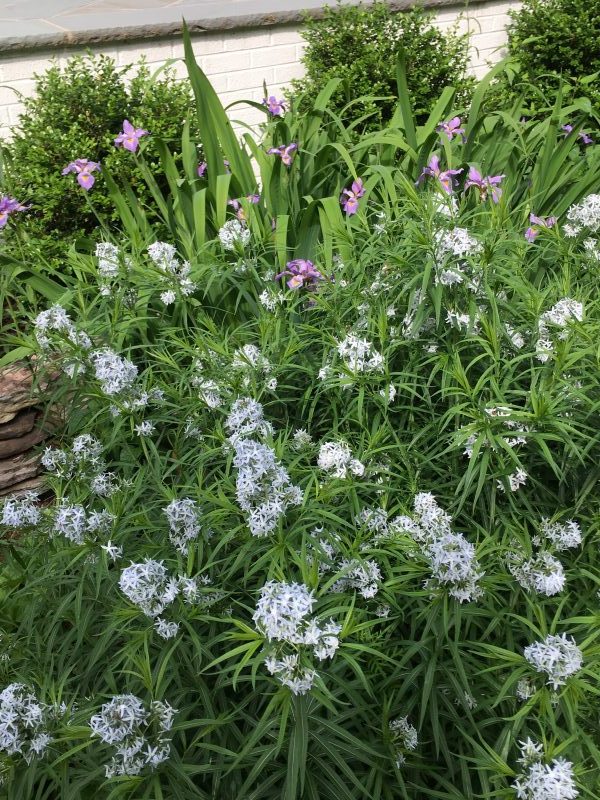
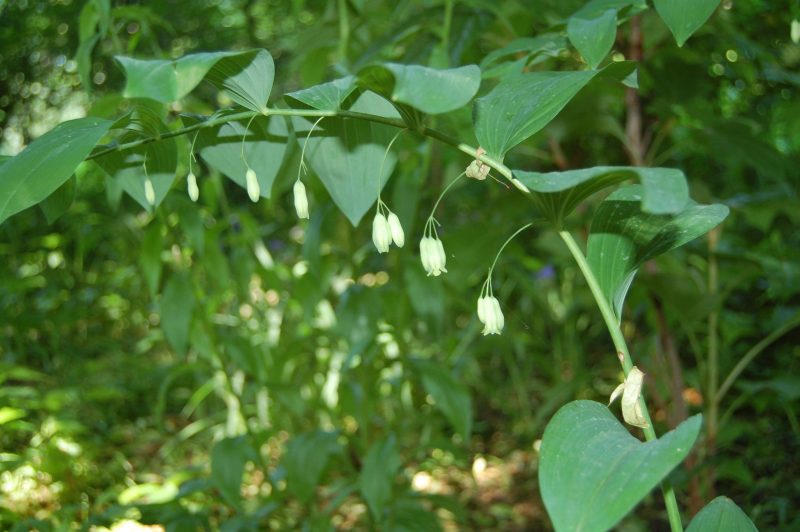
The native Giant Solomon’s Seal, Polygonatum biflorum var. commutatum, can be found in Richmond’s James River Park System. It will tolerate wet soil and prefers shade.
 These bottle bud vases are such a great way to remove the stress of arranging and make use of the bounty of the garden at any given time in the growing season. Early cottage roses and tulips join the catmint, lenten rose and greens for a lovely tableau.
These bottle bud vases are such a great way to remove the stress of arranging and make use of the bounty of the garden at any given time in the growing season. Early cottage roses and tulips join the catmint, lenten rose and greens for a lovely tableau.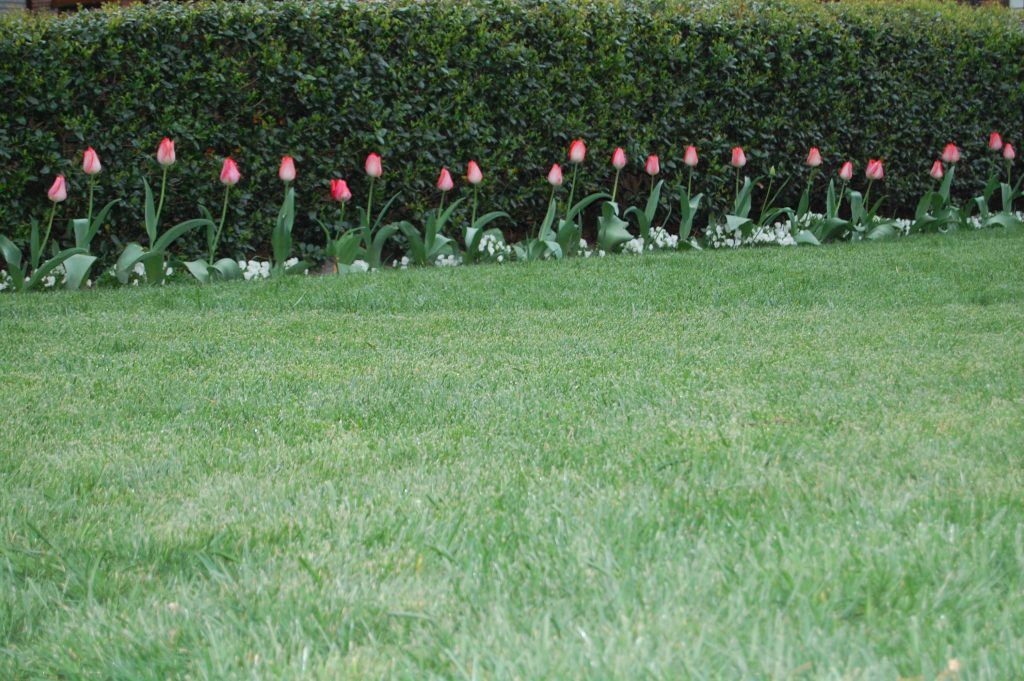 Single tulips underplanted with violas.
Single tulips underplanted with violas.
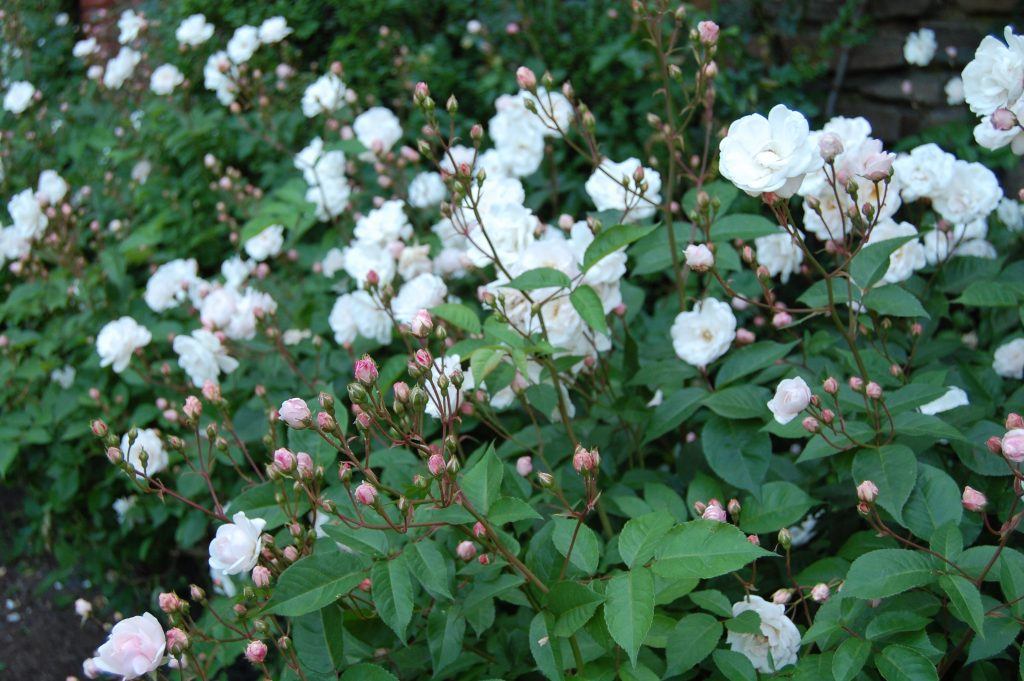 The roses above are in the gardens of Dumbarton Oaks. I’m not sure of the species.
The roses above are in the gardens of Dumbarton Oaks. I’m not sure of the species.
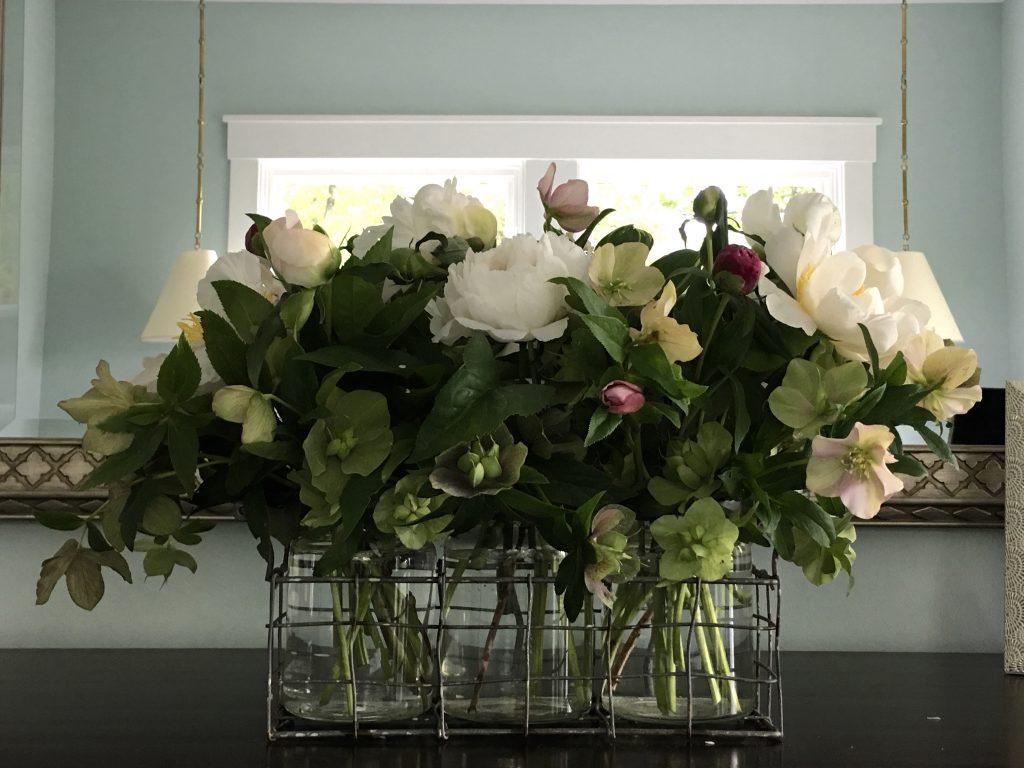 The arrangers took advantage of last year’s early spring, using these gorgeous, billowy peonies, and masterly pulling out the subtle deep and soft pinks of the lenten roses and peony buds.
The arrangers took advantage of last year’s early spring, using these gorgeous, billowy peonies, and masterly pulling out the subtle deep and soft pinks of the lenten roses and peony buds.
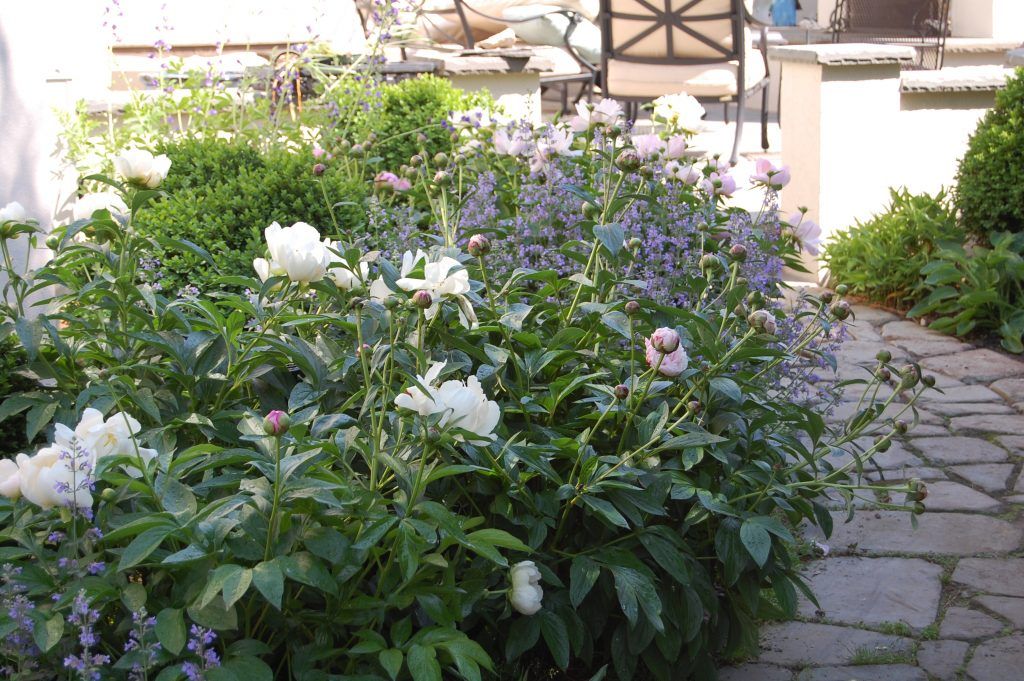
Peonies intermingle happily with catmint, false indigo and boxwood.
[custom-related-posts title=”Related Posts” none_text=”None found” order_by=”title” order=”ASC”]
The Cottage Gardens of the Priory Hotel
When in Dorset, England, make your way to the Priory Hotel in Wareham. The Priory sits quietly along the River Frome in Wareham, and boasts four acres of intoxicating gardens.
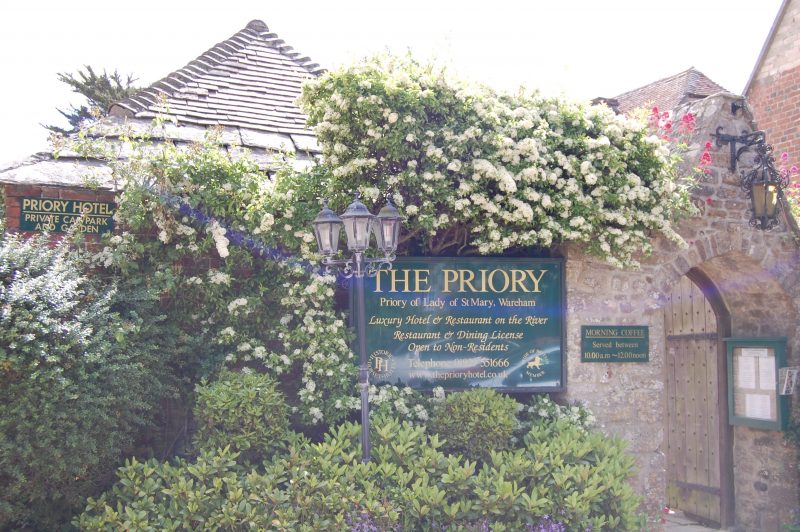
I visited in June, at the height of the perennial show. Below, poppies are just beginning to bloom along the River Frome.
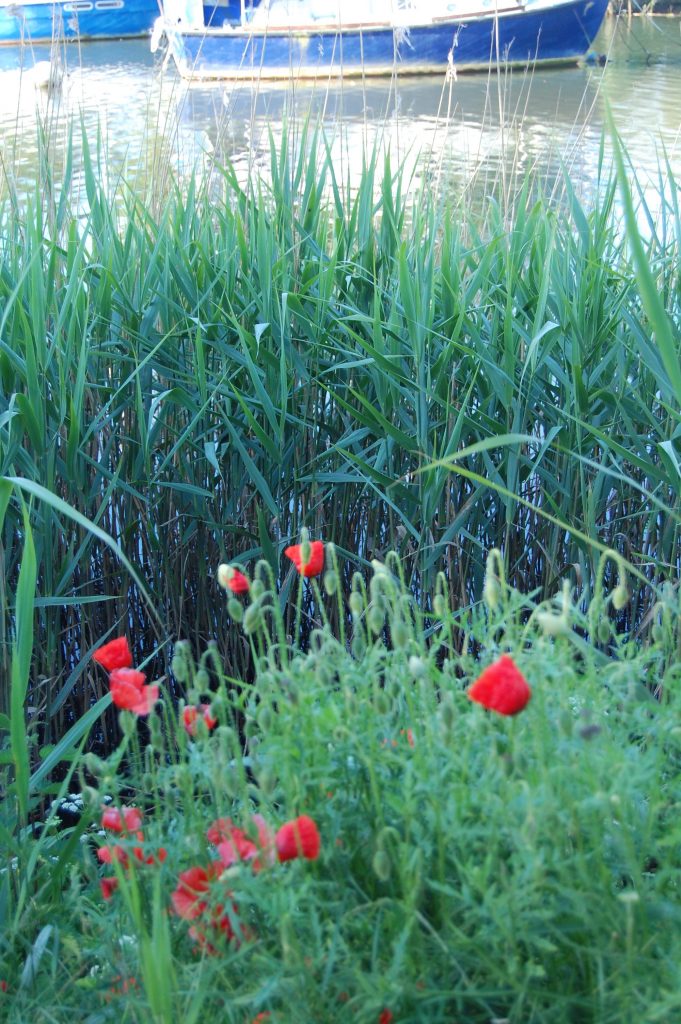
Valerian is ubiquitous in the English countryside. Here, it grows out of stone walls that contain pockets of soil.
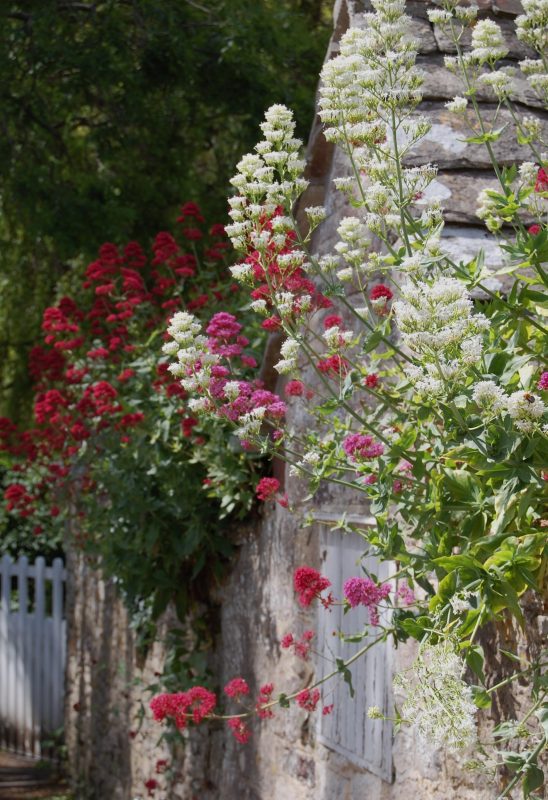
Peonies, framing the lawn and the river terrace, are about to burst into bloom.
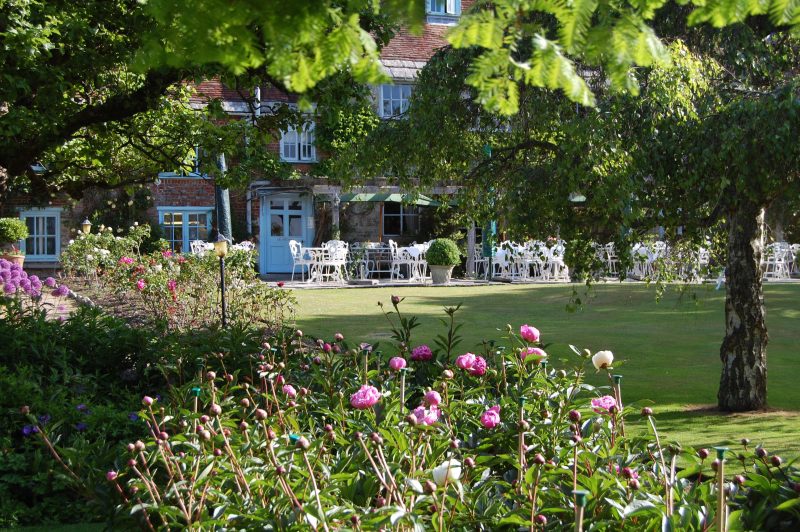
The Priory’s gardens are filled with roses. To support the climbers and other vines. gardeners have constructed beautiful, rustic, sturdy trellises and arbors from local wood.
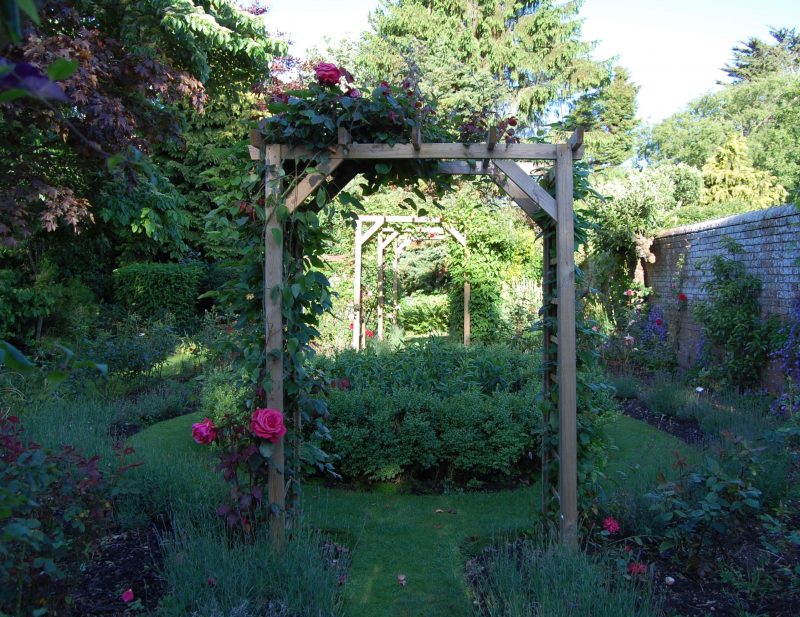
The arbors and fence below are made from local raw timbers.
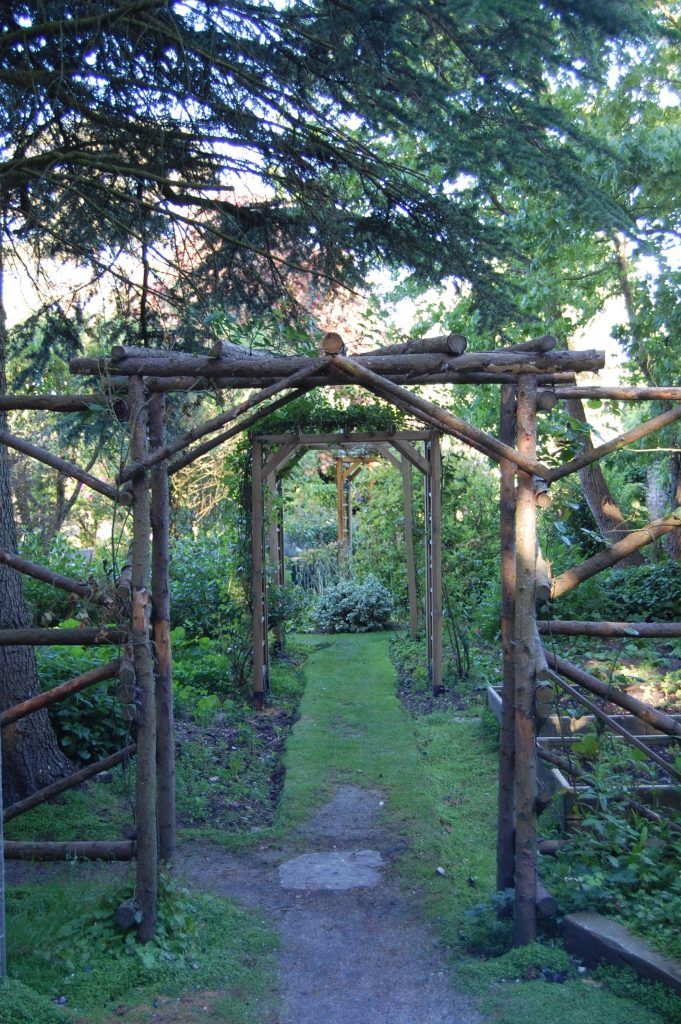
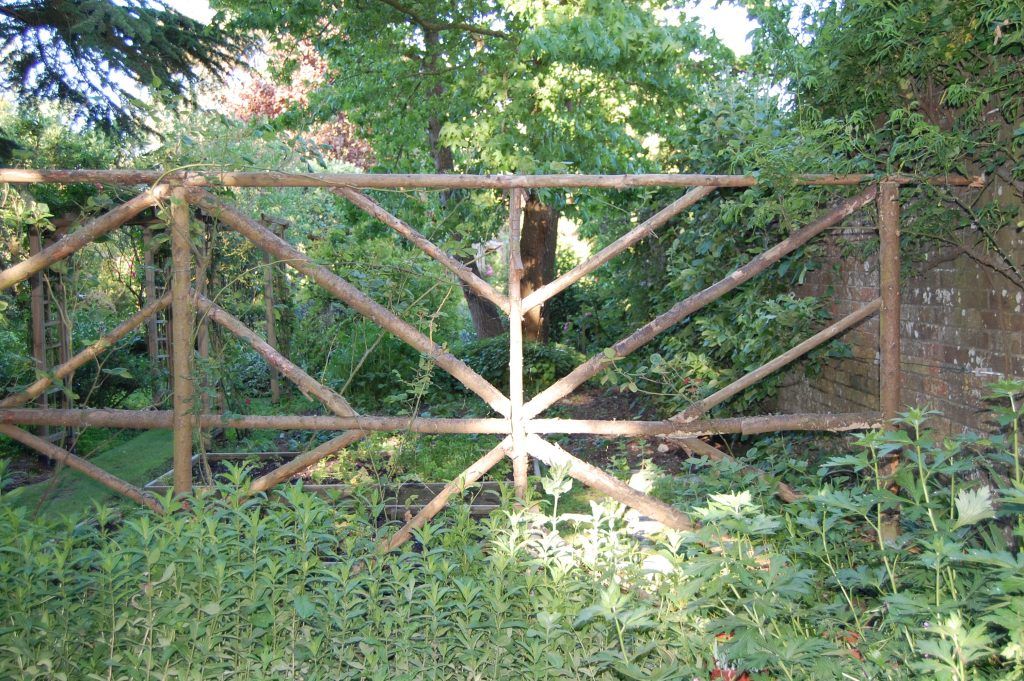
Stonework is the backbone of the Priory’s gardens. Below, a cast stone bench complements the stone walls and walkway.
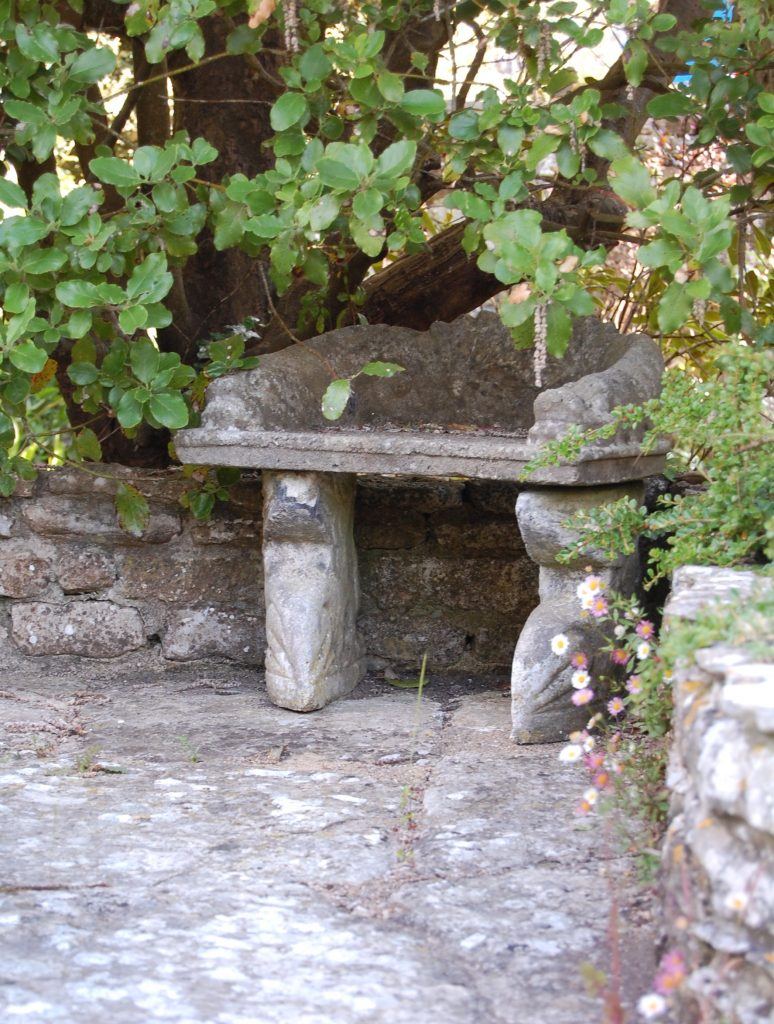
Roses cascade over the stone wall and arch, below.
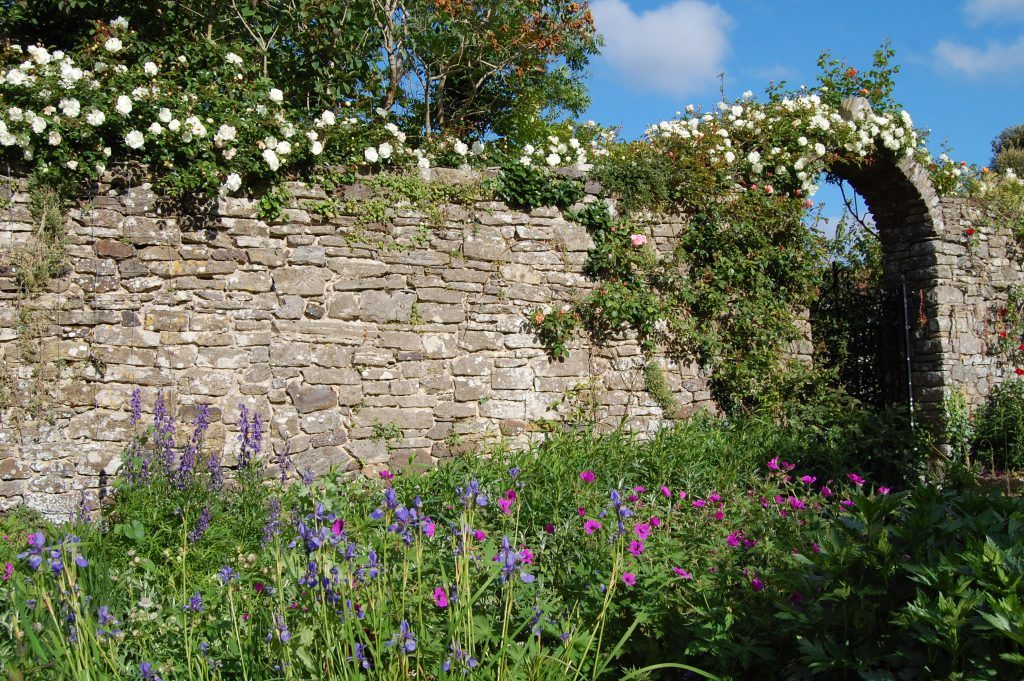
The Brits’ use of plant supports is practical and effective. Here, simple chicken wire supports sweet peas climbing a wall.
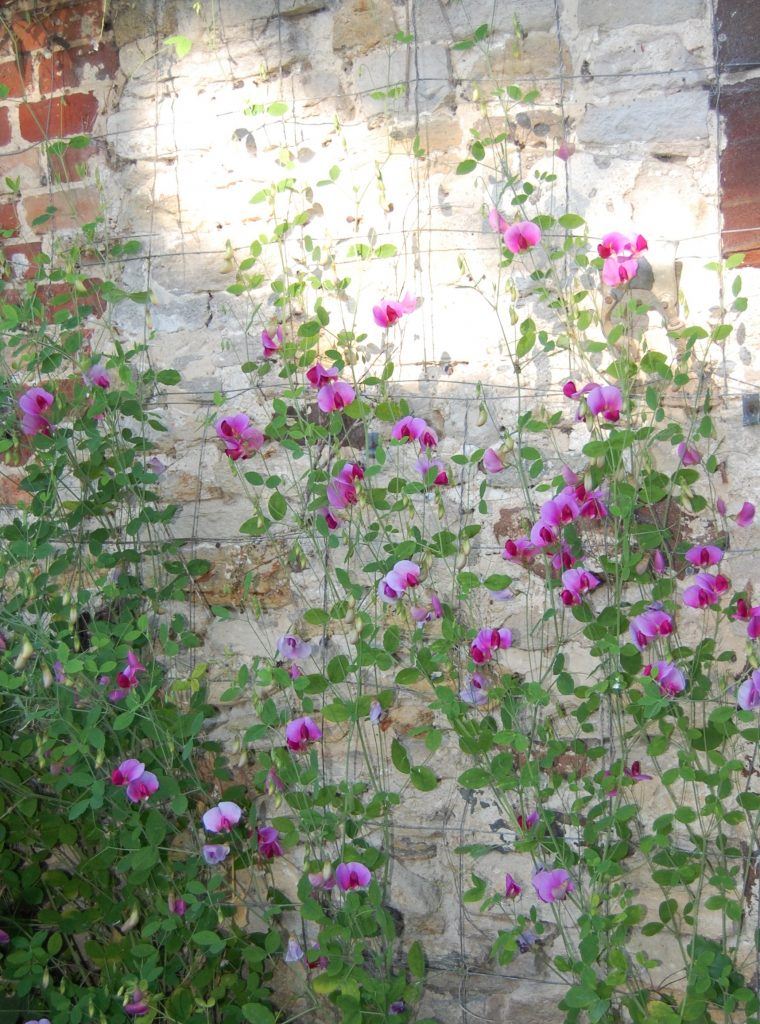
Water features are around every corner. This one is in a secret courtyard. The geometric stone pond and walkway are softened by pockets of perennials.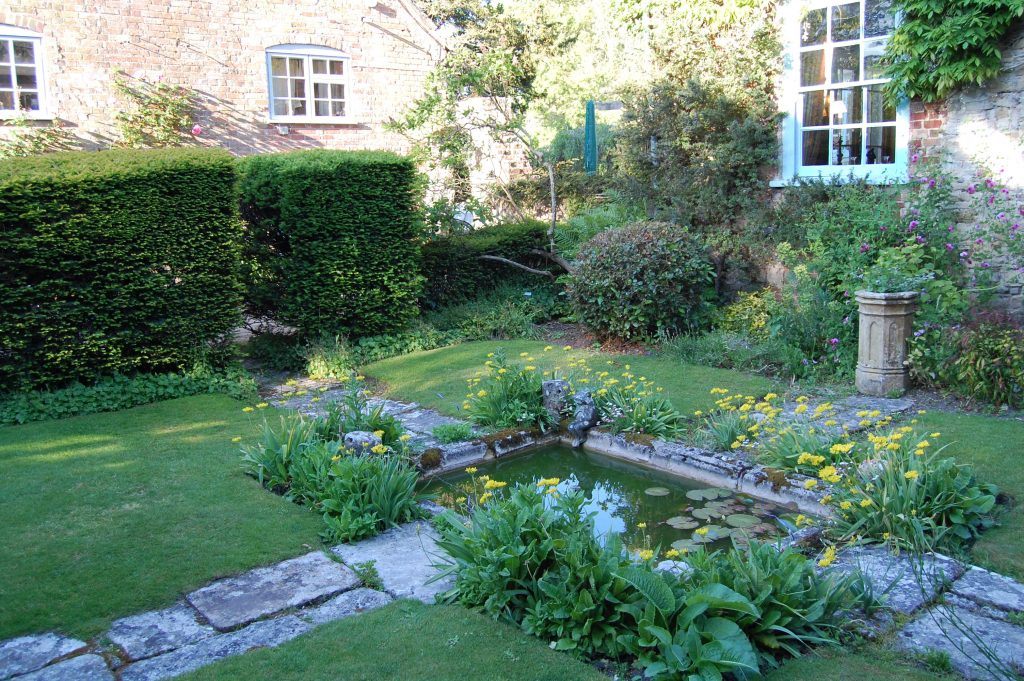
Even the garage (pardon, car park!) is charming.
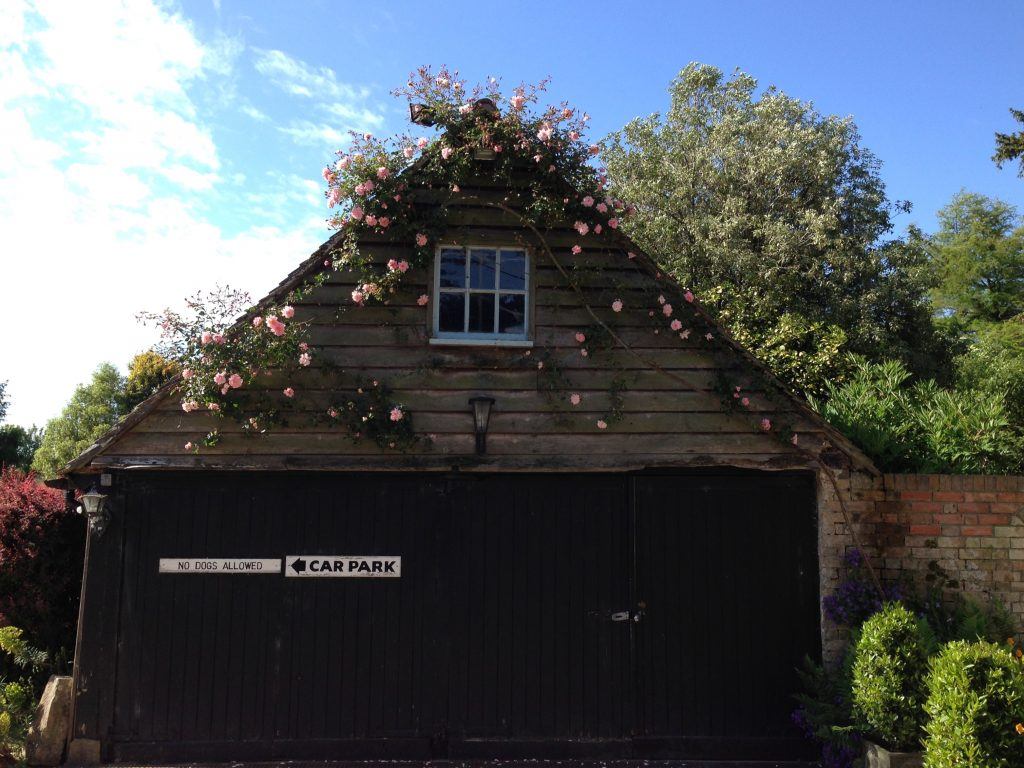
I could get used to poking my head out of this window every morning.
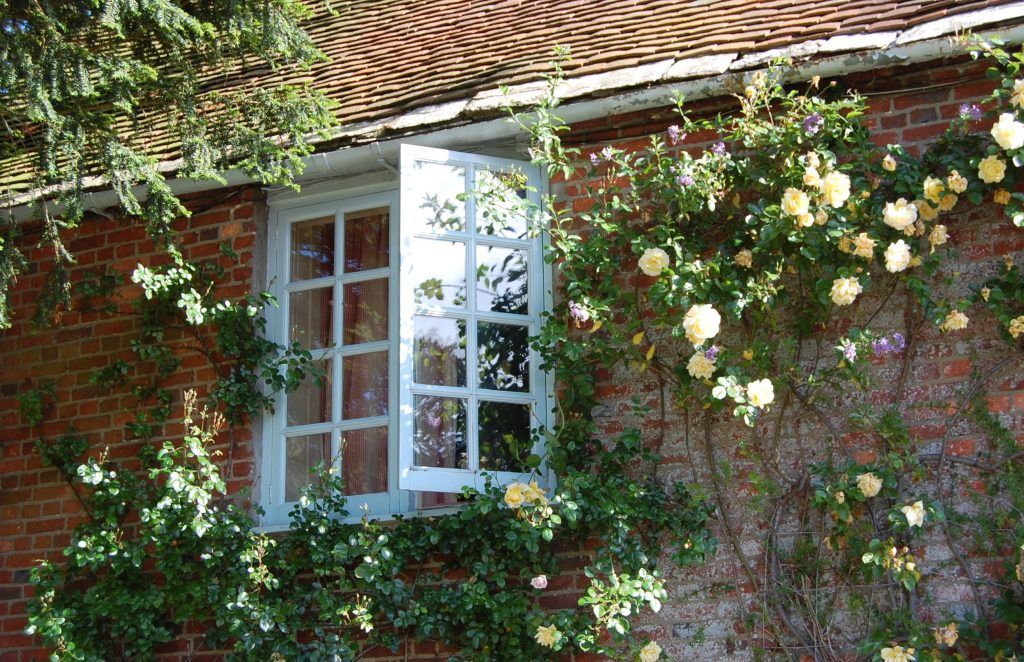
Perennial beds are enclosed by high evergreen hedges with arched entryways.
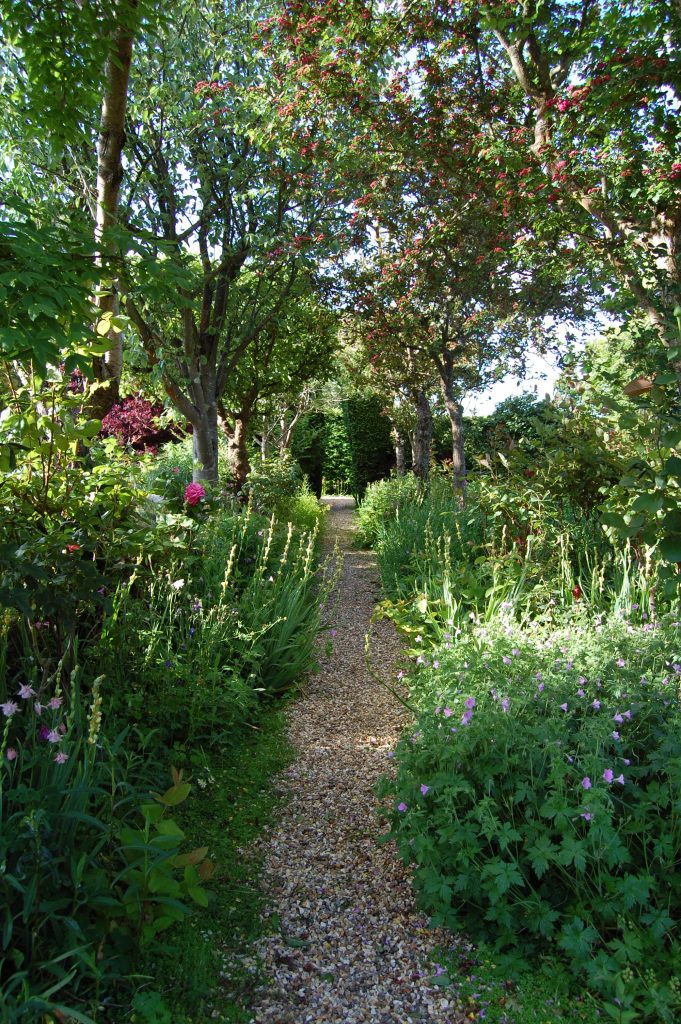
Other garden rooms are separated by stone retaining walls, with entrances defined by broad stone steps. We played a mean game of croquet on this lawn just before leaving (kicking and screaming).
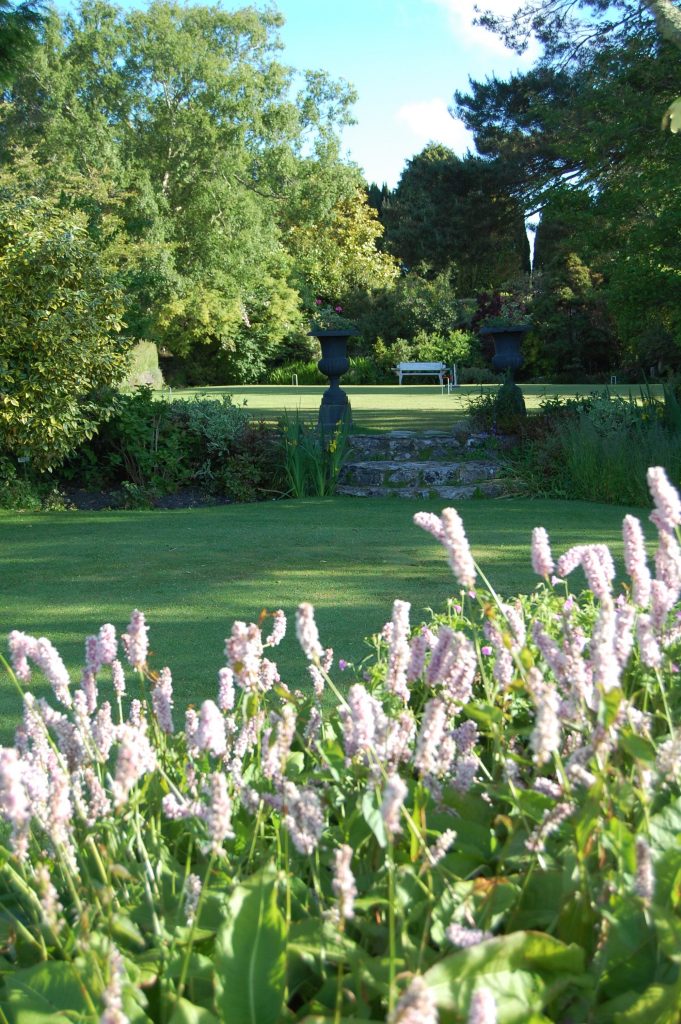
Calla lilies grow along the water’s edge.
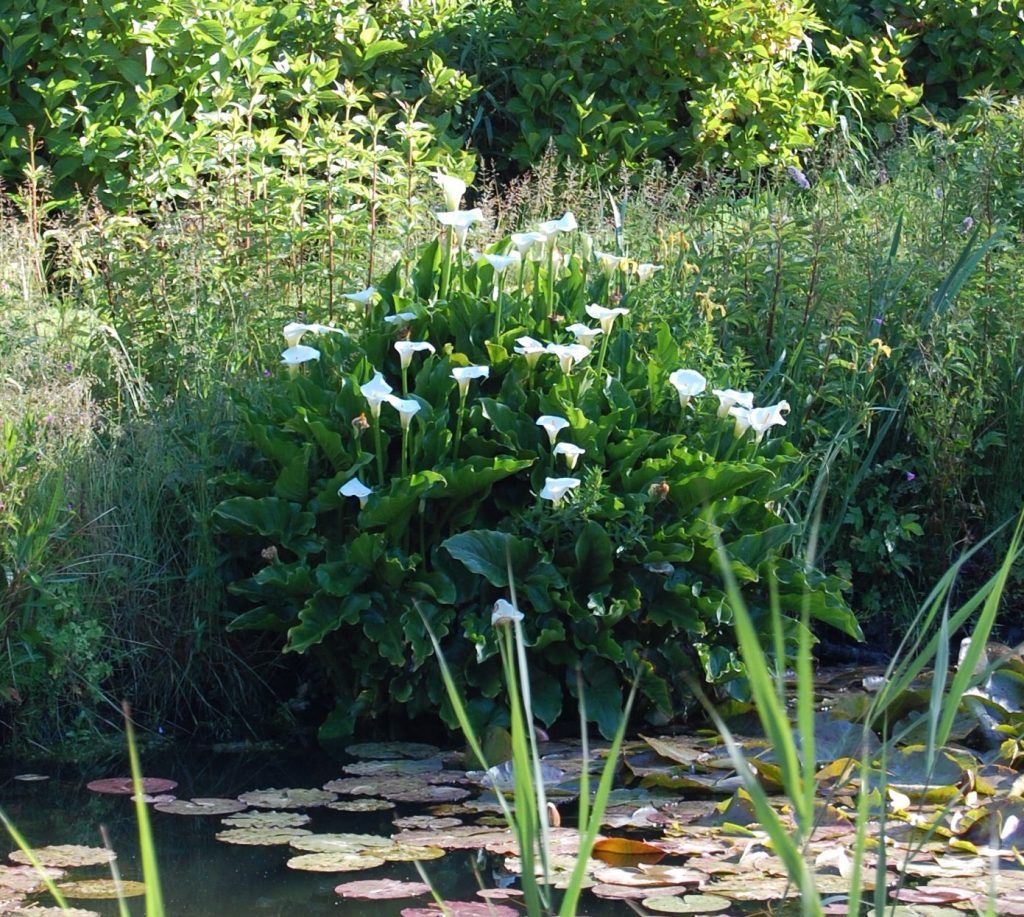
This staddle stone sits happily along the river, nestled near the ginormous leaves of gunnera.

Campanula scampers up the stone.

The gardeners stake the peonies with bamboo sticks and twine.
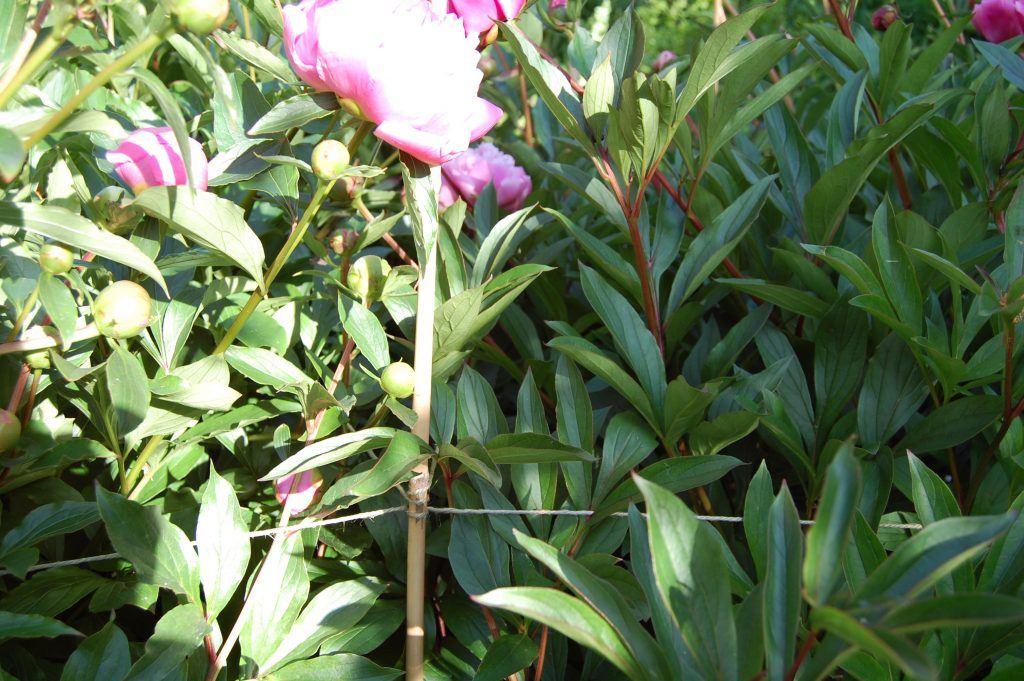
They take their composting seriously at the Priory!
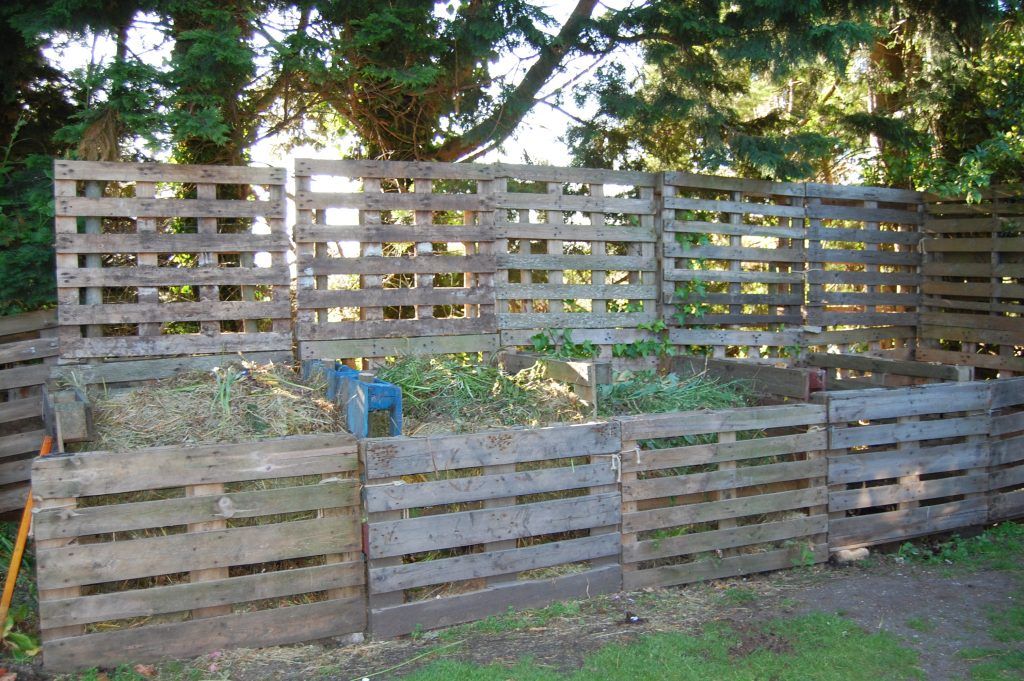
The Priory exemplifies English gardening at its best. A large expanse of property has been crafted into formally laid out rooms, made intimate and alluring through the use of rustic complementary materials and a rich and informal palette of plants.
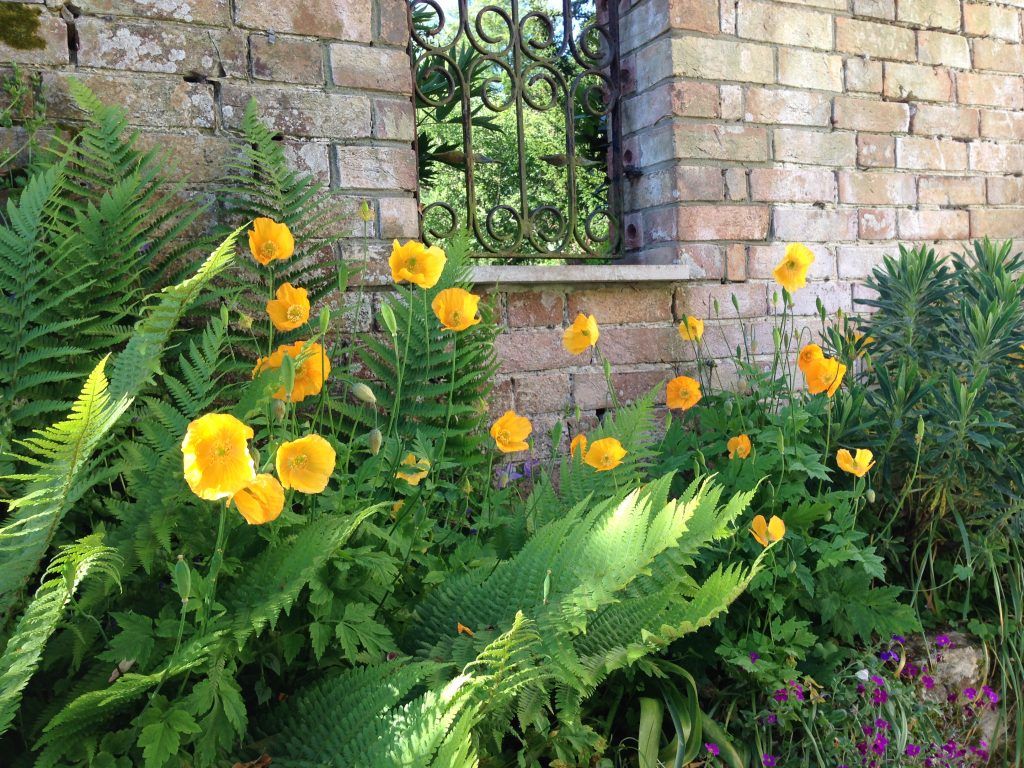
[custom-related-posts title=”Related Posts” none_text=”None found” order_by=”title” order=”ASC”]
SaveSaveSaveSaveSaveSaveSaveSaveSaveSaveSaveSaveSaveSave


